Some Knife Companies Make Better Knives for Self Defense and Critical Situations than Others
It should be all about function and mobility, but somehow the word “tactical” has become an aesthetic description more than anything.
These days when you search for “tactical” knives, you need to be careful that you don’t end up with something that was only designed to latch onto a demographic that just wants a vaguely military aesthetic and a spear point. So we decided to put together a list of the knives that we’ve tested enough to trust in actual emergencies.
During the process we realized that some brands make this kind of knife better across the board than most others, so we’ve organized this by brand in alphabetical order.
Here are Top Tactical Knife Picks
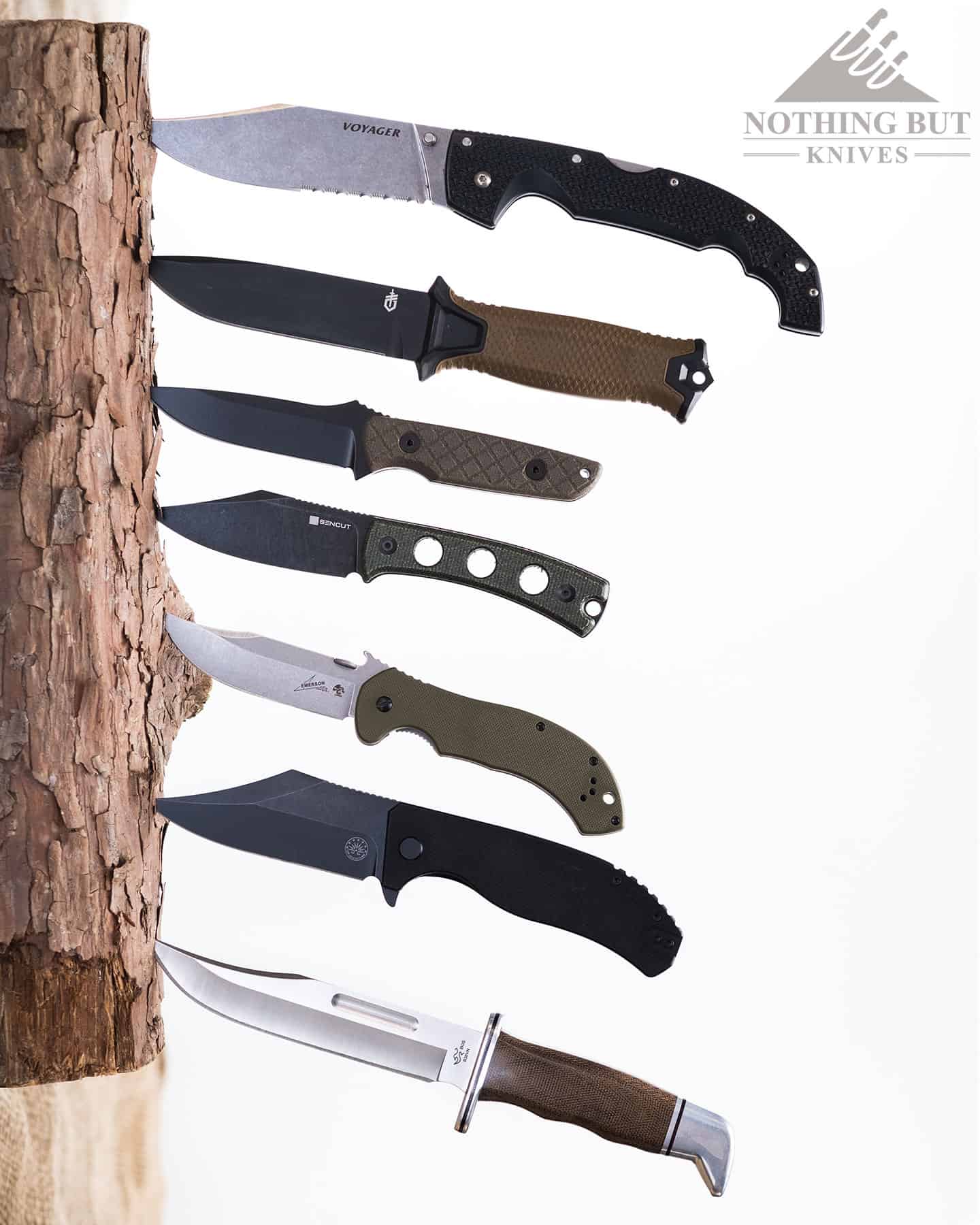
There are a lot of knives out there that look tactical because they’re over-built with camo scales slapped on, but once you get them in a situation where you need to cut rope in a hurry they turn out to be loose pry bars. Meanwhile there are plenty of knife companies out there that put a lot of thought into their tactical designs, making a tool that is genuinely useful in a variety of emergency situations not exclusive to just “fighting”.
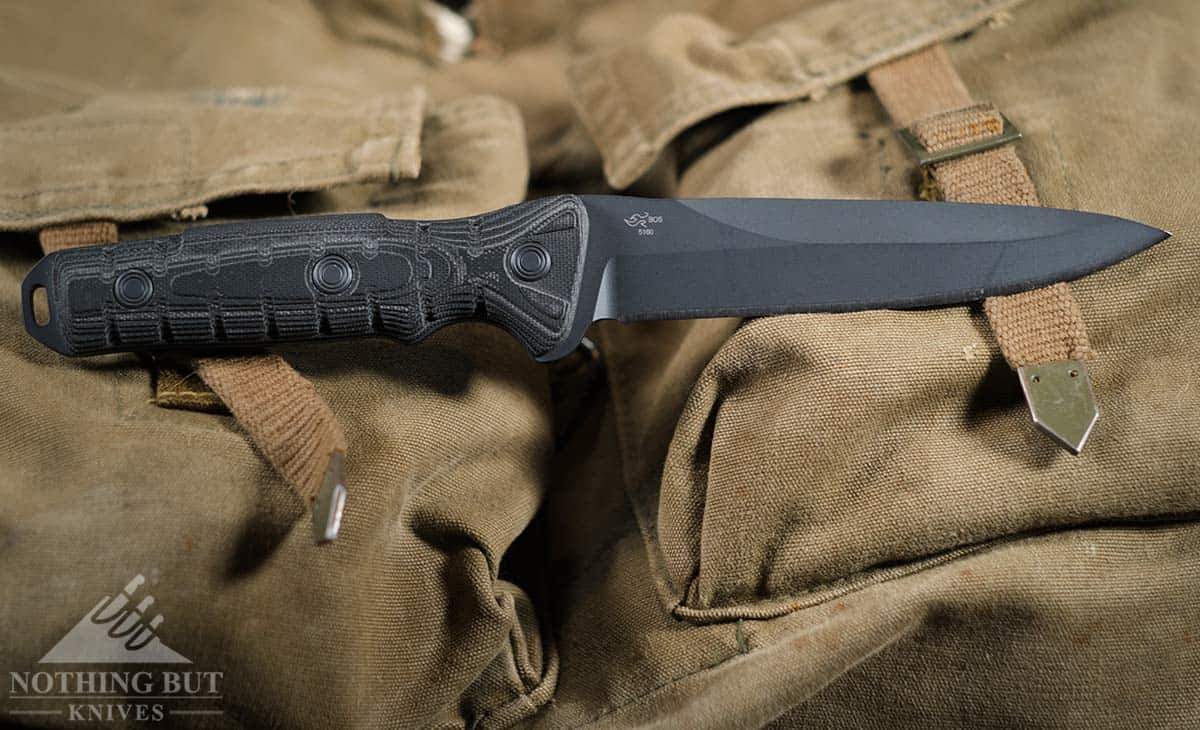
We’ve written before about what to look for in a tactical knife so I won’t dig into it too much again here. Basically you want tough, comfortable and grippy, with quick deployment, to say nothing of knowing what “tactical” situation you’re preparing for in the first place.
Buck
Buck is not really well known for their tactical knives. They built their reputation on hunting and EDC knives, but when they decide to go tactical they generally do a pretty stellar job at it. Weirdly one of our favorite tactical knives to come out of Buck (the GCK) was discontinued, but it was a great example of how Buck’s rustic and robust approach to designing can do great things in this category.
Buck 119 Special Pro
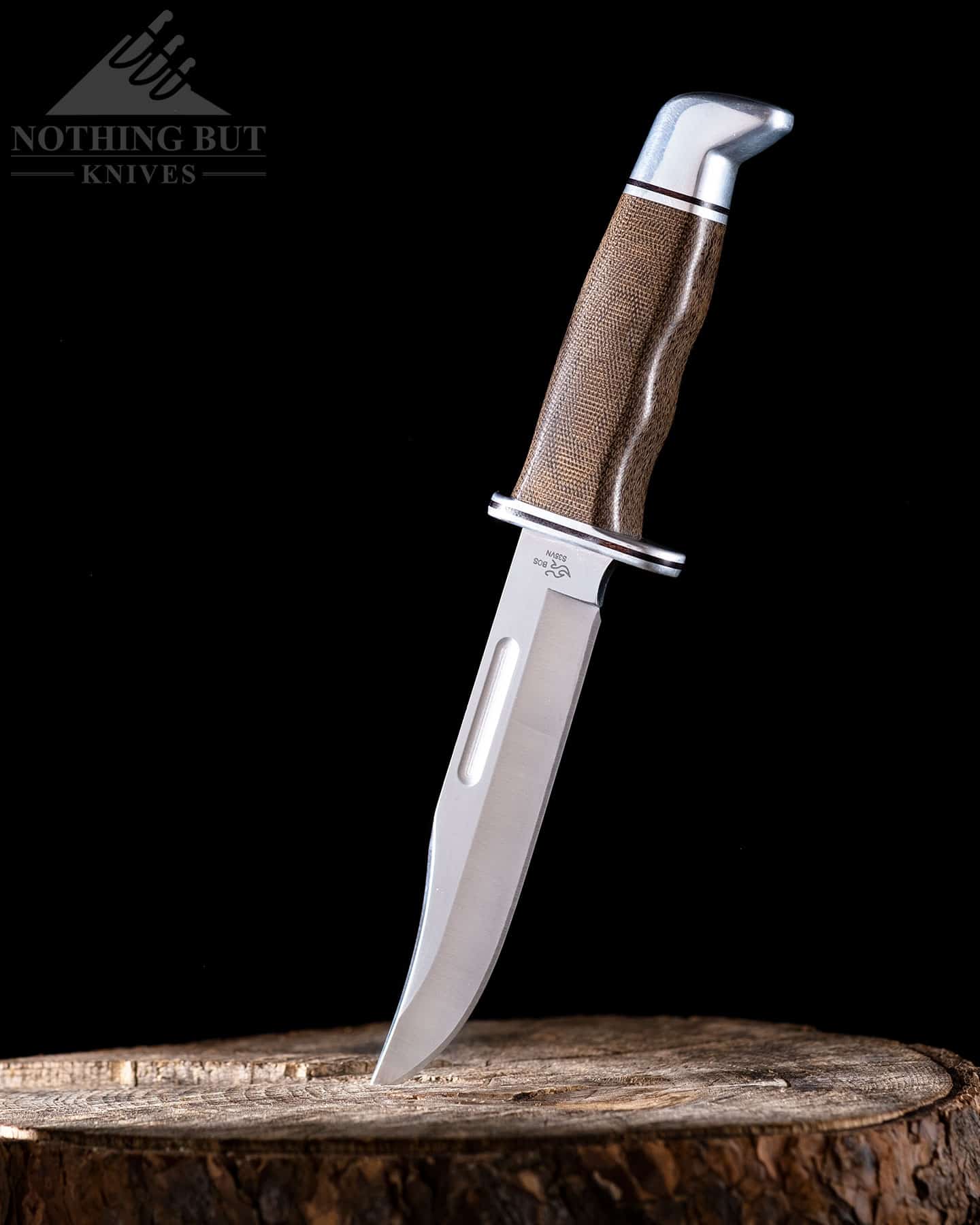
Specifications
| Overall Length: | 10.25″ |
| Blade Length: | 5.75″ |
| Blade Shape: | Clip point |
| Steel: | S35VN |
| Handle Length: | 4.5″ |
| Handle Material: | Micarta |
| Grind: | Hollow |
| Build: | Full tang fixed blade |
| Sheath: | Leather |
Over the sixty or so years since the Buck 119 first came out, it’s become popular with hunters and military personnel.
It’s also one of the more common designs to pop up in movies anytime someone is supposed to have a big scary knife, and I’d say that’s good casting, considering the size and the edge on this thing.
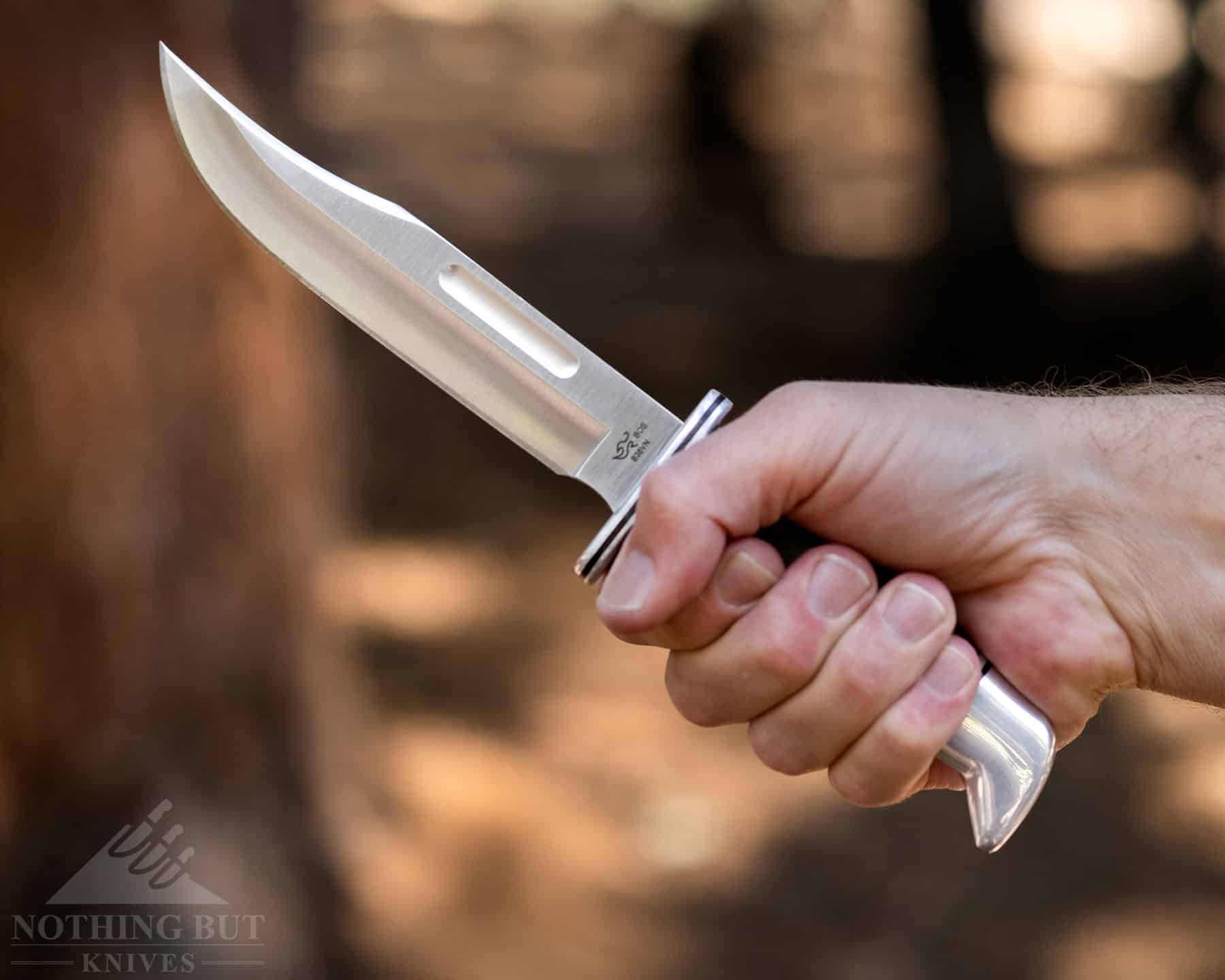
While it’s not what you would call a subtle carry, the size of the 119 is pretty damn handy for keeping distance, and the thin hollow grind and severe clip point are both well established hallmarks of effective, high-intensity activity. Stack that with a steel guard that actually provides decent coverage and you’ve got a pretty formidable tool for emergencies.
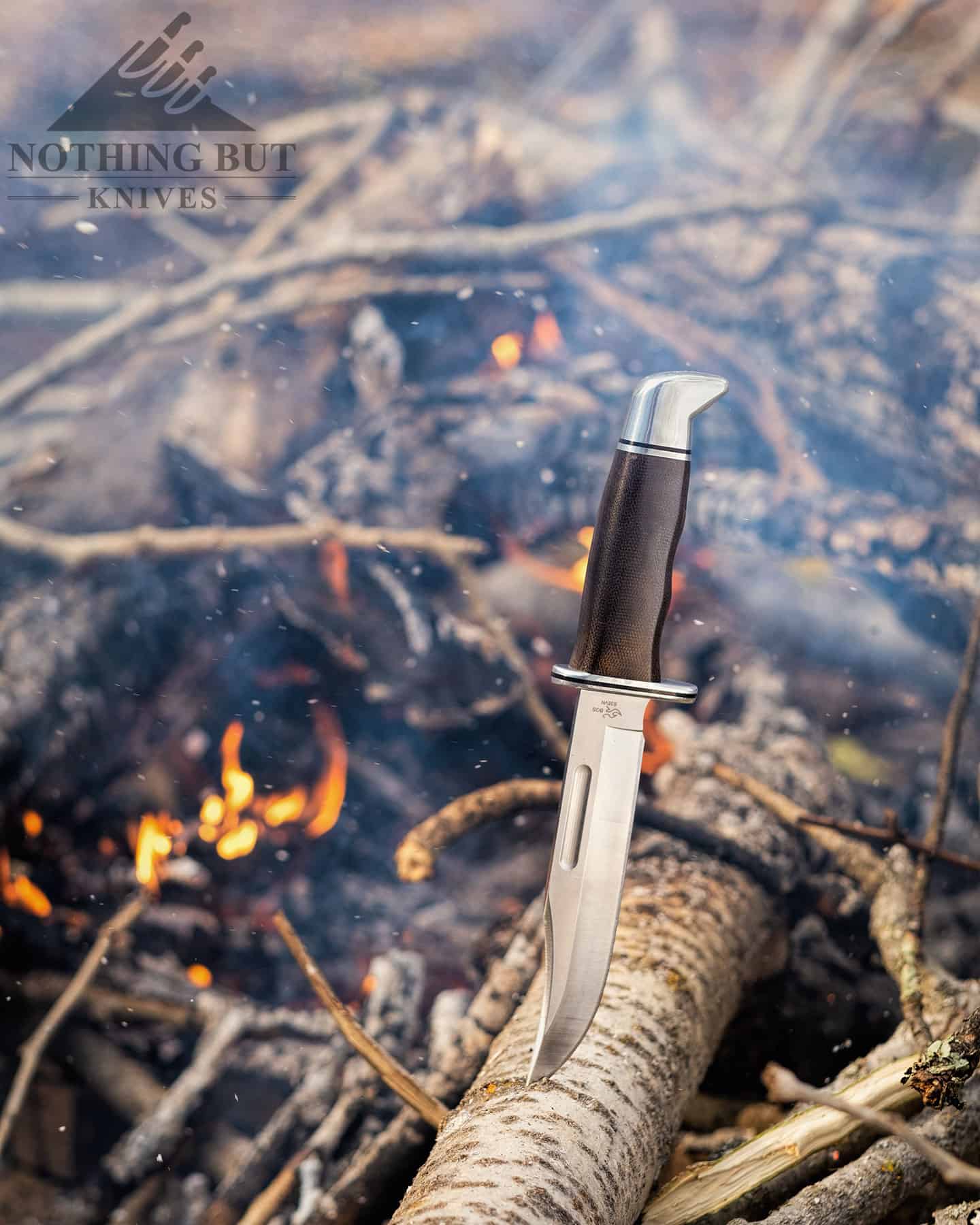
The only thing I don’t like about the 119 Special Pro for tactical use is the smoothness of the handle, and the S35VN steel upgrade is likely a downgrade in toughness from the BOS 420HC of the original.
But a bit of sandpaper can add some texture to the handle, and if nothing else the blade is very sharp and has some great corrosion and wear resistance.
Buck Sprint Pro
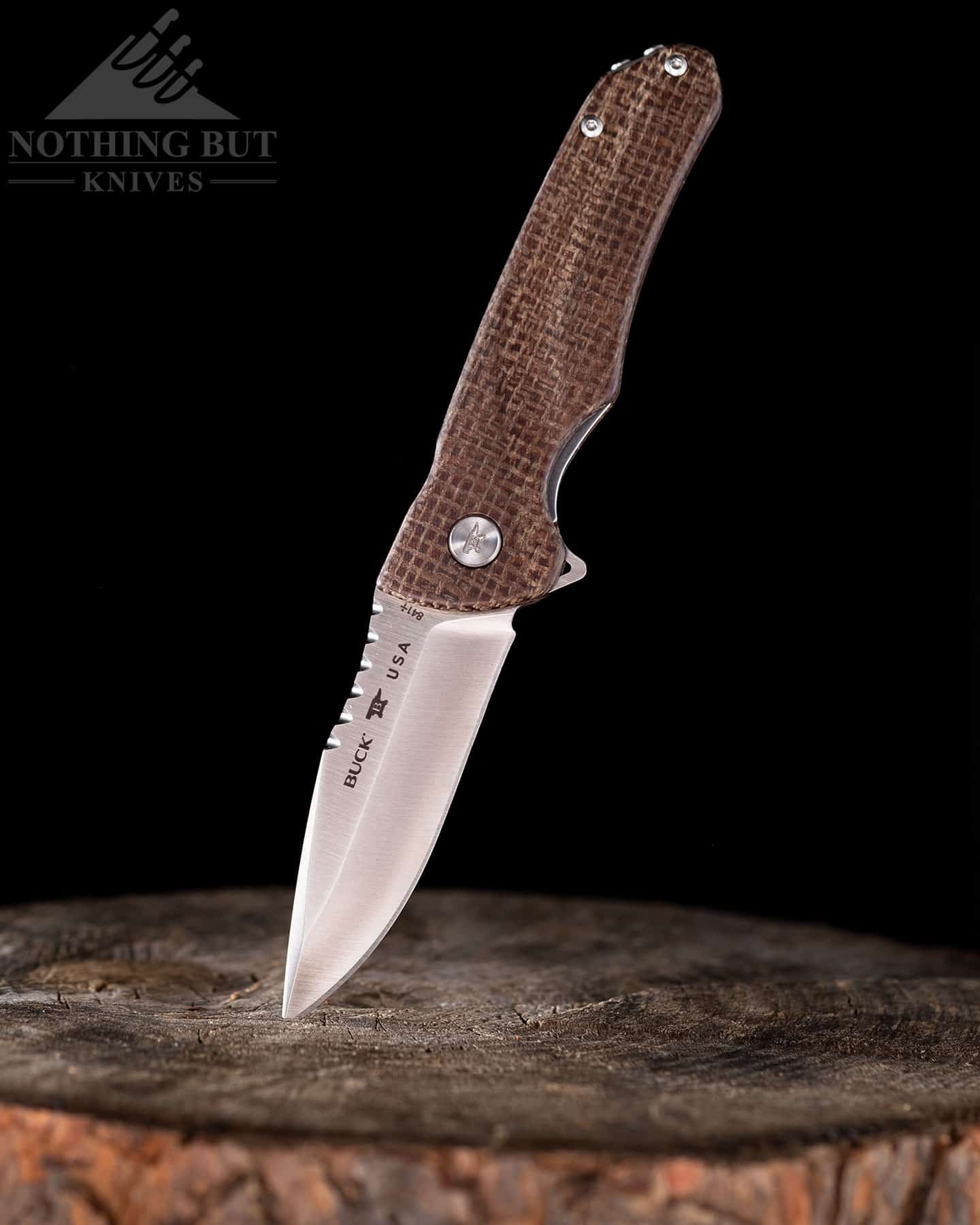
| Overall Length: | 7.5” |
| Blade Length: | 3.125” |
| Blade Shape: | Clip point |
| Steel: | S30V |
| Handle Length: | 4.375” |
| Handle Material: | Burlap Micarta |
| Grind: | Hollow |
| Build: | AO folder |
| Carry type: | Pocket clip (tip up, right handed) |
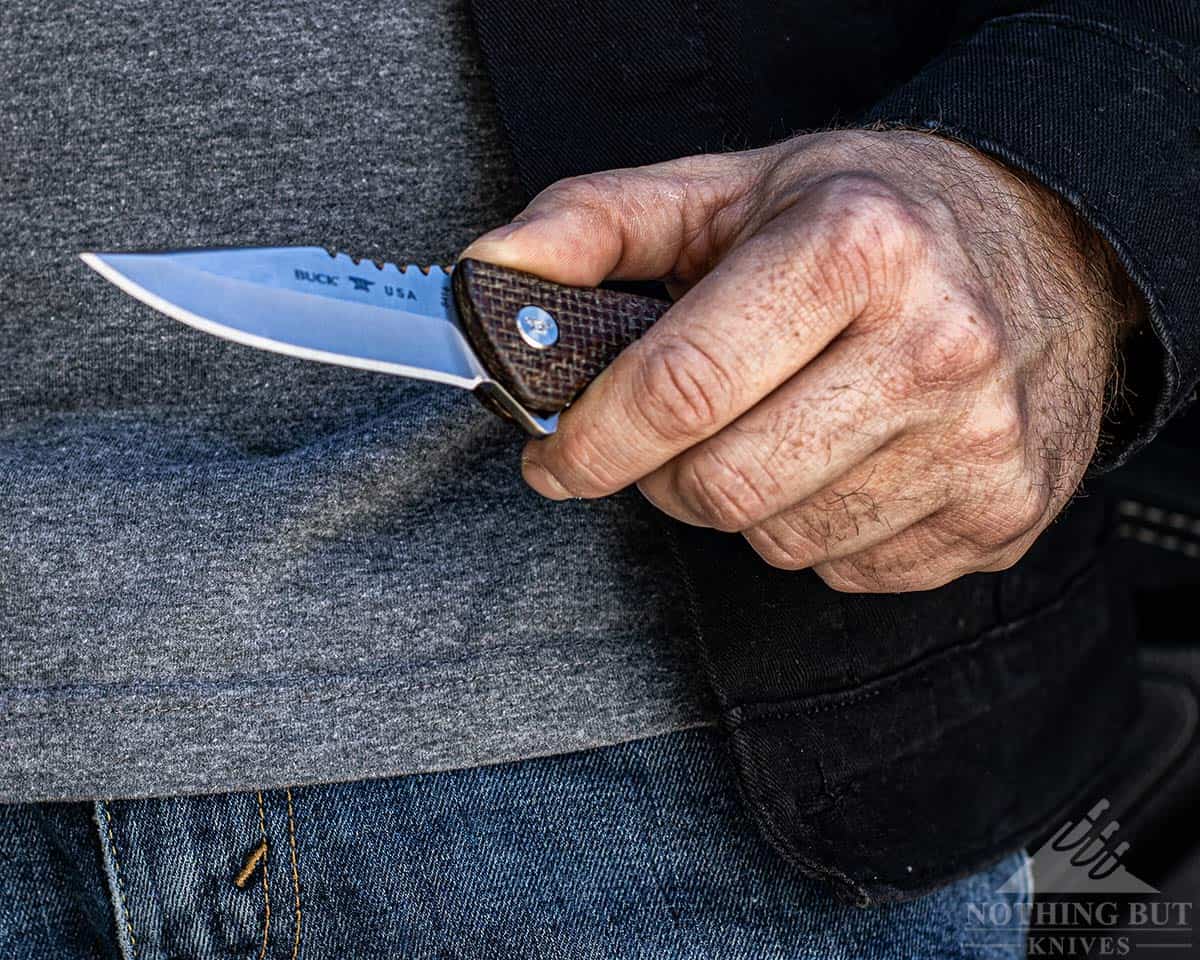
The classification of the Sprint Pro as a tactical knife is a lot more about how easily it carries in the pocket and how good the grip is from the Micarta handle and all the jimping. This is a tough knife in spite of the S30V steel and the assisted open mechanism. Don’t let the saw-like jimping on the spine fool you. The knife isn’t as ridiculous as it looks.
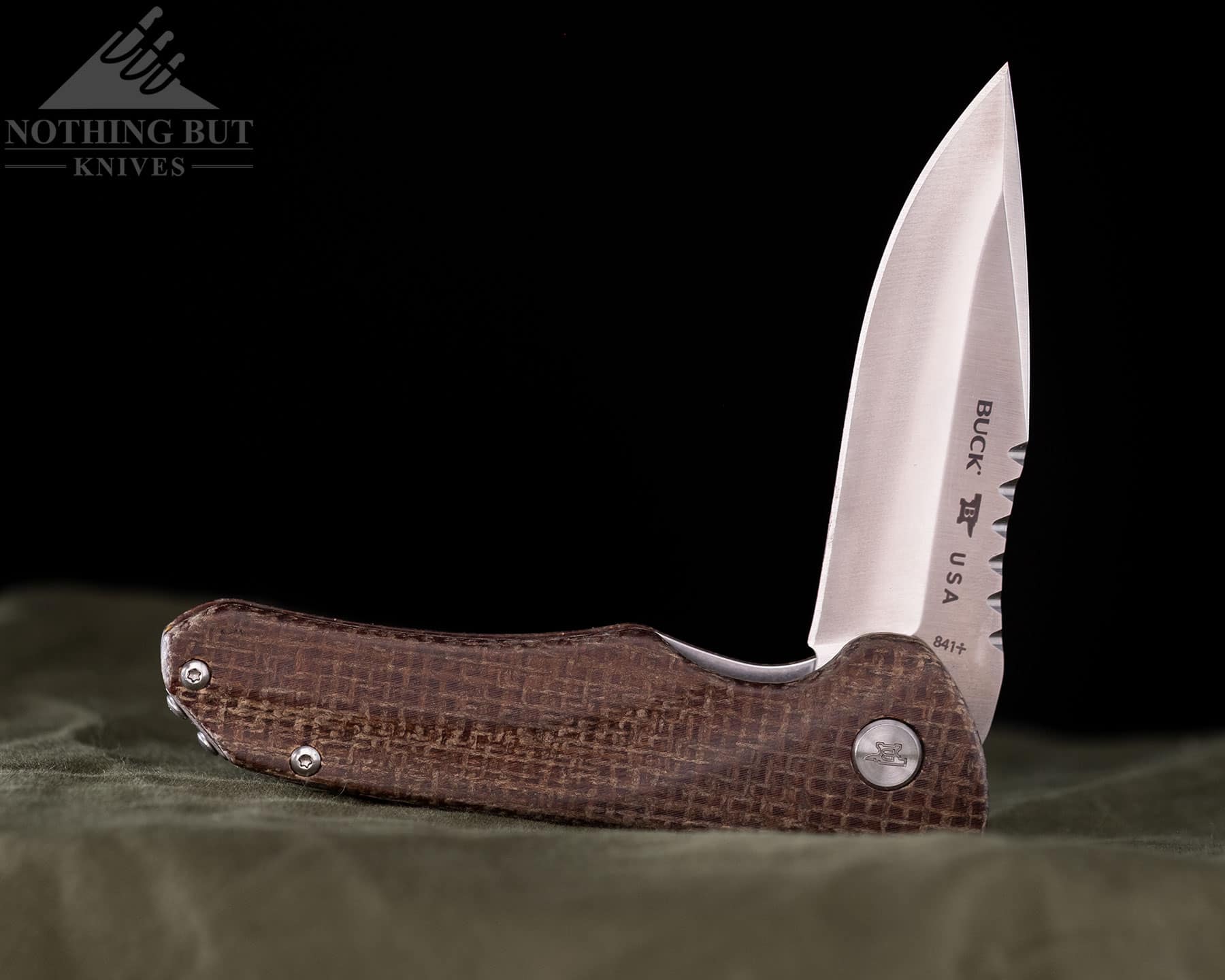
As Micarta folders go, this is pretty light and rides really well in the pocket on a deep-carry clip. The handle manages to fill the hand well to give you a good, secure grip. With a little bit of practice, you should be able to get this mean little slicer out of your pocket and ready in hand pretty quickly.
Buck also put an aggressive hollow grind on this that is very sharp out of the box.
We wrote an in-depth review of the Buck Sprint Pro if you want to do a bit more reading before making a decision on your next tactical knife.
Cold Steel
| Pros: Grippy handles and tough builds. |
| Cons: Tendency to make knives heavy and overbuilt. |
Cold Steel made itself famous with tough builds and over-the-top destruction and performance videos that maybe half of us like better than we admit. They use some of the best handle materials for tactical knives that I see on a regular basis. Often the steel is tough too, but I can always count on the handles to give me a good feeling of control even when the balance isn’t so great.
Cold Steel Mini Tac
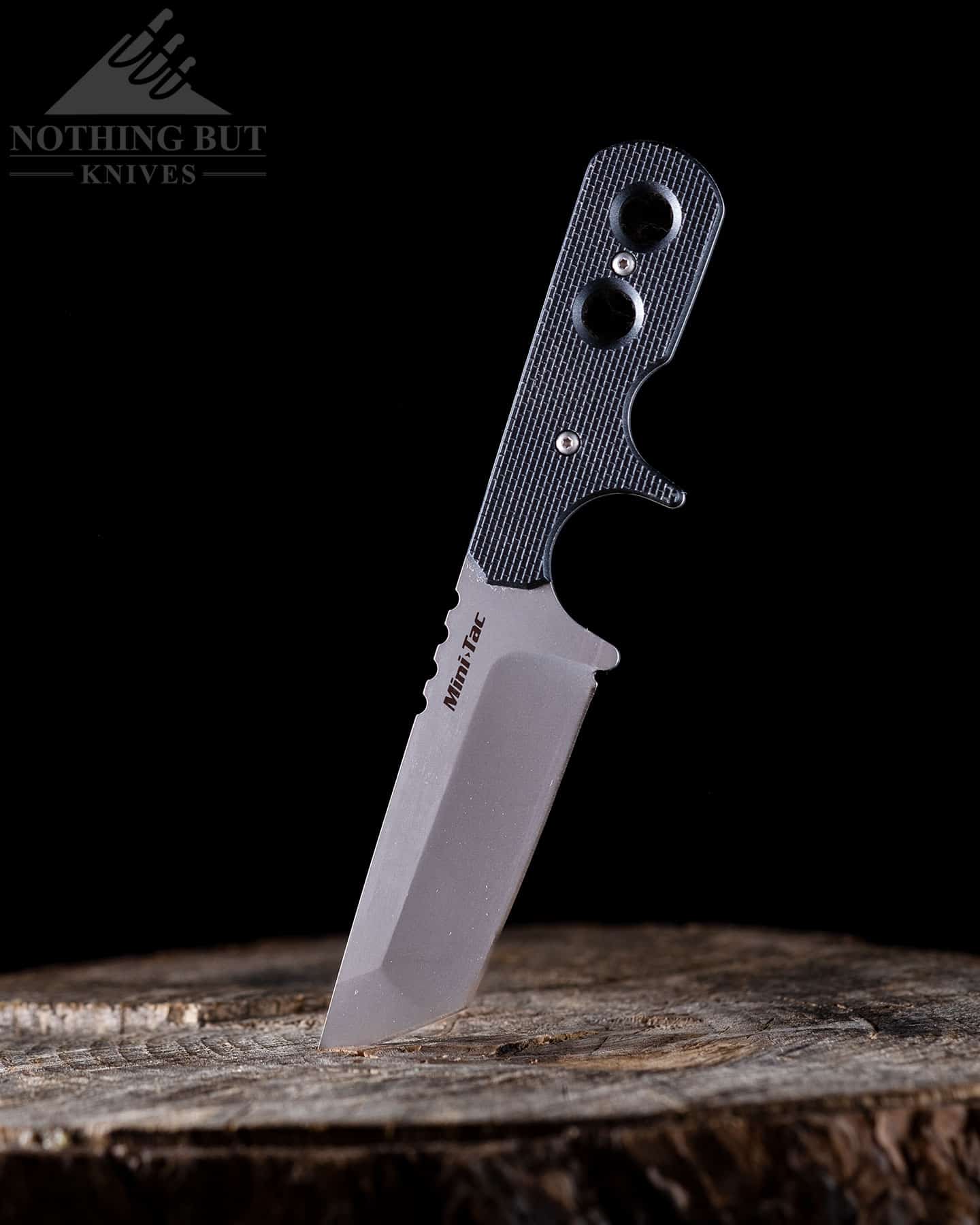
| Overall Length: | 6.75” |
| Blade Length: | 3.75” |
| Blade Shape: | Tanto |
| Steel: | AUS-8A |
| Handle Length: | 3.0” |
| Handle Material: | Polymer |
| Grind: | Flat |
| Build: | Fixed blade |
| Carry type: | Kydex (loose or neck) |
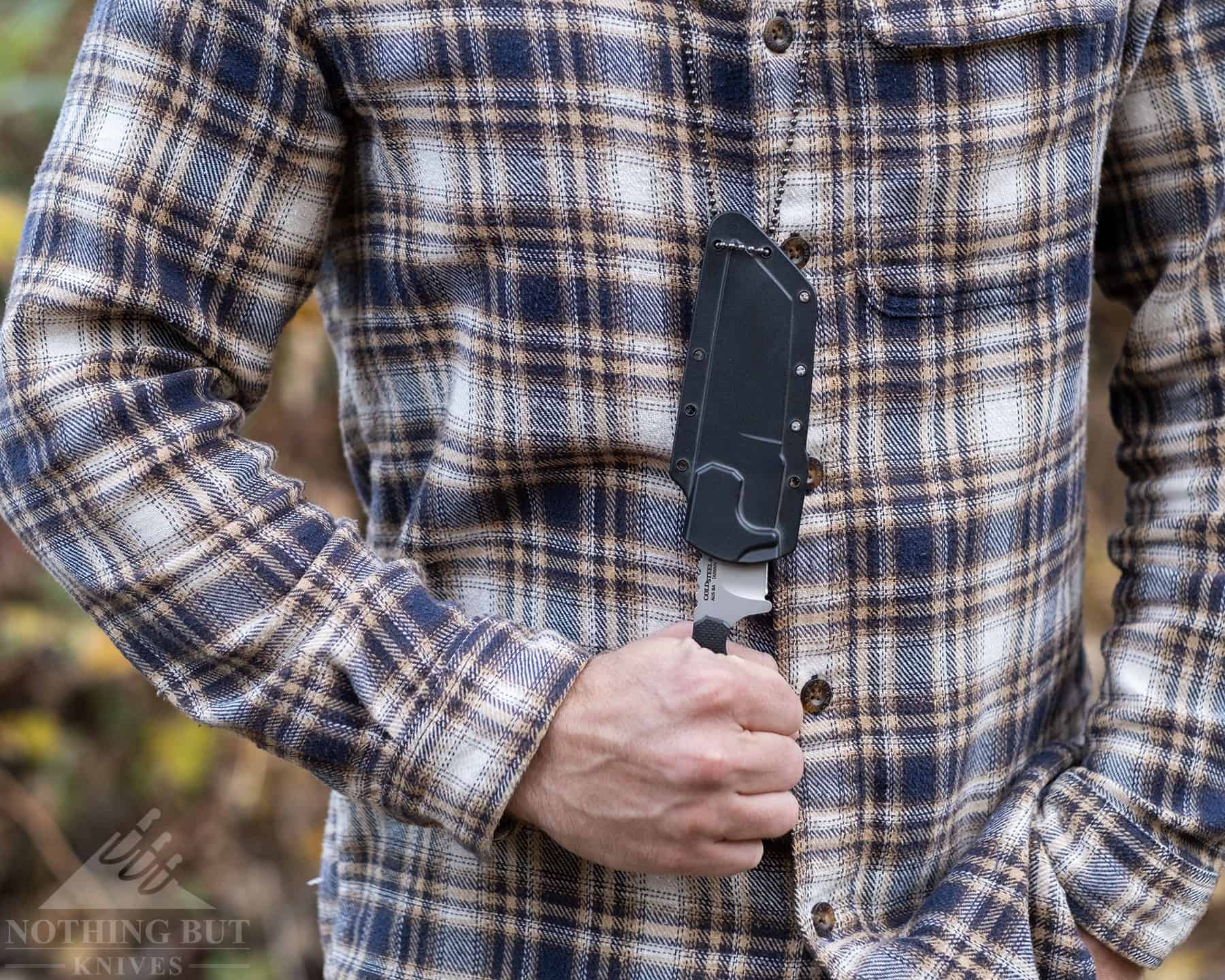
This quick little thing feels a lot bigger than actually is. In this case that’s a good thing. It has a lot of grip for a neck knife and a soft steel that can take a screaming edge (although you will have to doctor that edge up a lot).
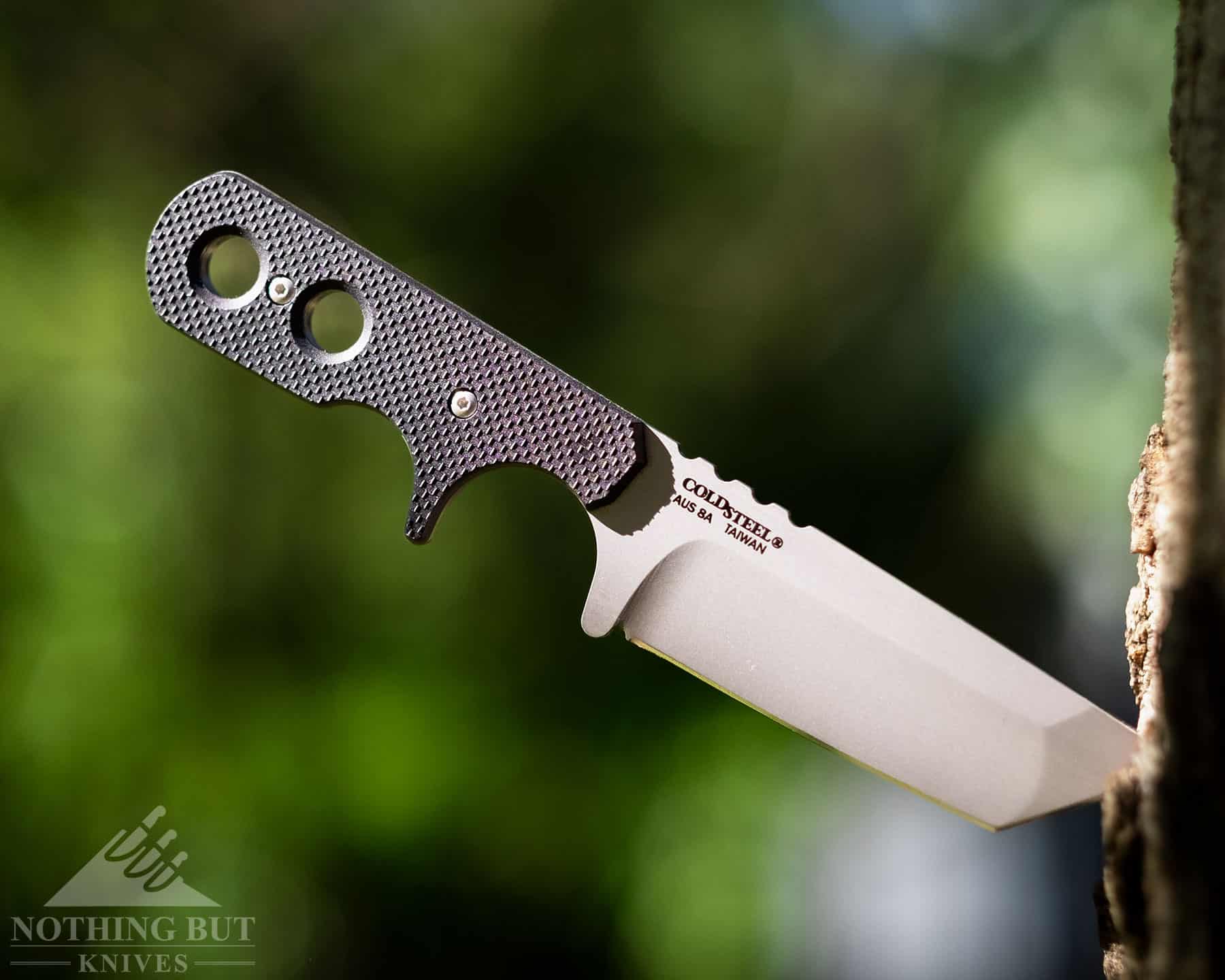
As much as I’m generally opposed to deep finger choils, much less the halfway finger ring that’s on this knife, it actually works in this design.
The finger falls pretty naturally into the right spot after drawing the knife, and the handle is shaped well enough that this almost feels like it has push-dagger ergonomics. It turns out to be a good solution to prevent stubbing rather than an interference.
You can check out our full review of the Mini Tac if you’d like to see more.
Cold Steel SRK
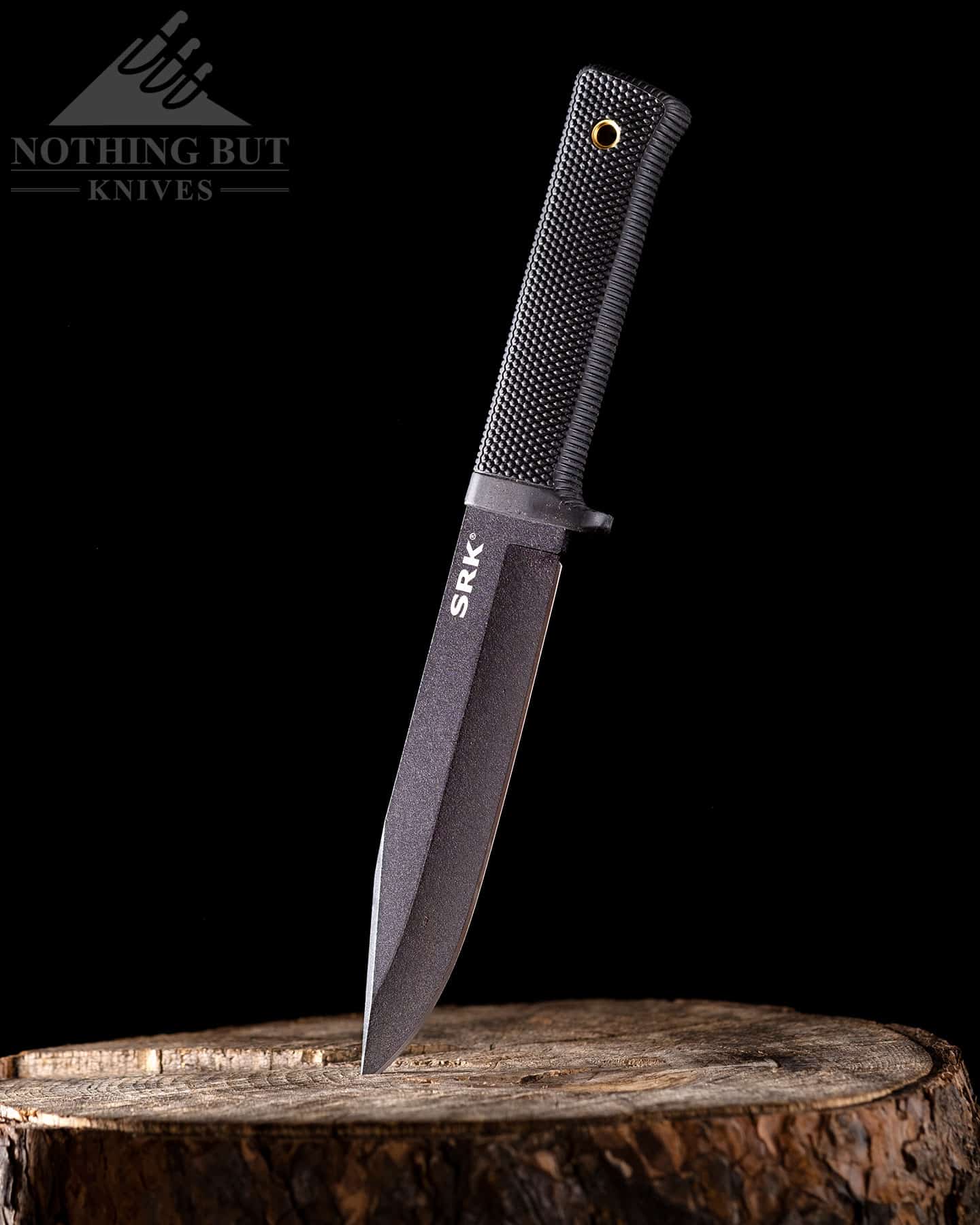
| Overall Length: | 10.75” |
| Blade Length: | 6.0” |
| Blade Shape: | Clip point |
| Steel: | SK-5 |
| Handle Length: | 4.75” |
| Handle Material: | Kray-Ex polymer |
| Grind: | Flat |
| Build: | Fixed blade |
| Carry type: | Kydex (vertical) |
It’s hard to find a knife that’s more unequivocally “tactical” by almost any definition of the word.
It’s a long clip point blade with a rubbery handle slapped into a tight-fitting Kydex sheath. It’s even got a black finish on the blade for all the people inexplicably concerned about the sun (and for all the people who actually need to worry about something like that).
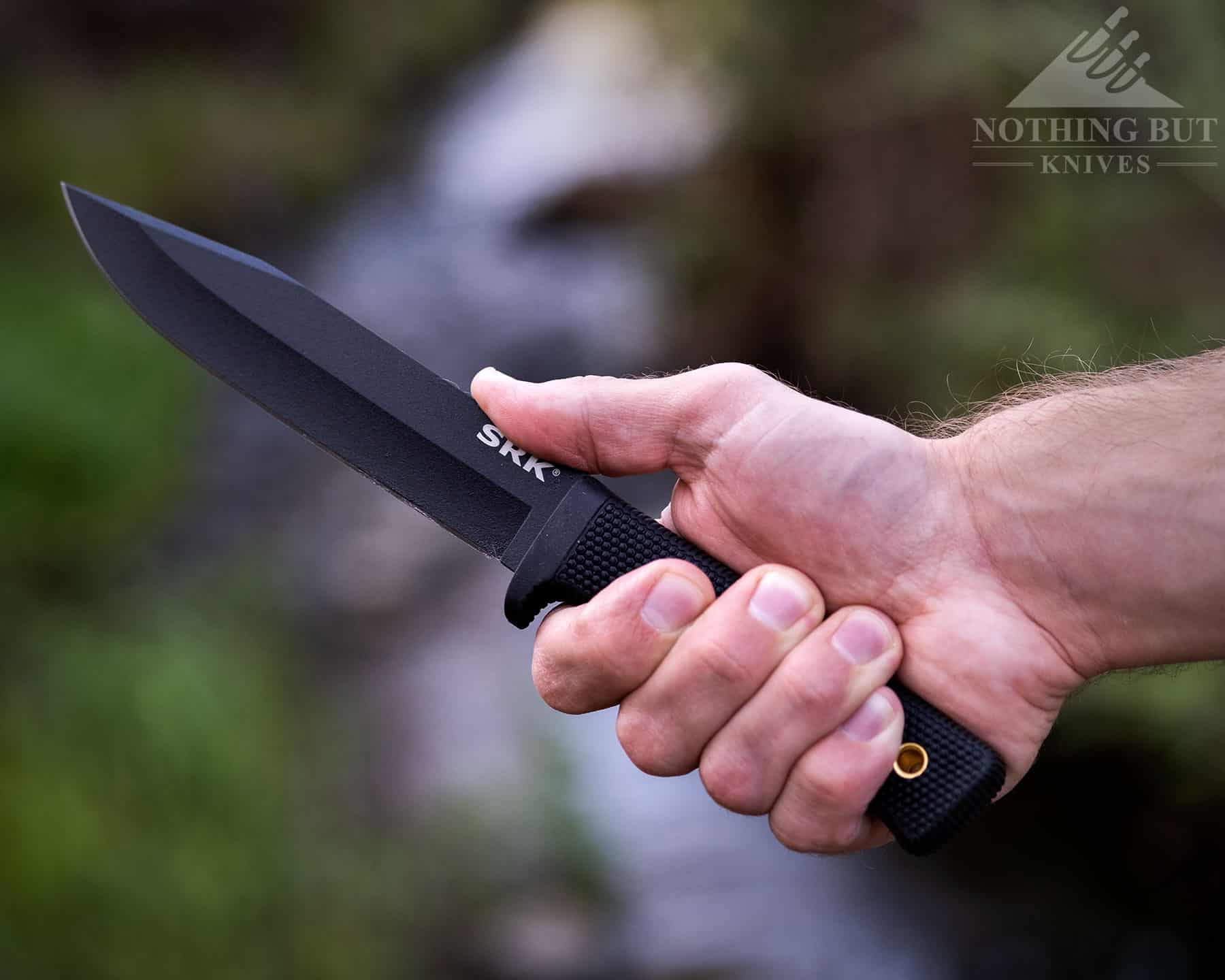
The black coating, in this case, is really more to protect the tool steel of the blade than to make the knife anything close to “sneaky”, though. SK-5 steel is good stuff but it has very little corrosion resistance on its own.
Cold Steel has really optimized this design to last. Dig a whole with it, climb through some mud and brush, use it as a pry bar, and fight a damn bear for all the SRK cares. It will likely end up in better condition than you.
The only point of warning I have is that the sheath is a little too good at keeping the knife in place. I often have to tug pretty hard to get the knife out. That’s partly because that grippy handle material is also grippy on the sheath, and partly because the retention of the sheath itself might be molded just a little too tight.
The bright side is that the knife won’t slip out on its own, but I would recommend spending a little time drawing it until you’re comfortable with how much pressure you need to deploy the thing quickly.
Cold Steel Razor Tek
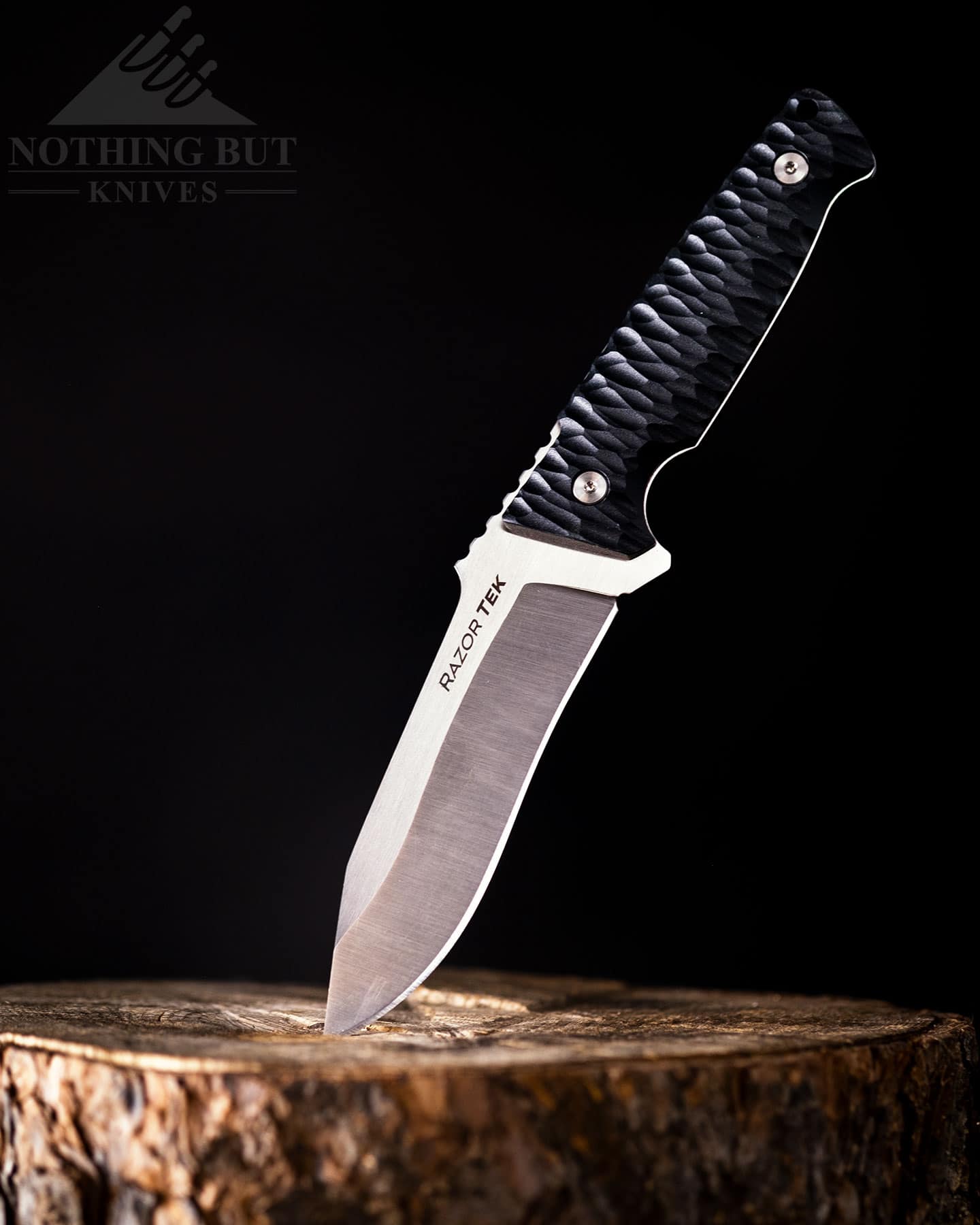
| Overall Length: | 9.65” |
| Blade Length: | 5.0” |
| Blade Shape: | Drop point |
| Steel: | 4116 |
| Handle Length: | 4.9” |
| Handle Material: | Polymer |
| Grind: | Flat |
| Build: | Fixed blade |
| Carry type: | Polymer sheath (vertical) |
The lines of the 5-inch Razor Tek are solid. It has a thick blade with a deep recurve and a strong tip. This knife gets a lot of work done. It’s made up of fairly tough steel on a tall and thick blade, so there’s an enormous potential for abuse and easy maintenance in the long term for a pretty reasonable price.
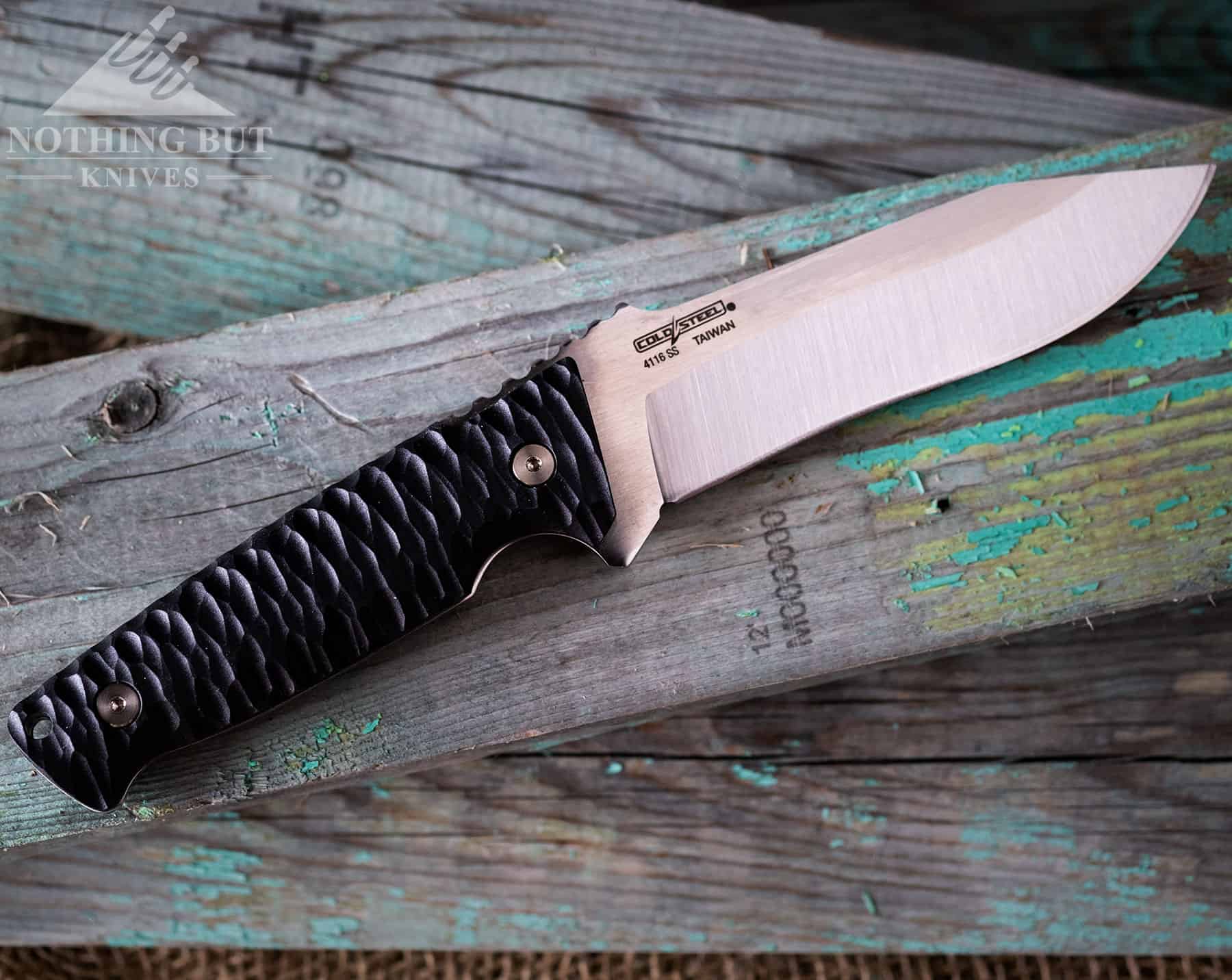
The scales feel a little slippery to me. Cold Steel created a texture on the handle, but they did it by creating a lot of “fold” shapes in the material. The overall feeling of that texturing is still very smooth, which isn’t ideal, but there’s also some aggressive jimping that helps keep the hand in place.
CRKT
| Pros: A lot of really unique designs by really good designers. |
| Cons: Hit or miss manufacturing. |
CRKT is like a big dark pond in the middle of a mountain creek: you’re never really sure what you’re getting into, but you’re pretty sure it’s going to be fun. Their philosophy is geared more toward quantity than quality (although that has changed slightly since they started releasing USA-made designs in 2023), so they’ve gathered an army of designers over the years, and they seem to tell each and every one of them “just go crazy, we’ll figure out how to make it right later”.
For all the problems this kind of process can create, they have definitely come out with some pretty incredible tactical designs as a result.
CRKT Ramadi
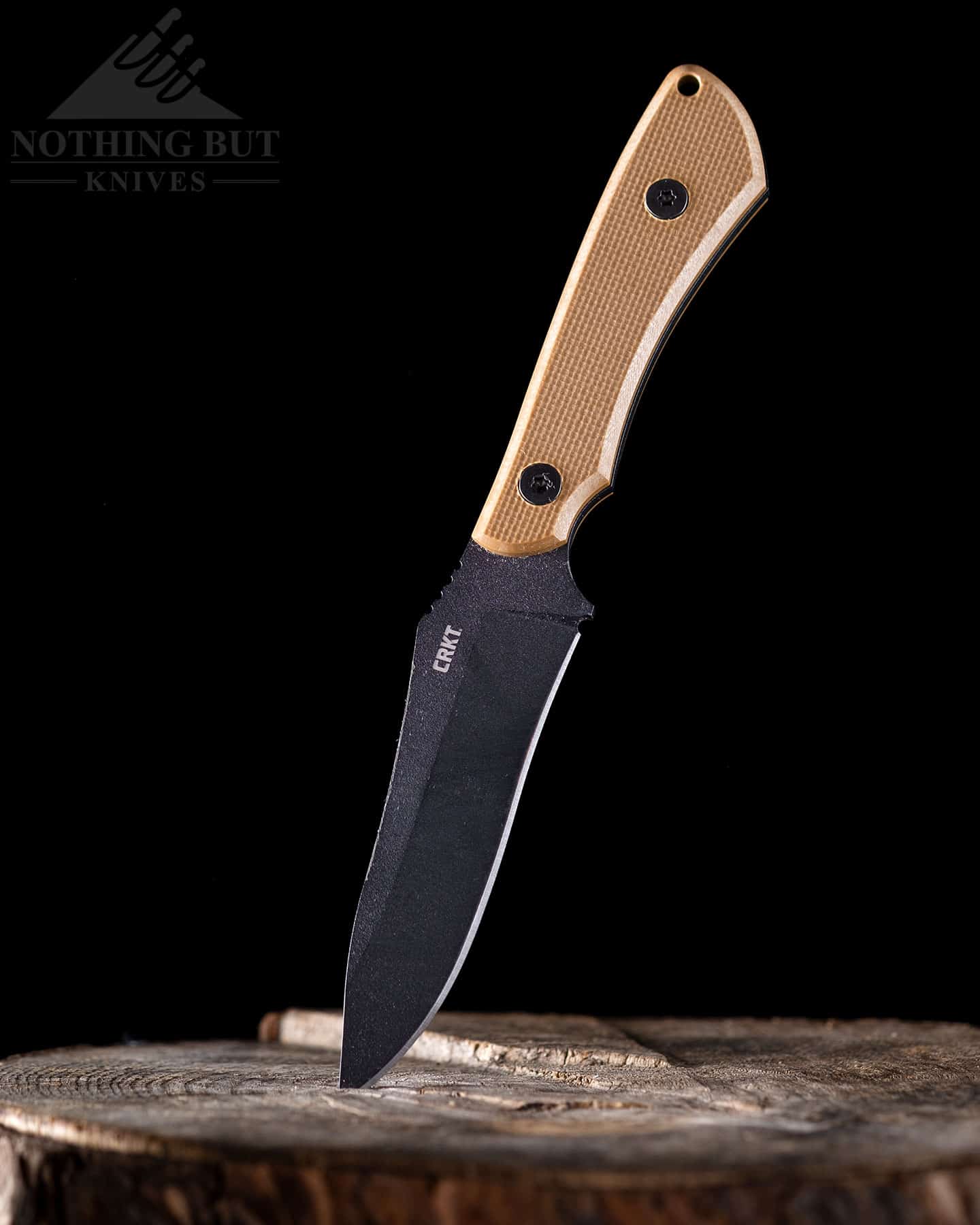
| Overall Length: | 8.5” |
| Blade Length: | 4.37” |
| Blade Shape: | Drop point |
| Steel: | SK-5 |
| Handle Length: | 4.13” |
| Handle Material: | G-10 |
| Grind: | Flat |
| Build: | Full tang fixed blade |
| Carry type: | Kydex sheath w/ Tek Lok |
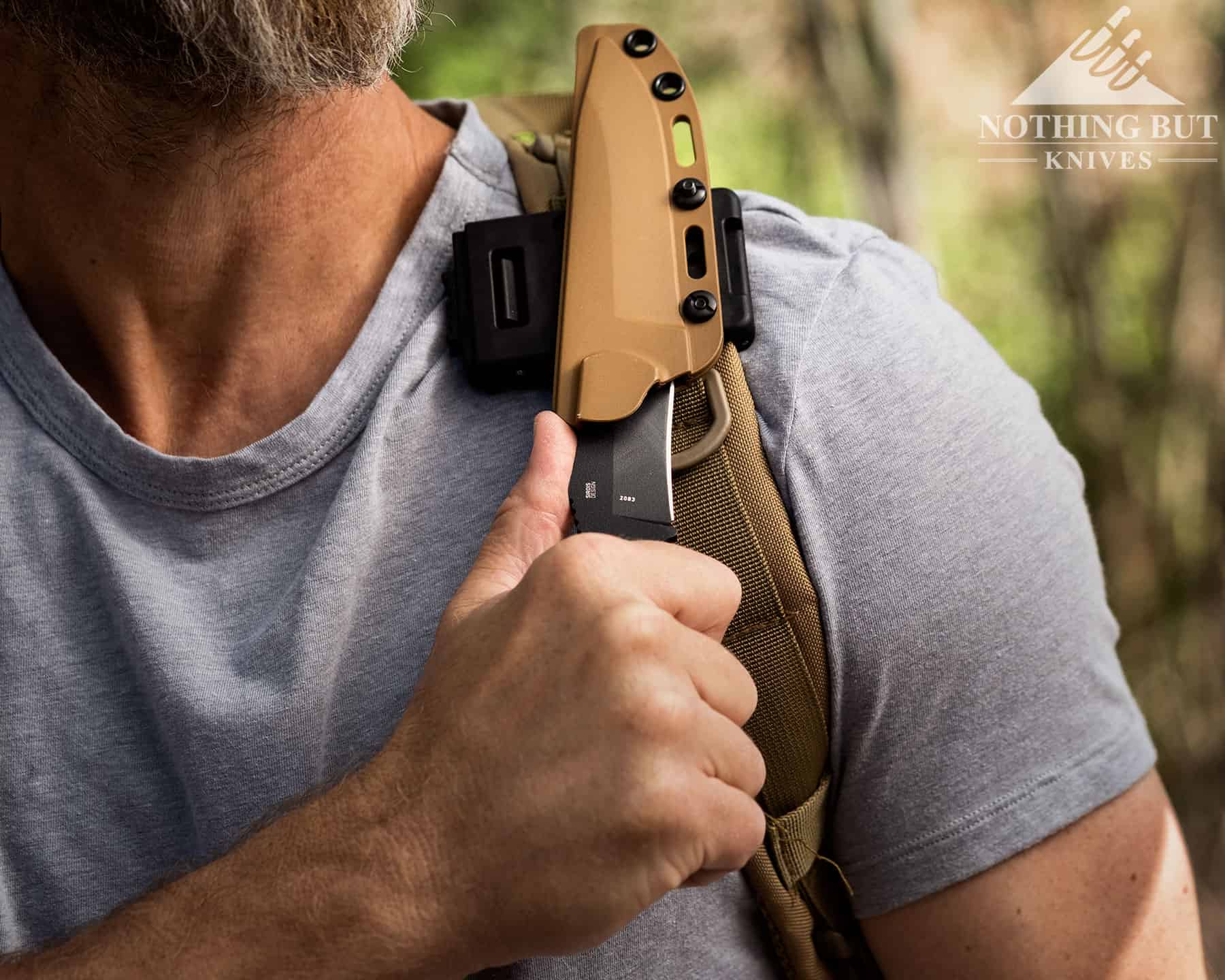
Whatever else the Ramadi might be good at, the handle and sheath are the reason I call this a great tactical knife. It draws so comfortably, and seats into my hand so well immediately after leaving the sheath that it has a faster-than-thought feeling to it.
I rarely need to adjust my grip after drawing the Ramadi, and when I do, the contouring of the handle makes it easy to do that quickly and comfortably.
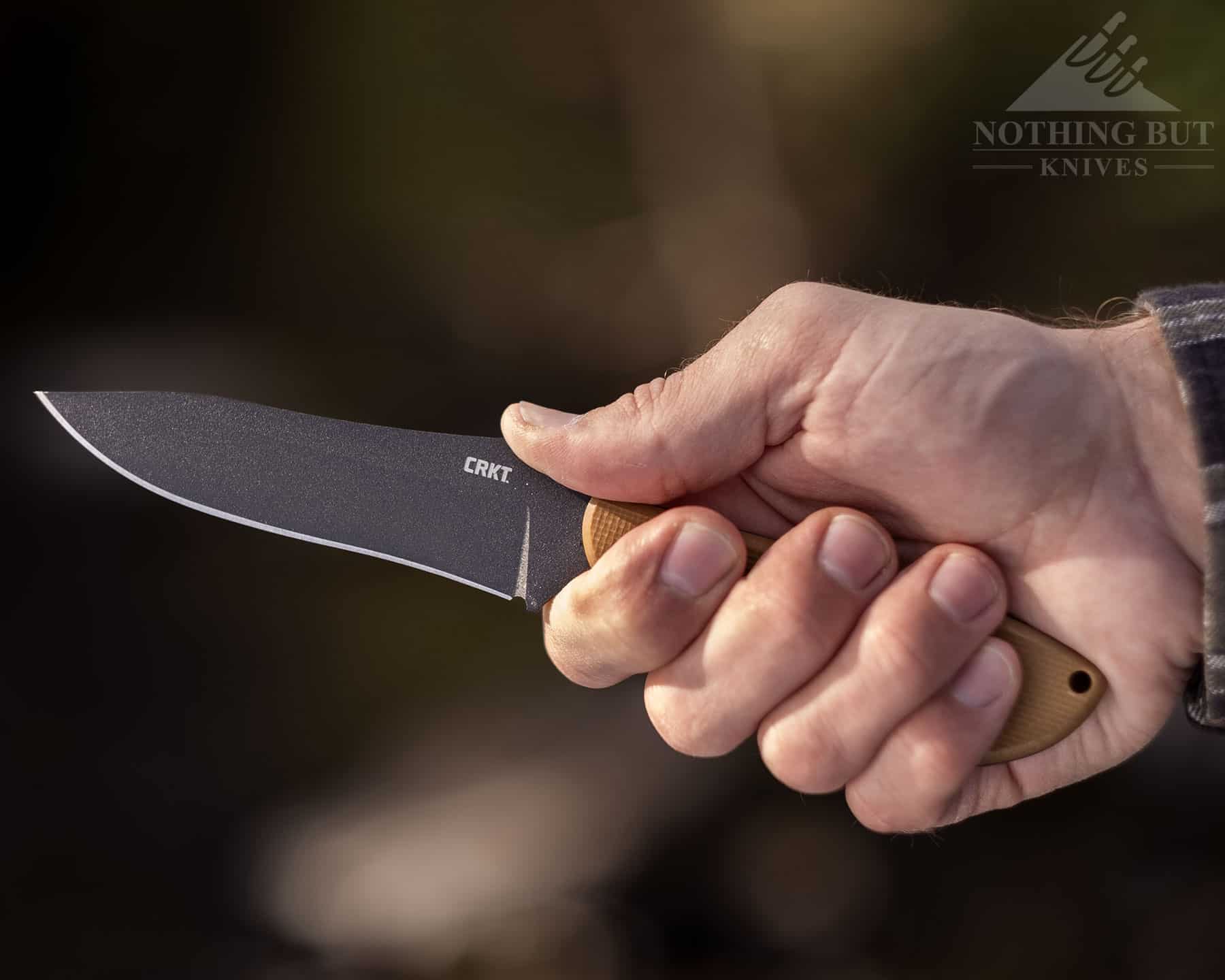
The rest of the knife is good too. The blade is thick, but it has an aggressive drop point shape that just borders on the edge being a clip point. It actually reminds me a lot of the Cold Steel SRK, only smaller and easier to draw. I say something similar in our full review of the Ramadi.
CRKT SIWI
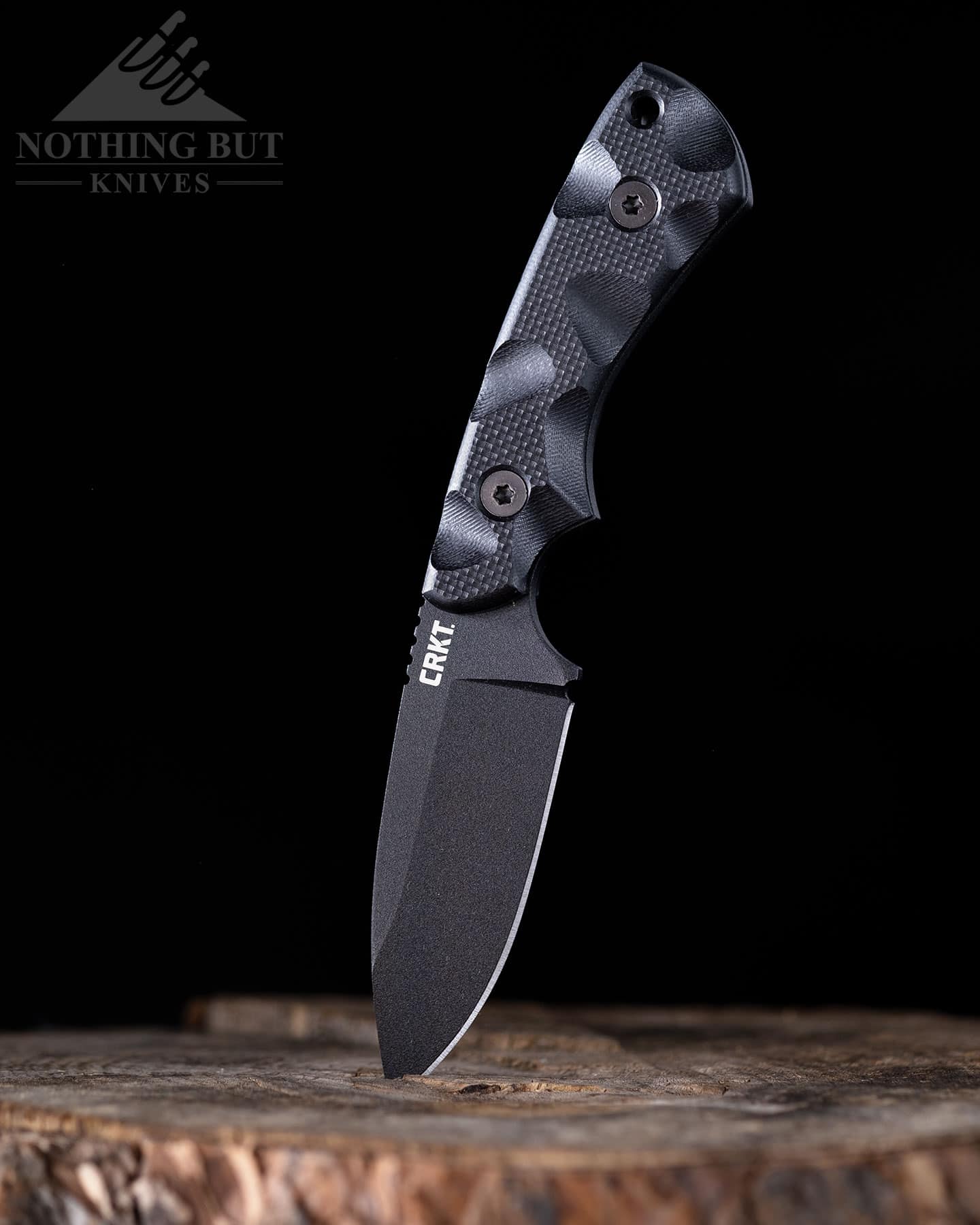
| Overall Length: | 7.25” |
| Blade Length: | 3.34” |
| Blade Shape: | Drop point |
| Steel: | SK-5 |
| Handle Length: | 3.91” |
| Handle Material: | G-10 |
| Grind: | Flat |
| Build: | Fixed blade |
| Carry type: | Polymer w/ small Tek Lok |
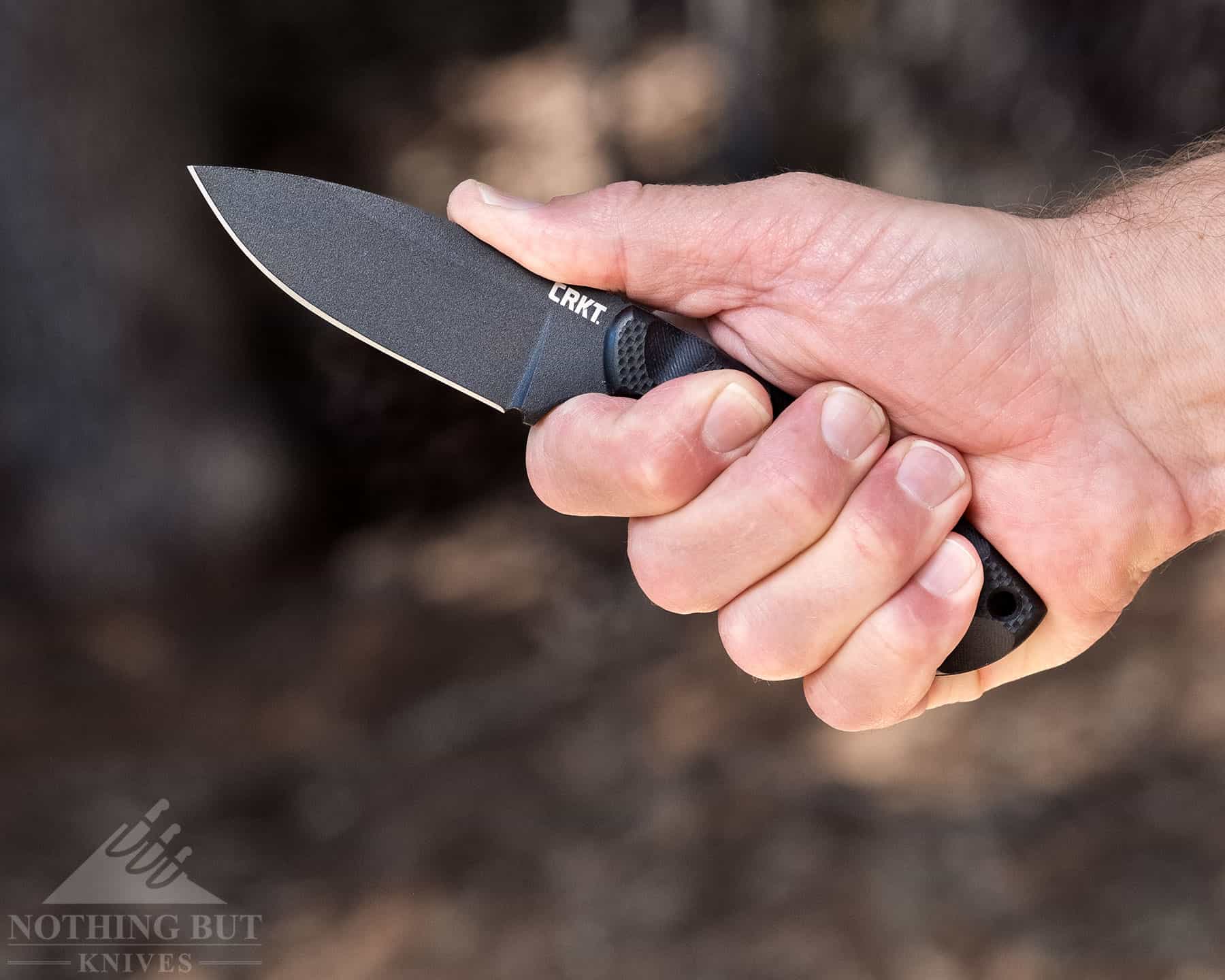
Not a lot of people can pull off a small tactical design that’s still this functional. Like the Ramadi, a lot of the SIWI’s upside is in its handle (same designer, so no surprise there). It’s short, fat, and super comfortable. It provides a really secure grip without taking up too much space or using a lot of texture, so it’s also easy to clean.
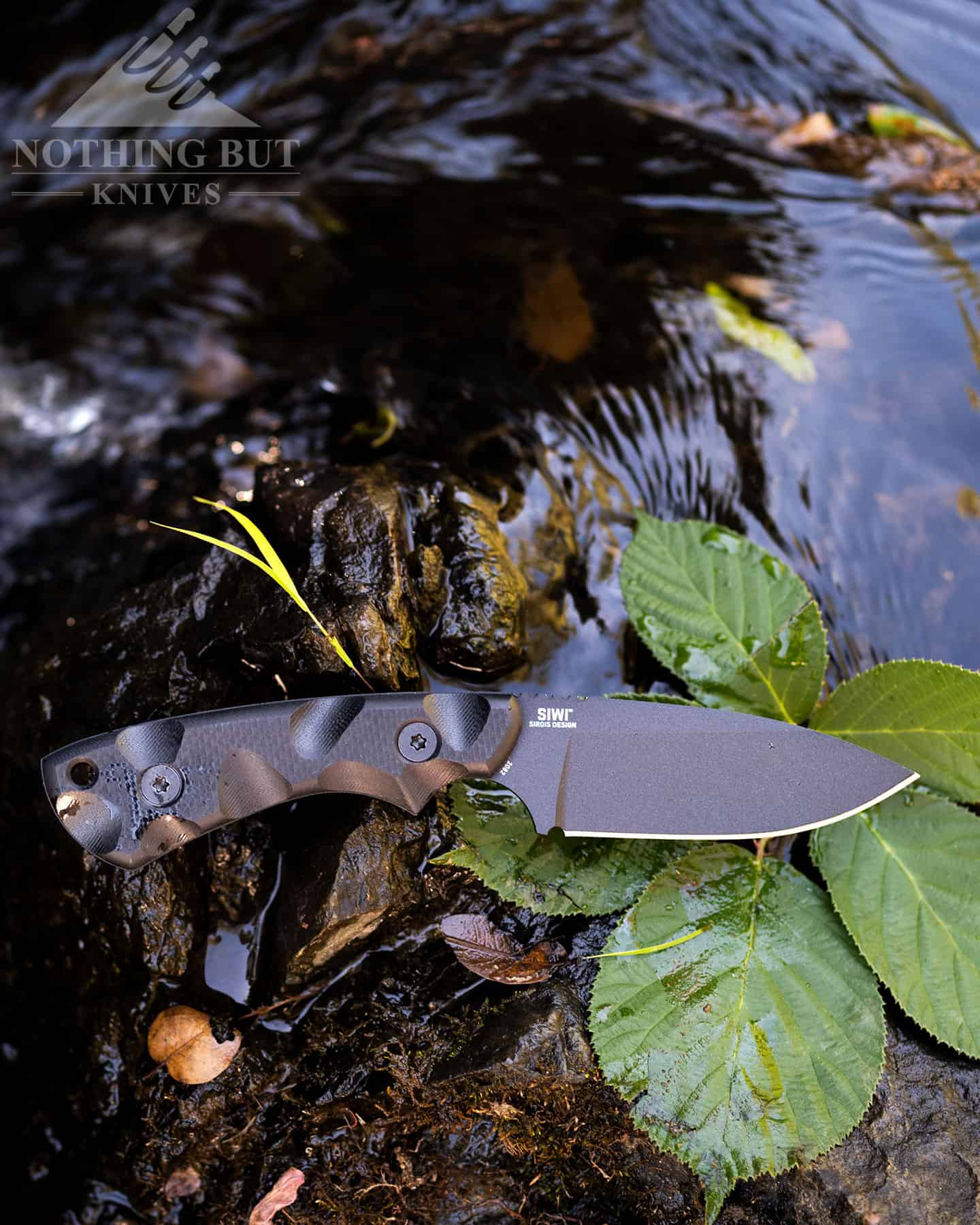
The blade has its perks too, though. Thick SK-5 steel gets a lot of work done as we’ve already seen with a few other knives in this list. It’s not the best slicer, but you can definitely get it there, and there’s a lot of room for error in abusing this knife so long as the finish stays on.
ESEE
| Pros: Tough builds and all around great manufacturing practices. |
| Cons: More bushcraft oriented. |
While technically not a tactically-minded company, ESEE does some things that make them worth a look for emergency use. The design team consists almost entirely of survivalists who carry prototypes into the jungle before sending them off into production. They make a lot of good examples for the argument that many elements that make good survival knives cross over into good tactical knives.
ESEE Izula II
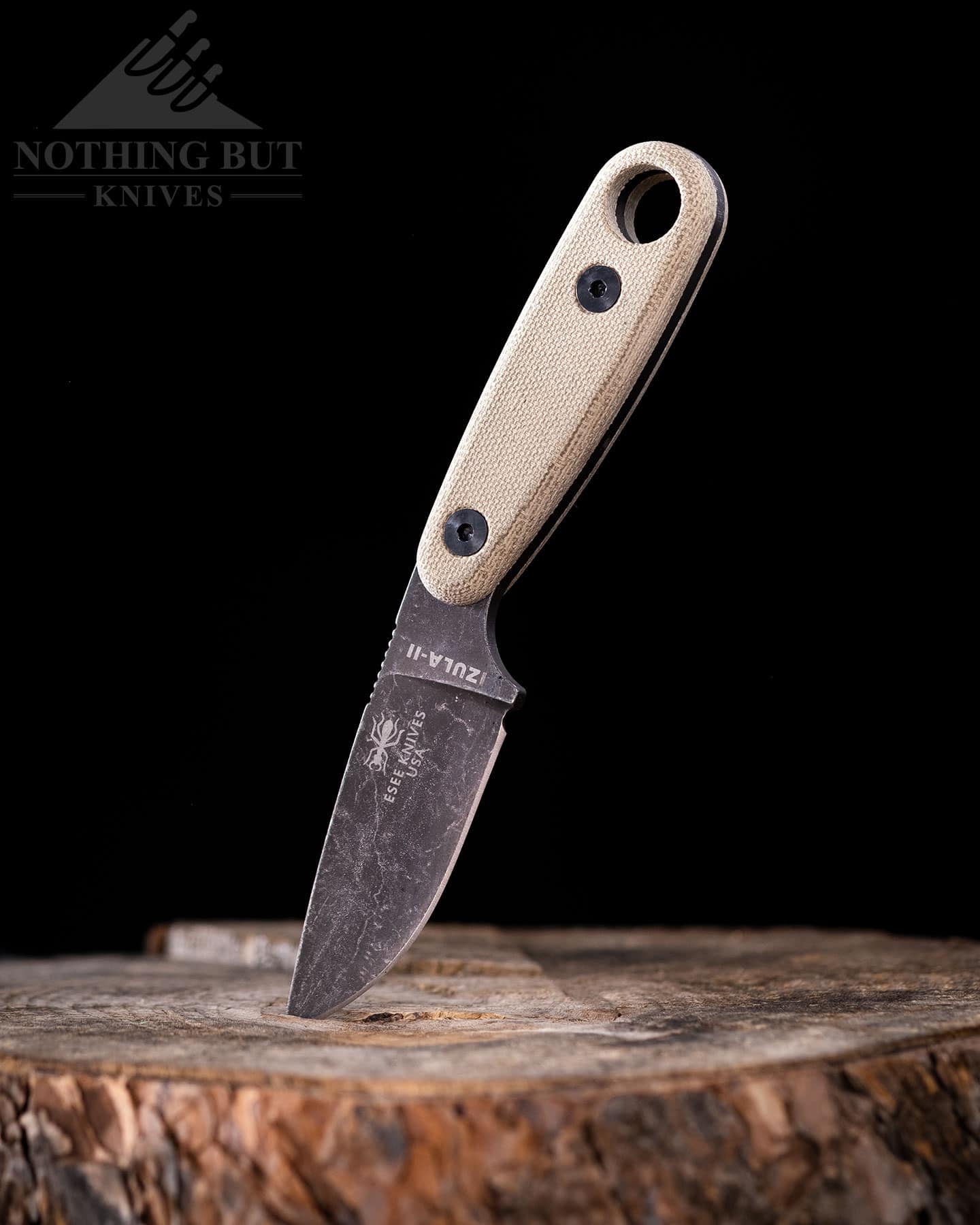
| Overall Length: | 6.75” |
| Blade Length: | 2.875” |
| Blade Shape: | Drop point |
| Steel: | 1095 |
| Handle Length: | 4.0” |
| Handle Material: | Micarta |
| Grind: | Flat |
| Build: | Fixed blade |
| Carry type: | Polymer sheath (belt clip or neck knife) |
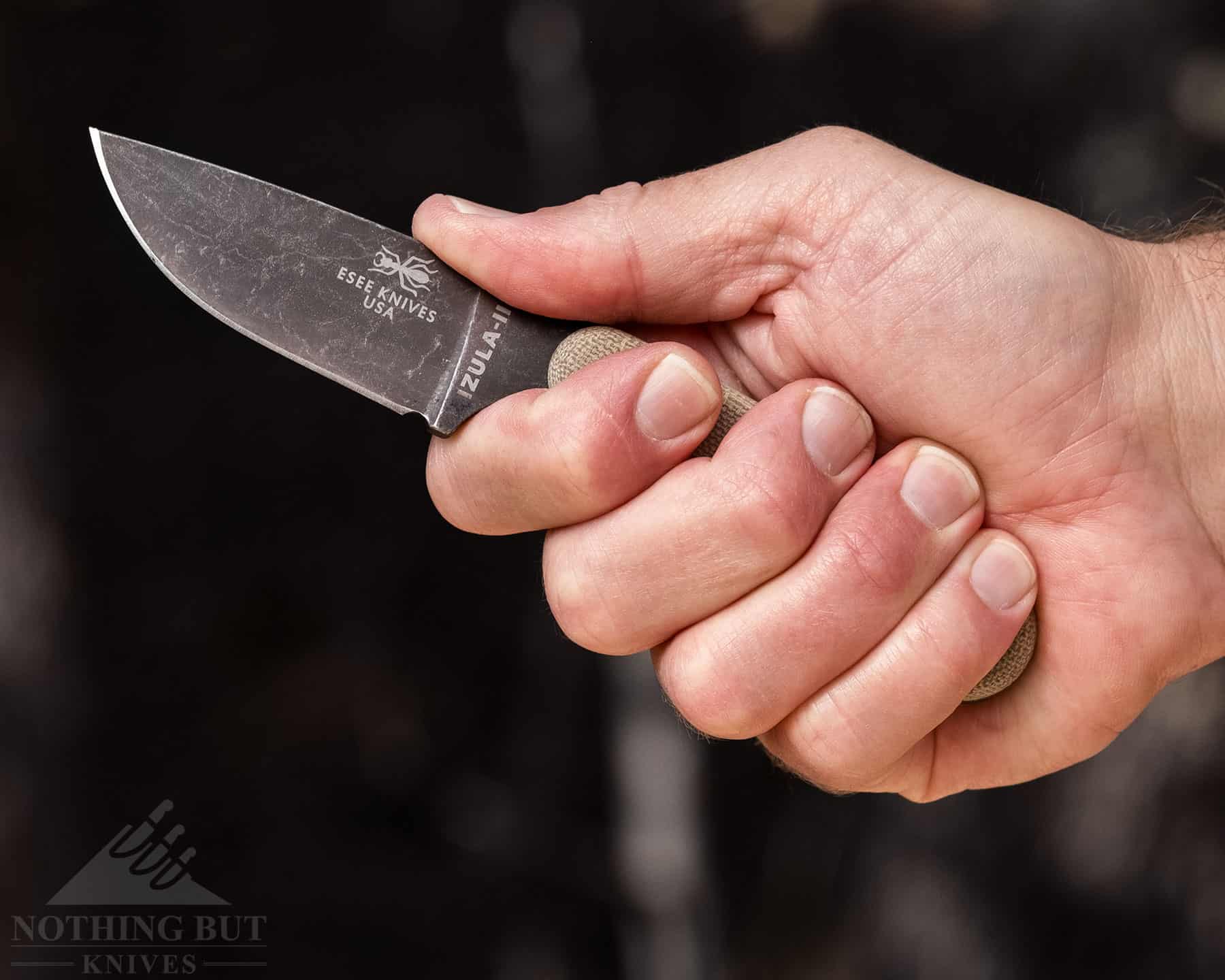
Similar to the Cold Steel Mini Tac, the Izula’s strength is largely in its size. You can carry it pretty much anywhere: around the neck, scout style on the belt, front side off the hip, in your boot, in your glove box.
Really the only limitation is your imagination and your local knife laws. It has a thin profile when it’s sheathed, and you can get it with a belt clip that’s really easy to adjust and slip onto whatever strap or belt that’s on you or your backpack.
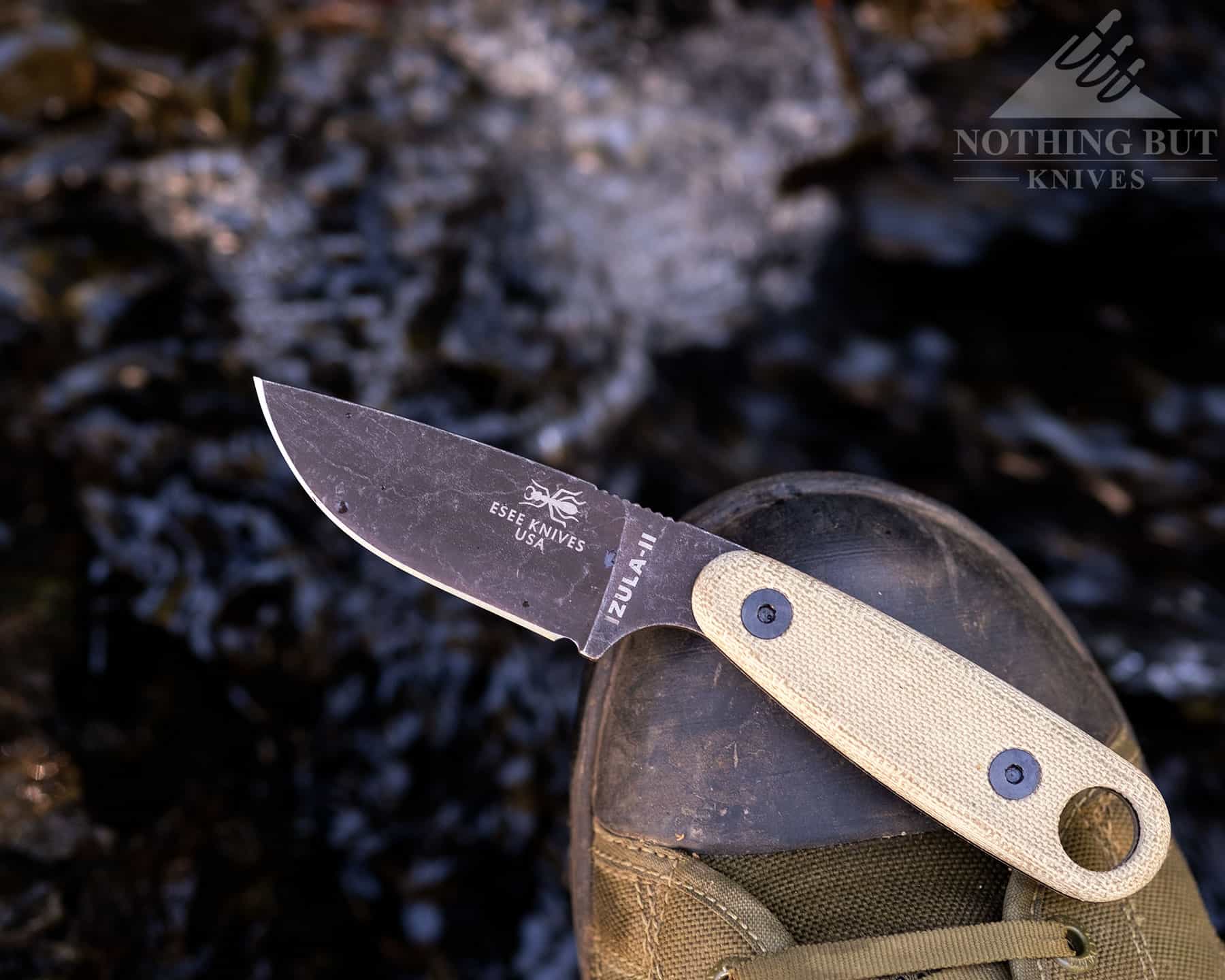
When it’s out of the sheath, it’s a tough little thing that can pack a punch, but you’ll probably need to work with it to get the edge to a really effective sharpness. The factory edge is usually serviceable, but ESEE likes to leave some room for the end user to play with it.
ESEE 4
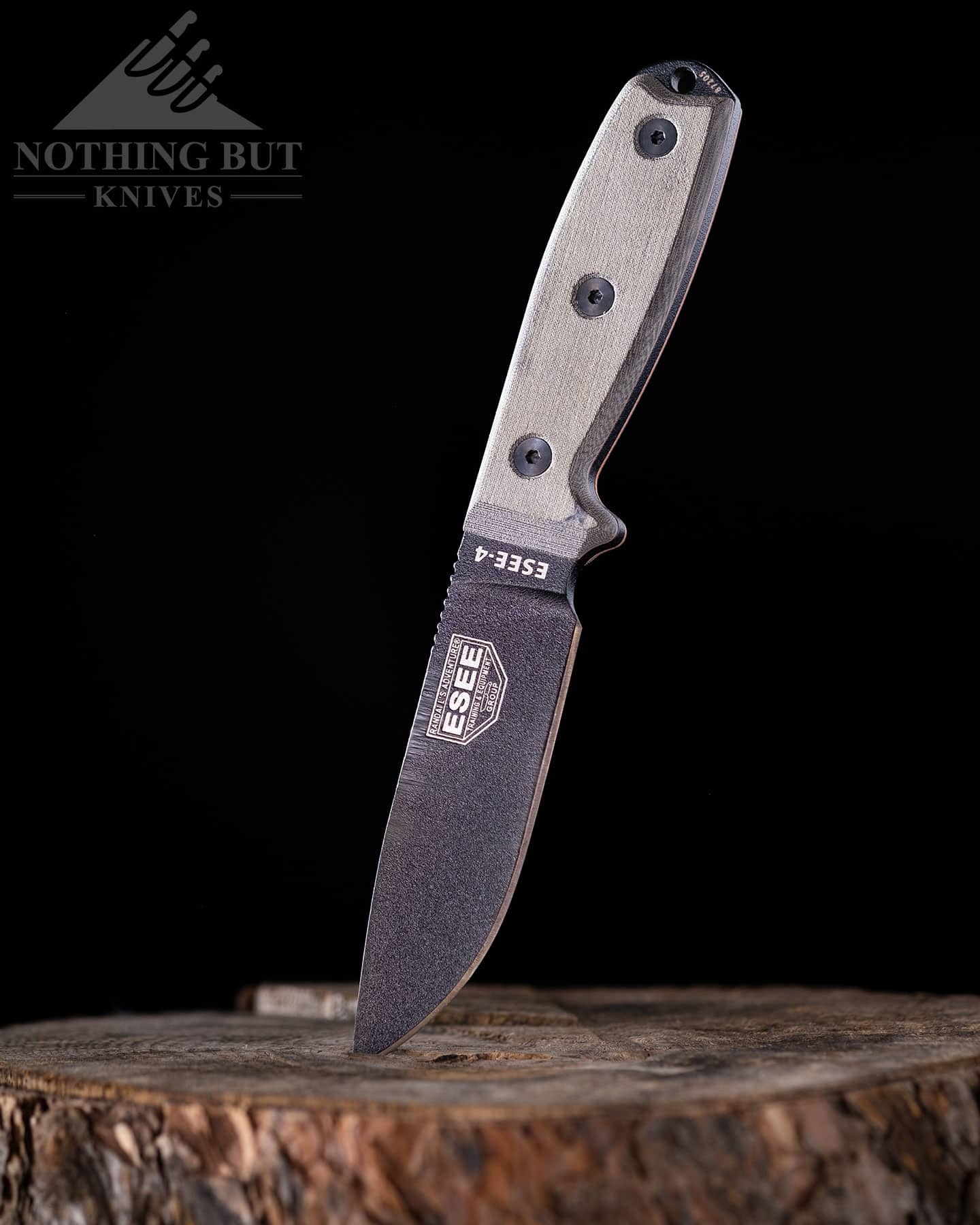
| Overall Length: | 9.0” |
| Blade Length: | 4.5” |
| Blade Shape: | Drop point |
| Steel: | 1095 |
| Handle Length: | 4.5” |
| Handle Material: | Micarta (with other options) |
| Grind: | Flat |
| Build: | Fixed blade |
| Carry type: | Polymer sheath w/ Cordura MOLLE back |
Going by strict definition, the ESEE 4 is not a tactical knife. It was made for survival and bushcraft tasks, and it should be seen as something optimized for a wilderness environment.
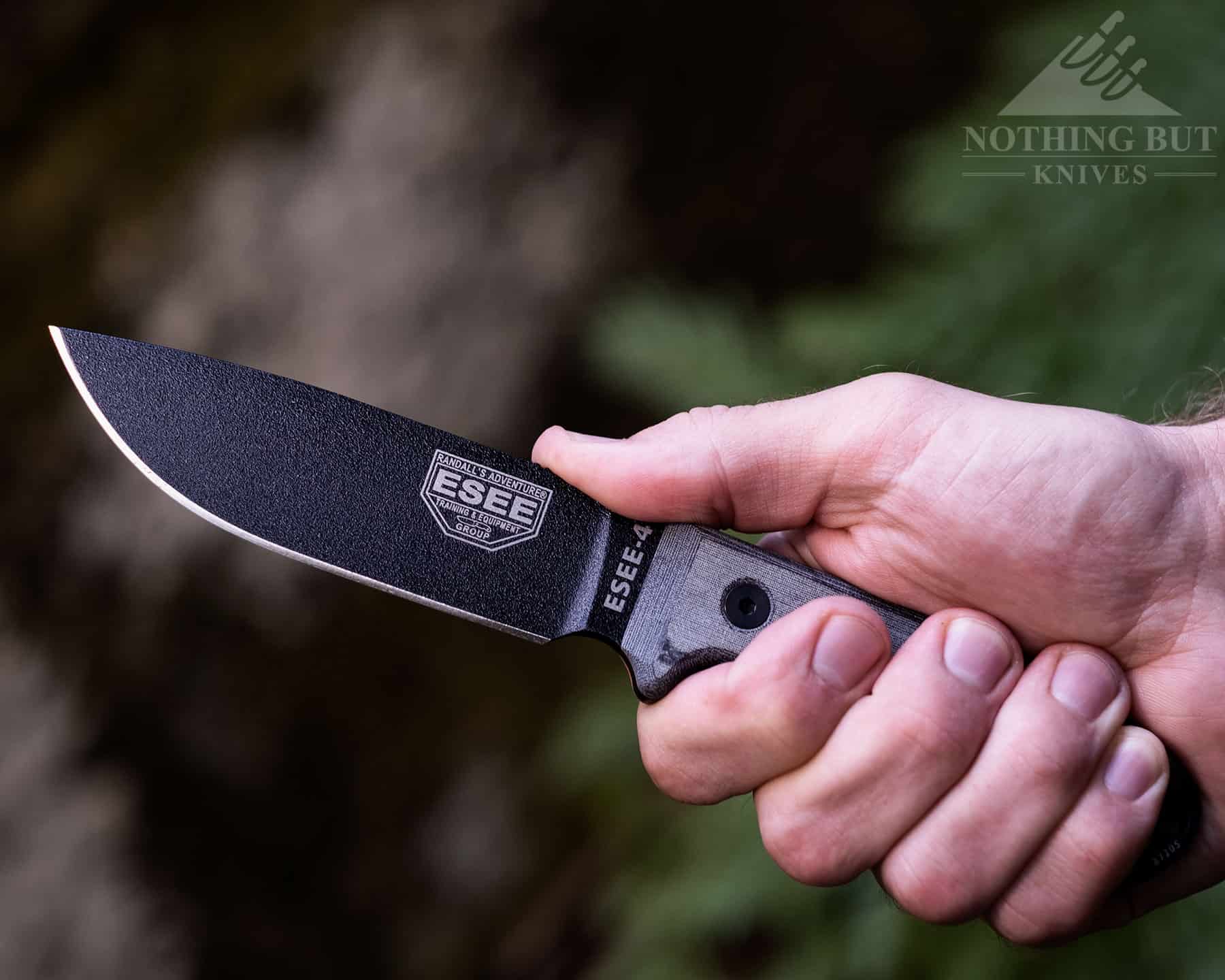
But ESEE does this neat thing where they make their knives really easy to modify. And since the base design is so solid, and the manufacturing is pretty much always spot on, there’s a lot of room to play.
The blade stock is thick, and 1095 is really easy to grind so you can get this thing to be pretty damn slice-y. And while I don’t particularly like the feel of their Micarta scales, they’re easy to switch out, and ESEE makes 3D G-10 scales that fill the hand better.
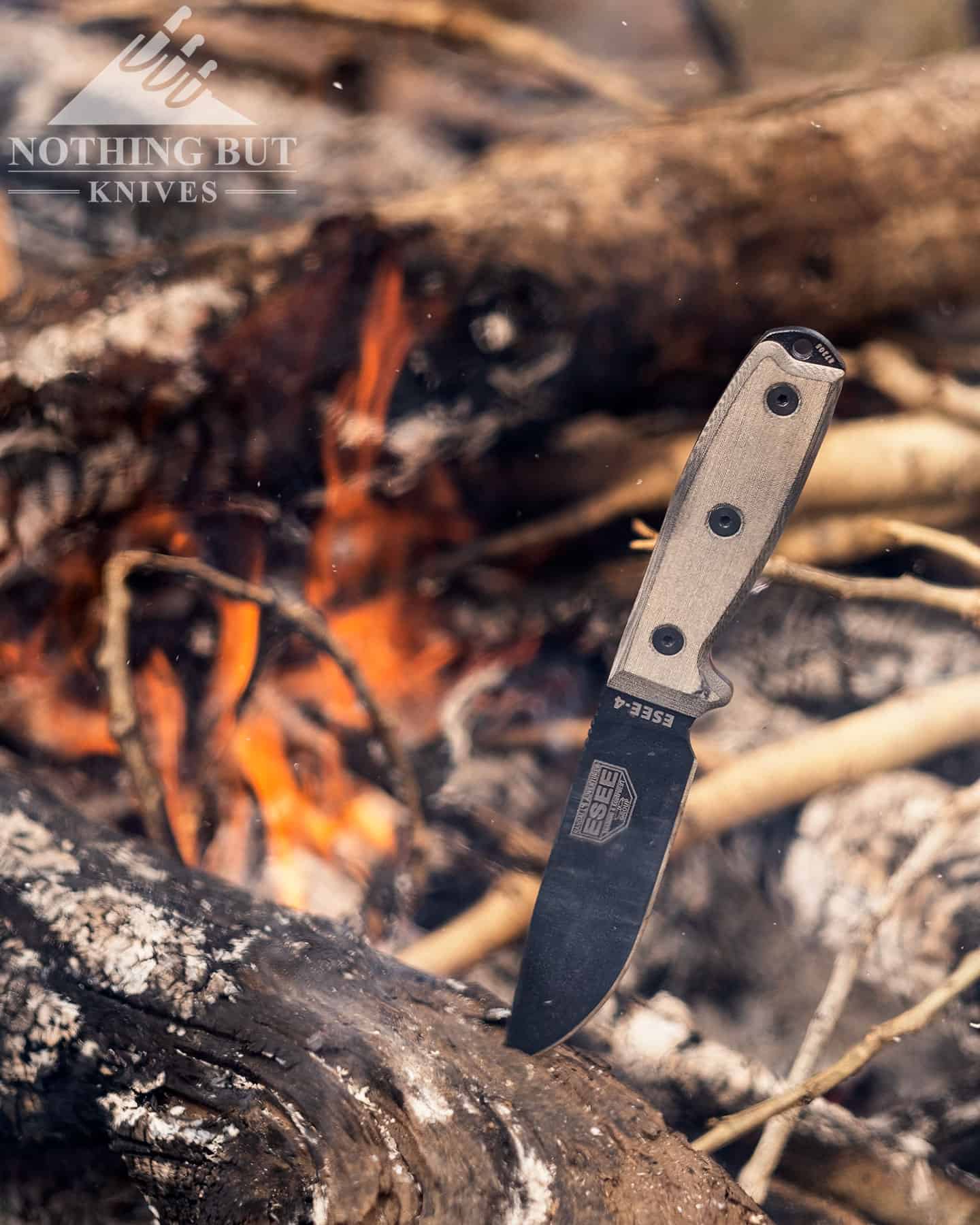
The point is, in a world of high-speed, low-drag options in the tactical knife world, the ESEE 4 is the more outdoorsy option for people who just aren’t comfortable with the usual fare in this category.
If this seems cool to you, check out our full review of the ESEE 4.
Gerber
| Pros: Often a good budget option with some decent designs. |
| Cons: Not always the best manufacturing, even in their US factory. |
I’ve always seen Gerber as Buck’s ugly cousin. They’re mostly American made, and are known for a few really solid designs, but their penchant for cheap, outsourced designs over the last decade or so often leaves a flat taste in the mouth… or hand, I guess.
Unlike Buck, though, they tend toward a military aesthetic that produces tactical designs at a higher rate.
Gerber StrongArm
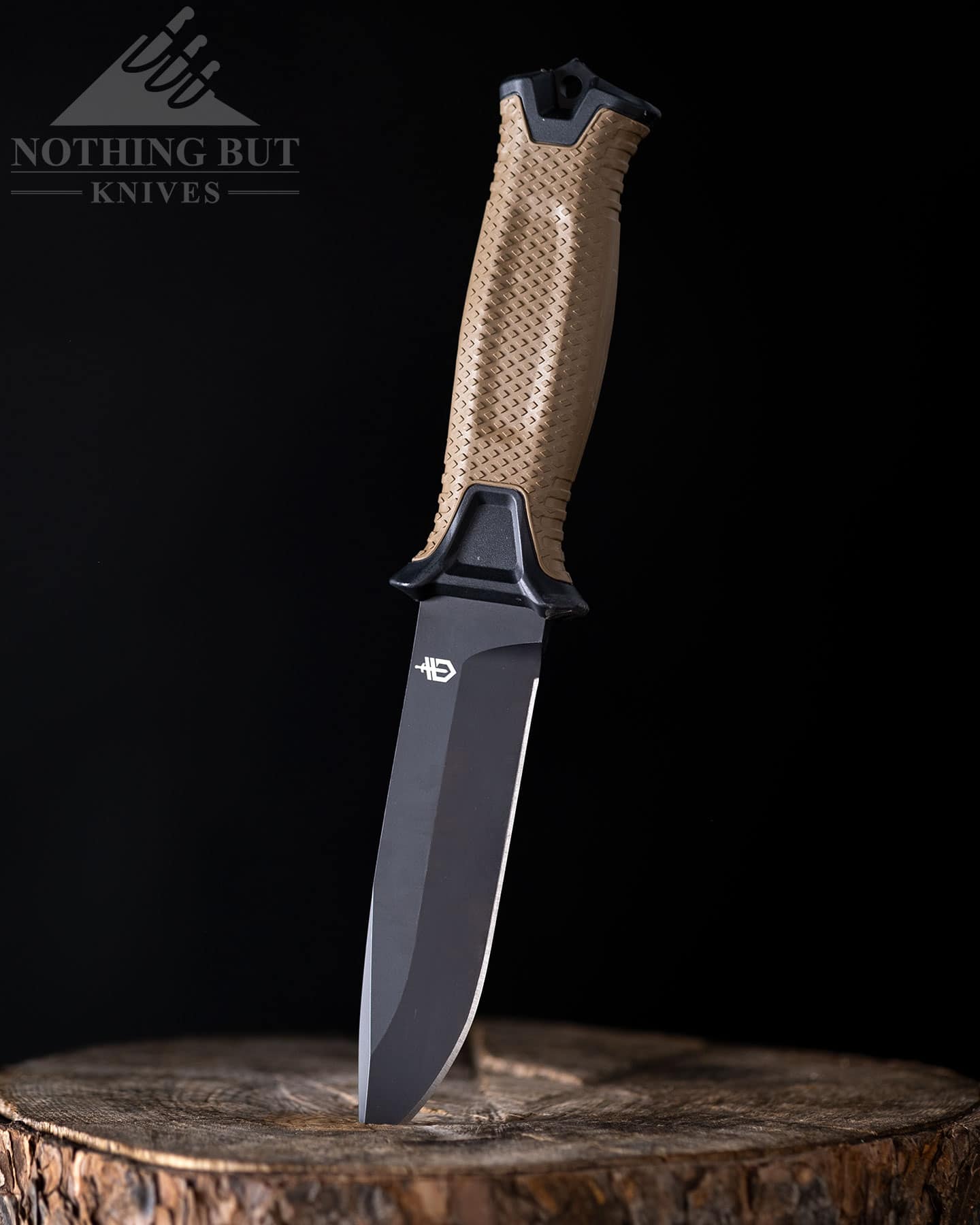
| Overall Length: | 9.75” |
| Blade Length: | 4.875” |
| Blade Shape: | Drop point |
| Steel: | 420HC |
| Handle Length: | 5.0” |
| Handle Material: | Rubber |
| Grind: | Flat |
| Build: | Fixed blade |
| Carry type: | MOLLE compatible polymer sheath |
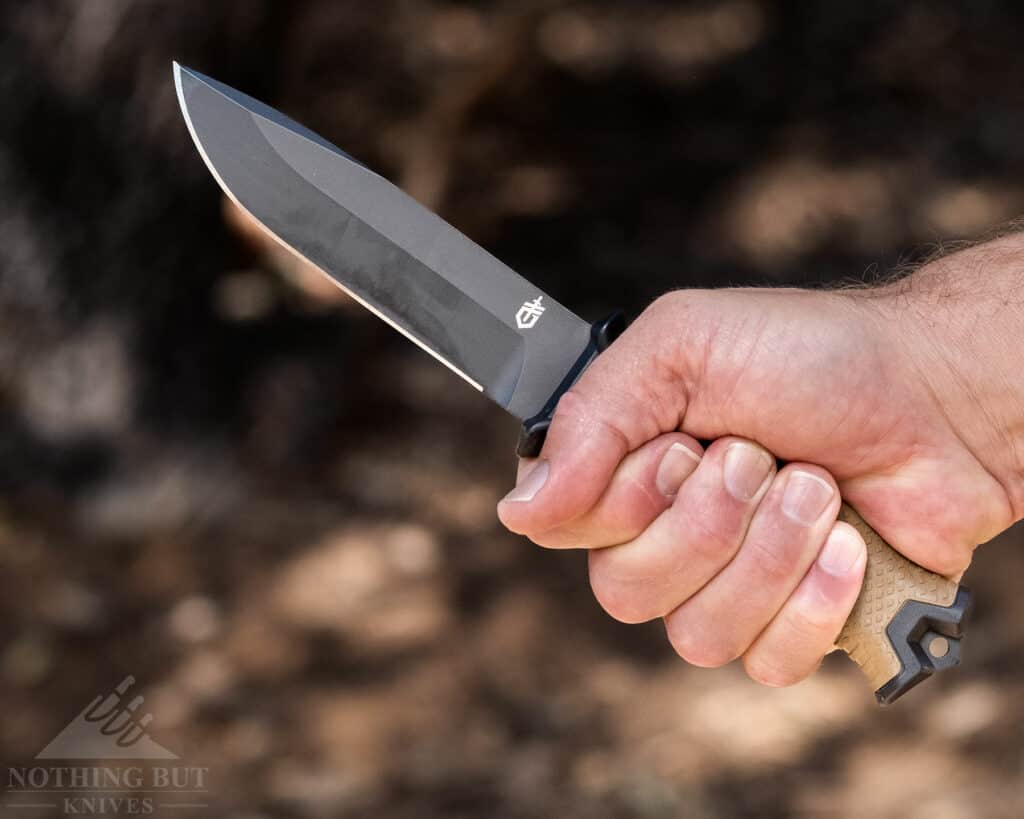
It has the look and some of the feel, but the Strongarm should really be taken with a grain of salt.
It’s a decent tactical knife that can take some abuse by virtue of being made up of a lot of soft materials. The 420HC steel is good, but doesn’t hold a great edge. The rubber handle gives you a good grip without being too clingy, but the balance doesn’t feel quite right.
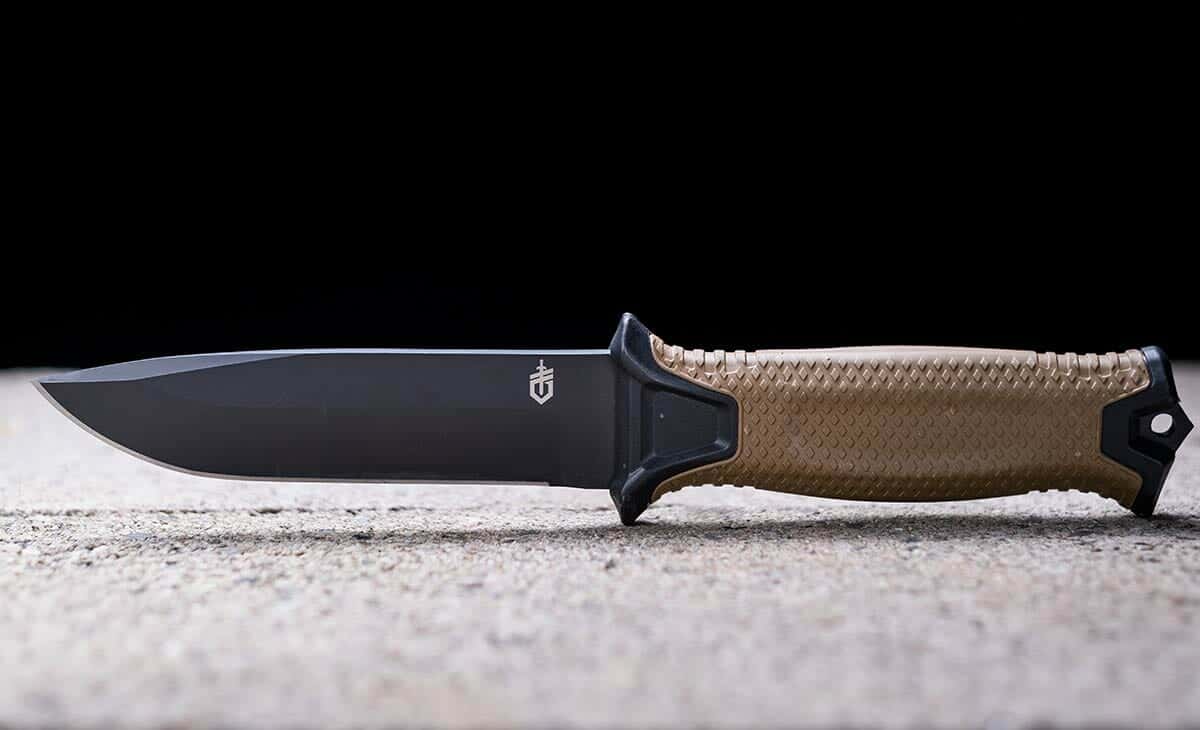
But it’s fairly cheap, and it’s one of those knives that you can always get to work for whatever you’re doing. It’s light, there are a lot of viable carry options with the sheath, and the handle is shaped to provide a hand guard in a non-intrusive way.
The design has some great lines to it. The problems really come from materials and execution, and even there I’d say give you plenty of use for the price.
Hogue Knives
| Pros: | Tough quality, American Made |
| Cons: | Prices tend to be on the high end |
Hogue is no stranger to the tactical world. They have been making quality gun accessories for many years, and when they went into knives they dove in head first with some of the best materials out there for knives right now, and enlisting some fantastic, veteran designers.
Hogue SIG K320 AXG Pro
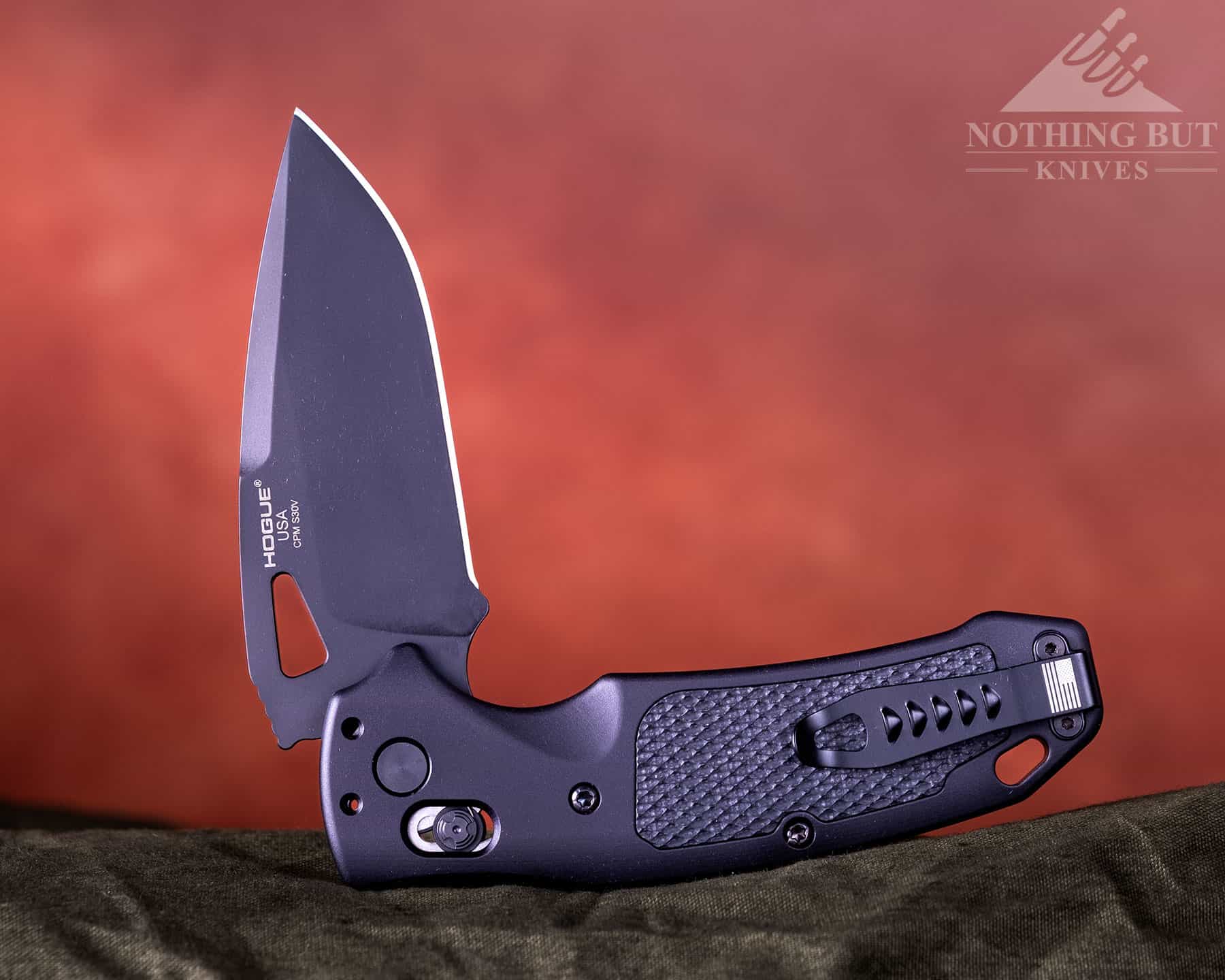
| Overall Length: | 8″ |
| Blade Length: | 3.5″ |
| Blade Shape: | Drop Point |
| Steel: | CPM-S30V |
| Handle Length: | 4.75” |
| Handle Material: | Aluminum / G-10 |
| Grind: | Flat |
| Build: | Folding Knife |
| Carry type: | Tip-up clip |
The K390 APX Pro is the result of a collaboration with Sig Sauer. It’s meant to be an EDC buddy to the SIG P320 AXG Pro pistol, but the Hogue K320 is a great knife on its own.
The ABLE slide lock is bomb proof, blade deployment is quick, and the handle is easy to grip in all types of weather conditions.
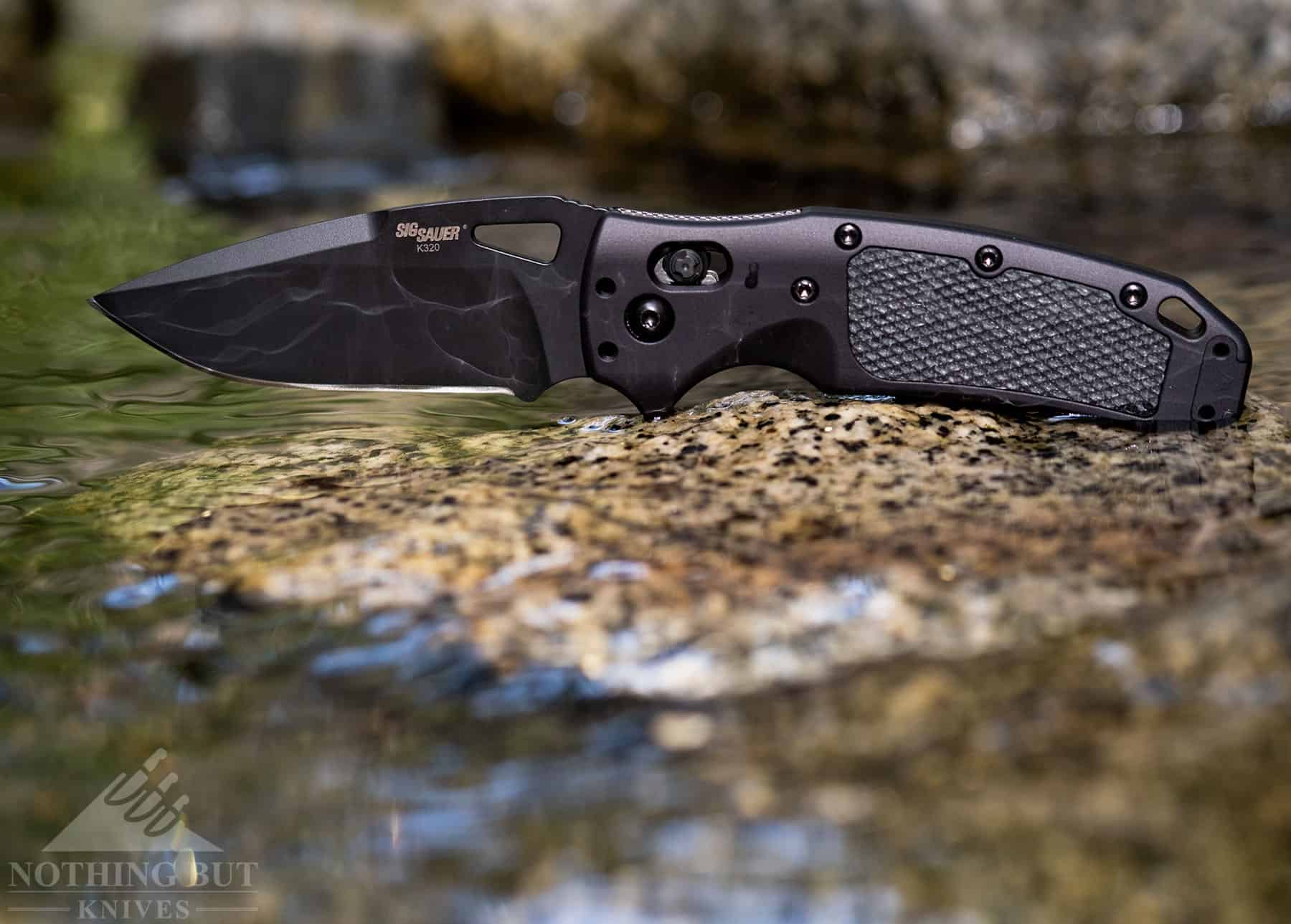
This knife is cool just from the Sig call out and all the subtle design elements that pay homage to the gun, but has a couple of good upsides as a tactical tool on its own, the main ones being that it’s very understated and easy to carry.
The fast deployment and the easy grip are great too, but Hogue did a great job here of creating a knife that most people would be comfortable carrying as an EDC so that it’s actually something you’re likely to have when you need it most.
You can more about this capable tactical folder by checking out our Hogue K320 AXG Pro Knife Review.
Ka-Bar / Becker Knife & Tool
| Pros: Tough quality, practical designs |
| Cons: Designs tend to look the same |
The list of good Ka-Bar tactical knives could get really long if we let it. Designing military knives is what made them a household name, and they’ve stayed pretty true to the mindset that created that first USMC Bowie.
Since then they’ve picked up Becker Knife & Tool (and more recently an arm of Spartan Blades) and made a lot of spectacular fixed-blade knives designed for (and often by) people working dangerous jobs in the field.
A lot of their designs are very practical and stripped down. Sometimes they make a knife that’s maybe too big or unbalanced for its own good, but on the whole, Ka-Bar and Becker are probably the most reliable mainstream brands to go to for tactical knives.
Ka Bar BK-18 Harpoon
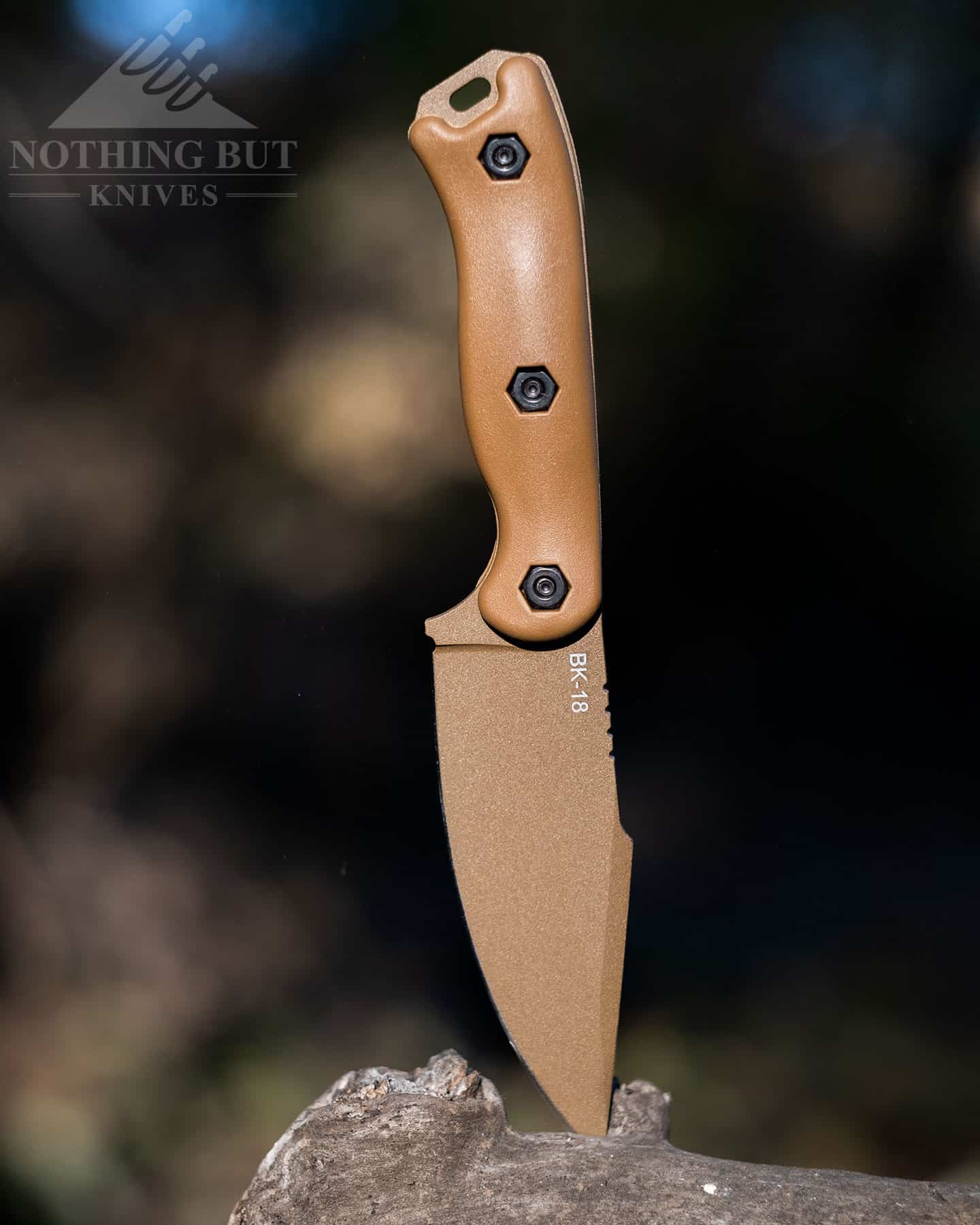
| Overall Length: | 9.375” |
| Blade Length: | 4.5” |
| Blade Shape: | Harpoon |
| Steel: | 1095 Cro-Van |
| Handle Length: | 5.0” |
| Handle Material: | Zytel |
| Grind: | Flat |
| Build: | Fixed blade |
| Carry type: | Polymer sheath w/ Tek Lok |
This is a deceptively comfortable knife that we had a great time testing as a bushcraft blade, calmly ignoring the fact that Ethan Becker very much designed this for tactical use.
That harpoon shape creates a very strong tip, and the deep finger swell for the index finger in the handle works well enough as a hybrid guard to help keep your hands from slipping up onto the blade.
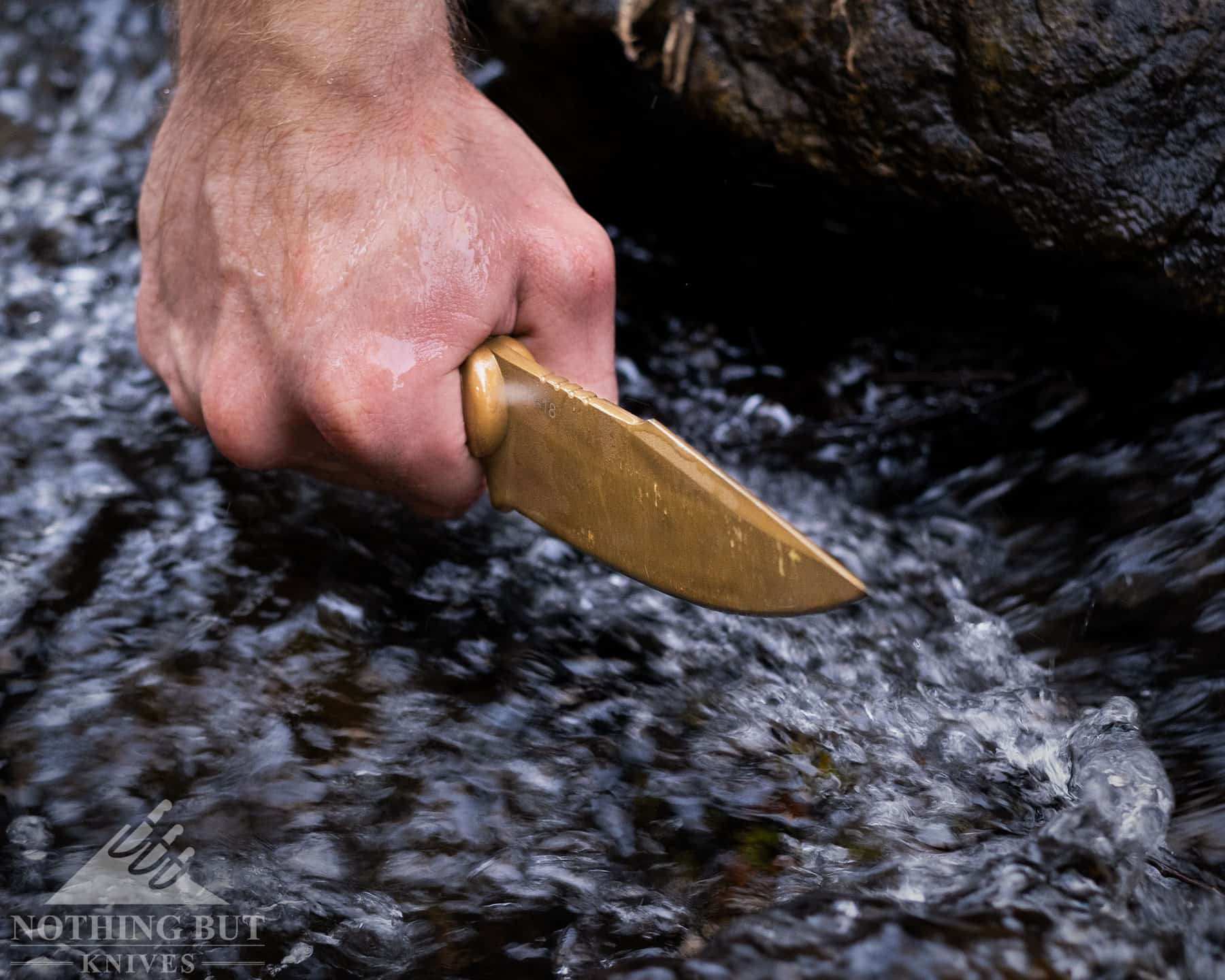
The handle contouring feels just about right for filling the hand providing some grip through curvature without getting in the way of the fingers. If it has a fault it’s that it’s very round and might be harder to keep from turning in your hand.
We spent a few weeks testing this knife out in the great outdoors. You can find more photos and opinions by checking out or in-depth review of the Ka-Bar Becker BK18.
Ka Bar TDI
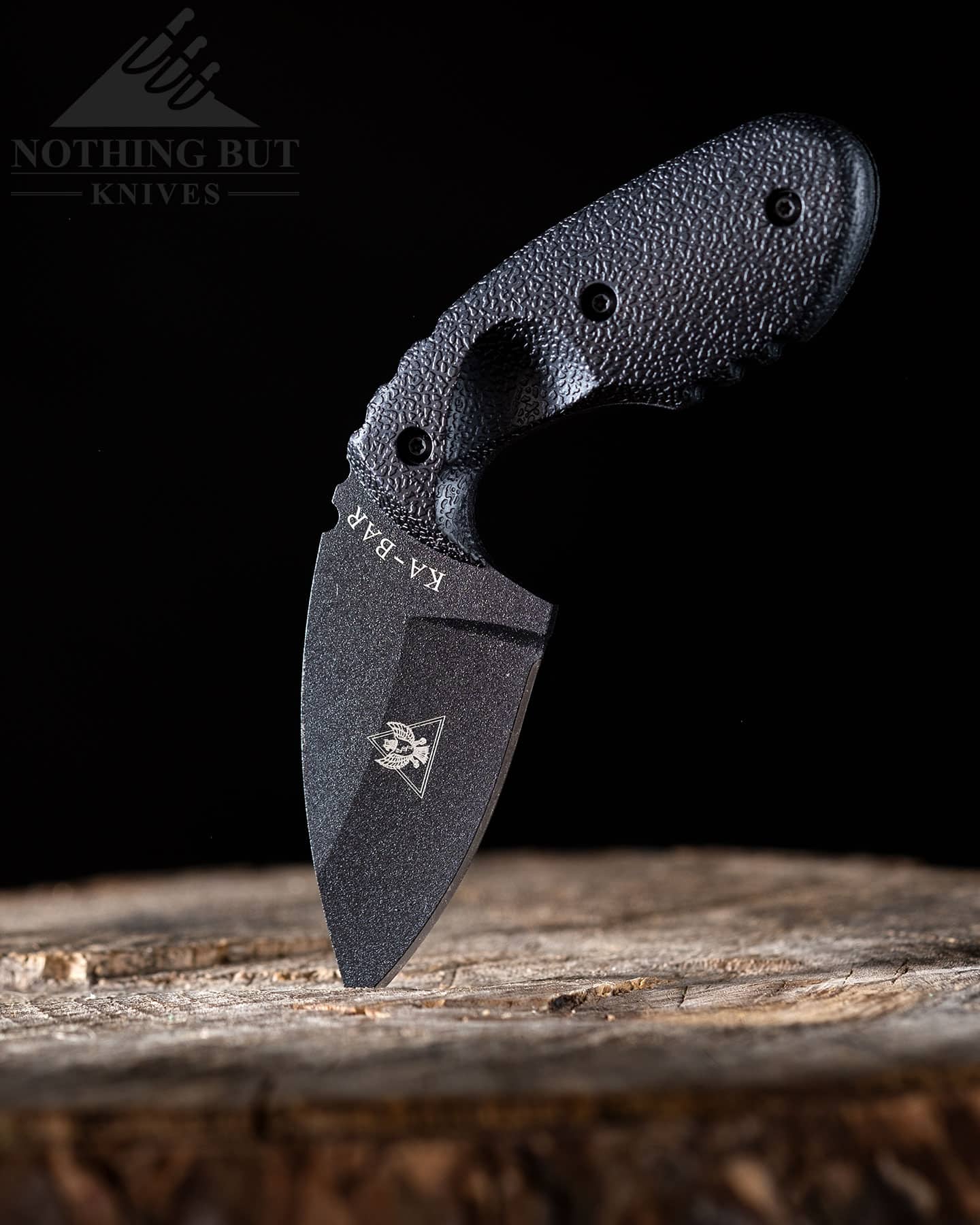
| Overall Length: | 5.625” |
| Blade Length: | 2.31” |
| Blade Shape: | Drop point |
| Steel: | AUS-8A |
| Handle Length: | 3.32” |
| Handle Material: | Zytel |
| Grind: | Hollow |
| Build: | Fixed blade |
| Carry type: | Polymer sheath |
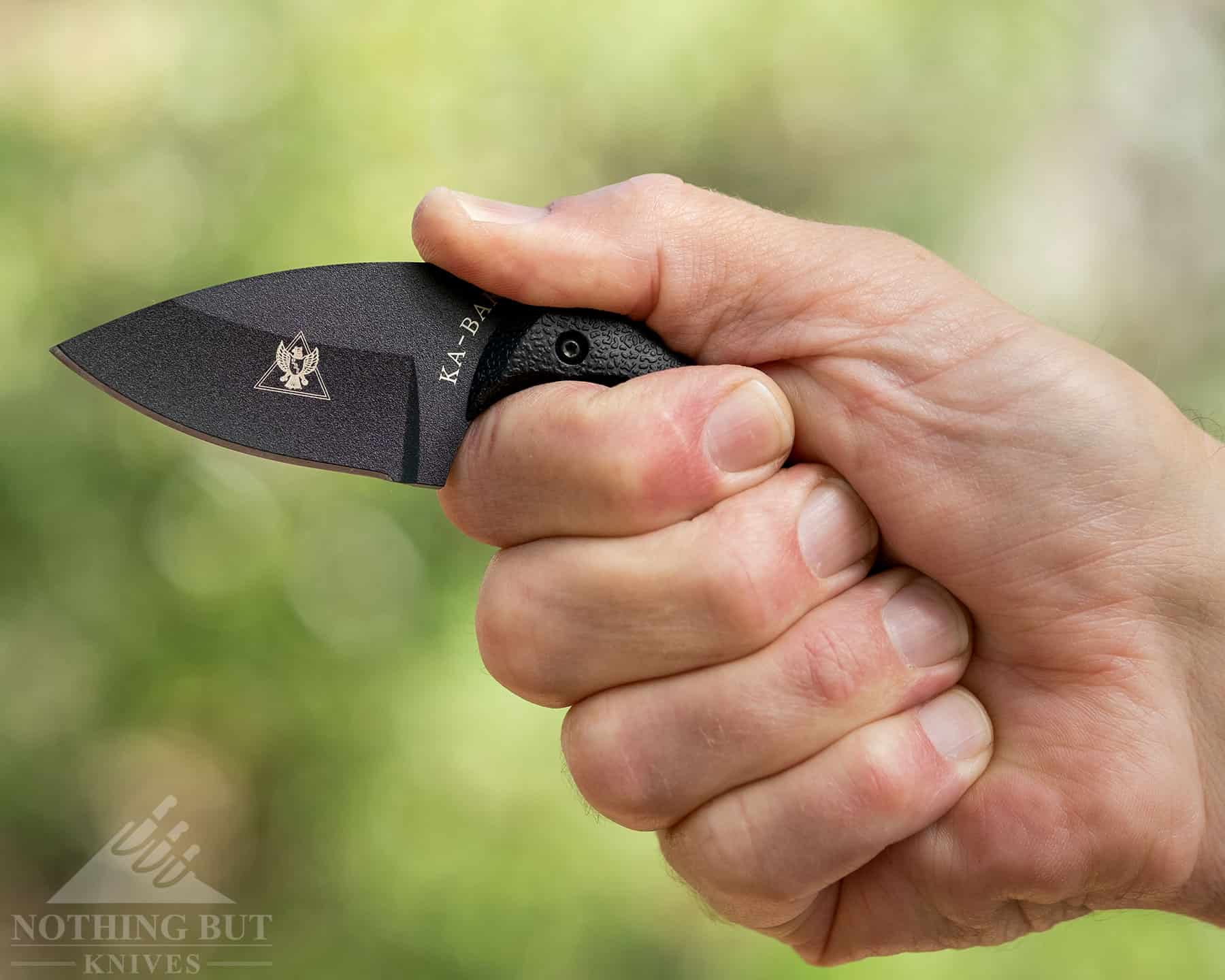
This is kind of an awkward piece at first, but once you get the hang of using and carrying it, the TDI is a really handy low-visual knife to carry around. It rides in a basic but effective sheath with a clip that can ride as easily on the belt as it does inside the waist of your jeans.
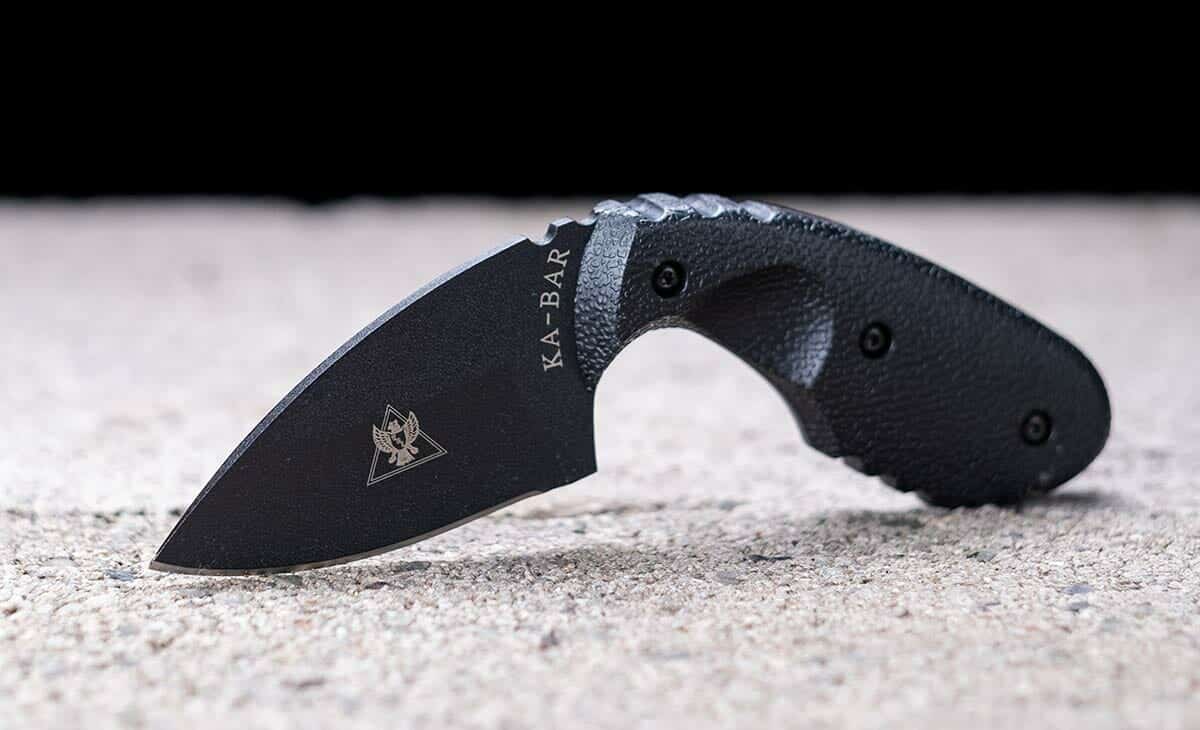
Designer John Benner makes a point of creating knives that can be drawn quickly. The TDI does that with a pistol grip style handle. The shaping of the knife doesn’t make it an especially natural slicer, but you will be able to get it into your hands quickly, and the grip at that point feels pretty secure.
KA Bar Ek Commando Short Clip Point
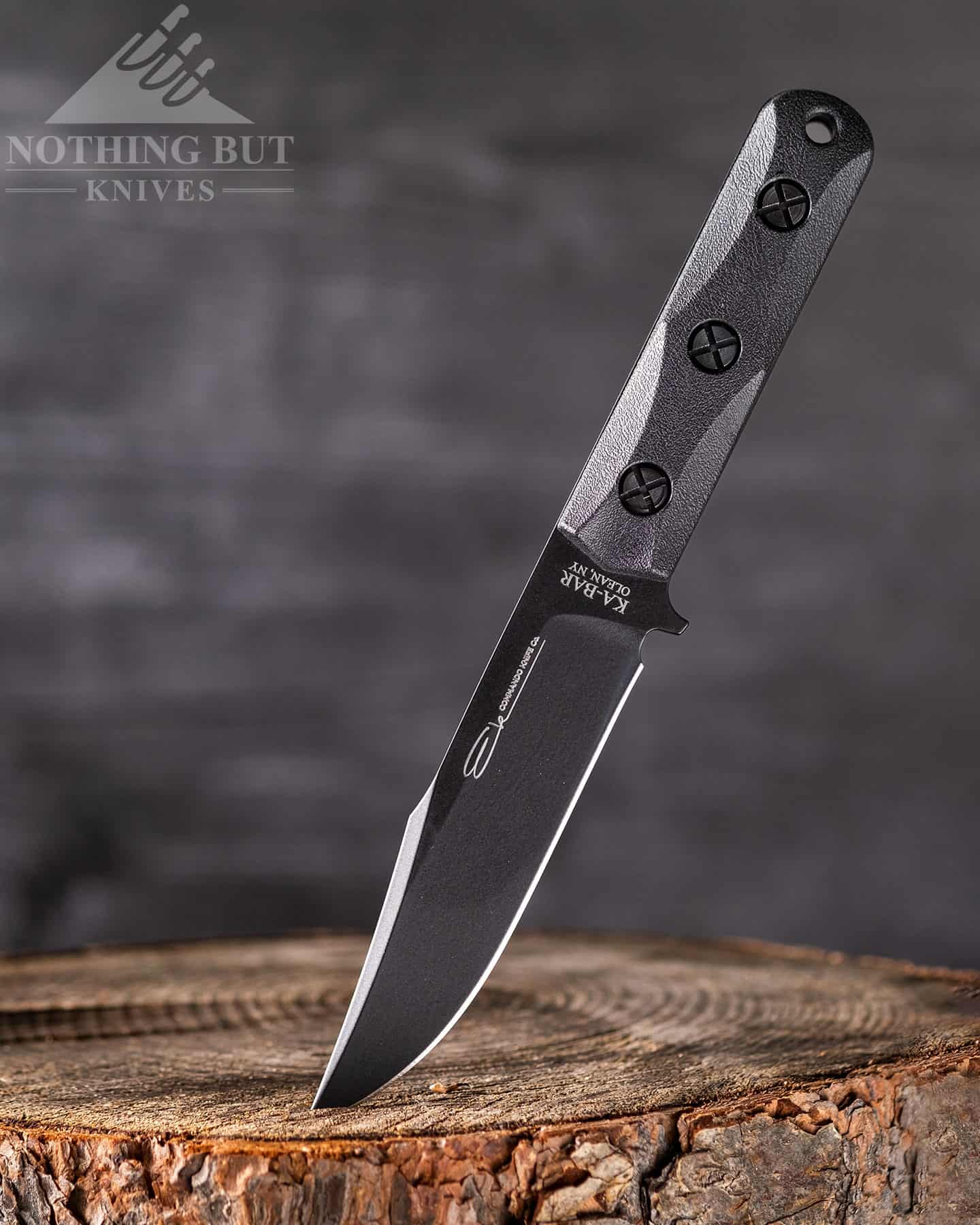
| Overall Length: | 9.25” |
| Blade Length: | 5.125” |
| Blade Steel: | 1095 Cro-Van |
| Blade Style: | Clip point |
| Handle Length: | 4.125” |
| Handle Material: | Ultramid polymer |
| Grind: | Flat |
| Build: | Full tang |
| Sheath: | Kydex |
| Price Range; | $90 – $120 |
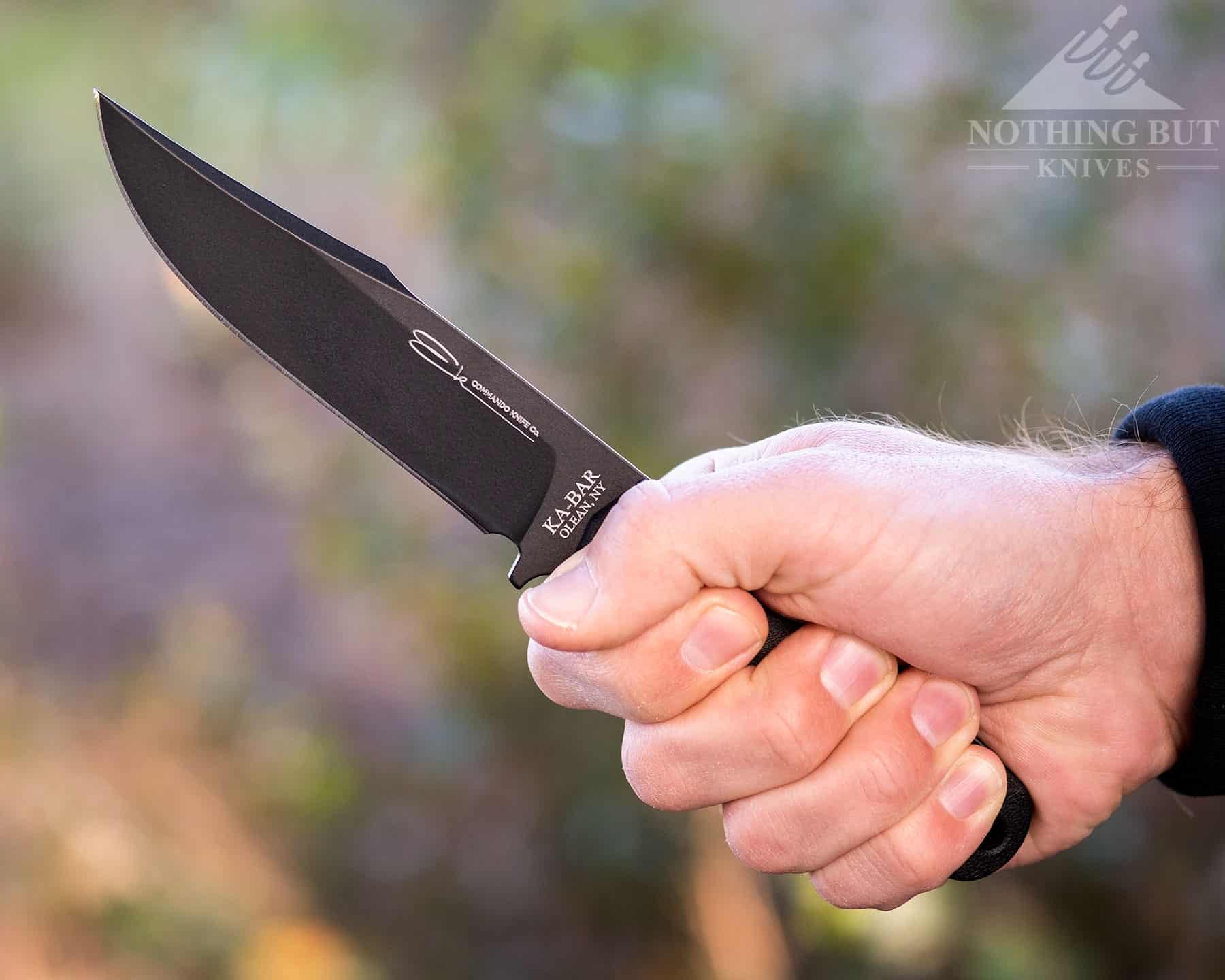
This is a neatly packed design with a little more blade than average for the size. Between the blade length and the neutral shape of the handle, there are a lot of different ways to viable hold and use the Ek Short.
Its main downside is that the handle is a little too smooth. Between that and the minimal finger guard there’s not a lot on this knife to keep your hand from slipping up onto the blade. It’s secure enough under normal circumstances, but it’s one of those things where you need to see how well you can hold onto the handle when it’s wet before you end up in risky situations.
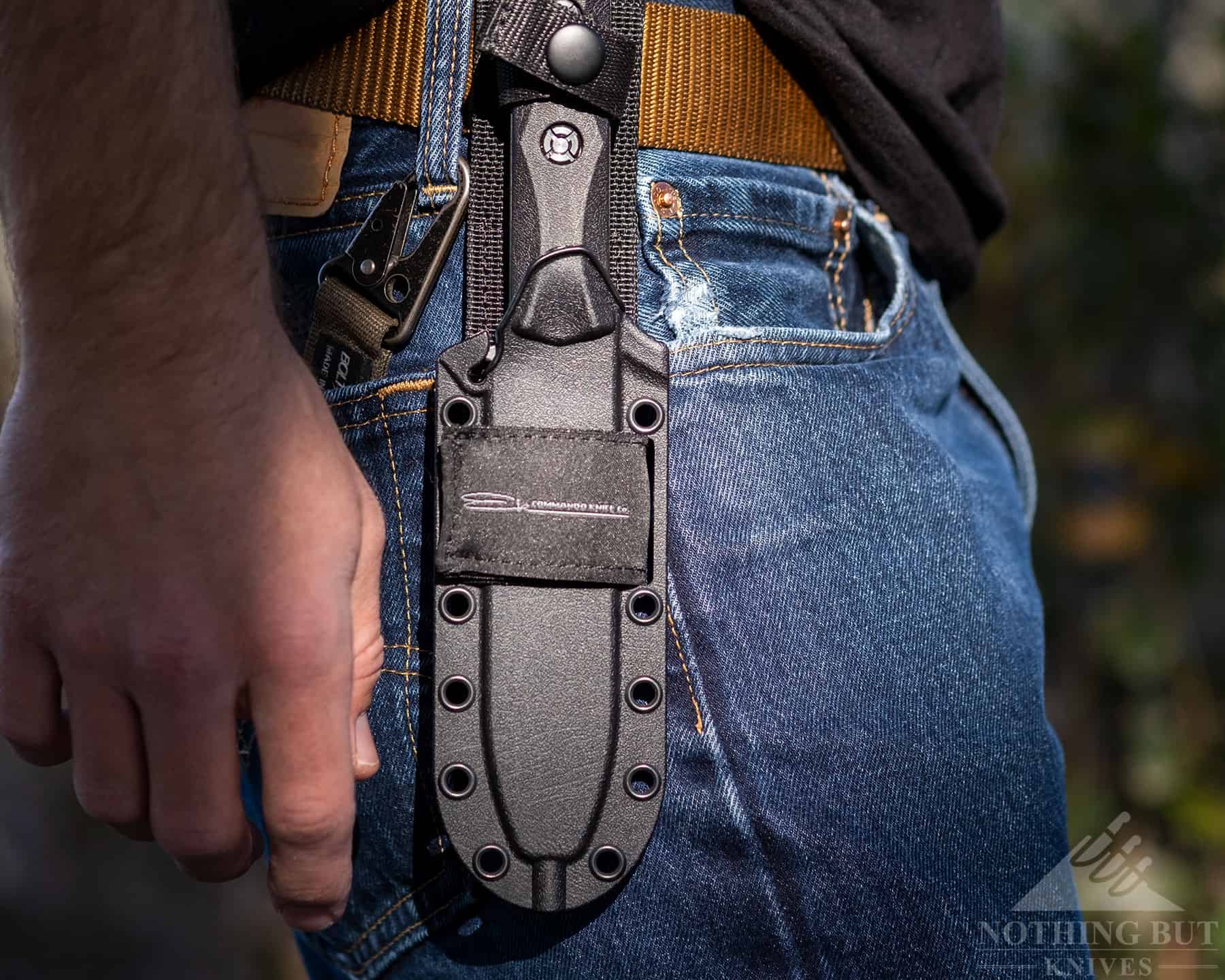
The sheath makes it very portable, though. The retention is in the sweet spot that holds the knife in well but doesn’t fight you when you need to draw fast. It also makes the knife sit in a surprisingly comfortable spot.
It’s one of the few fixed blades that I actually like to carry vertically on my hip, because it keeps the handle near where my hand swings but doesn’t butt into my side or dangle into my legs.
Ka Bar Becker BK7
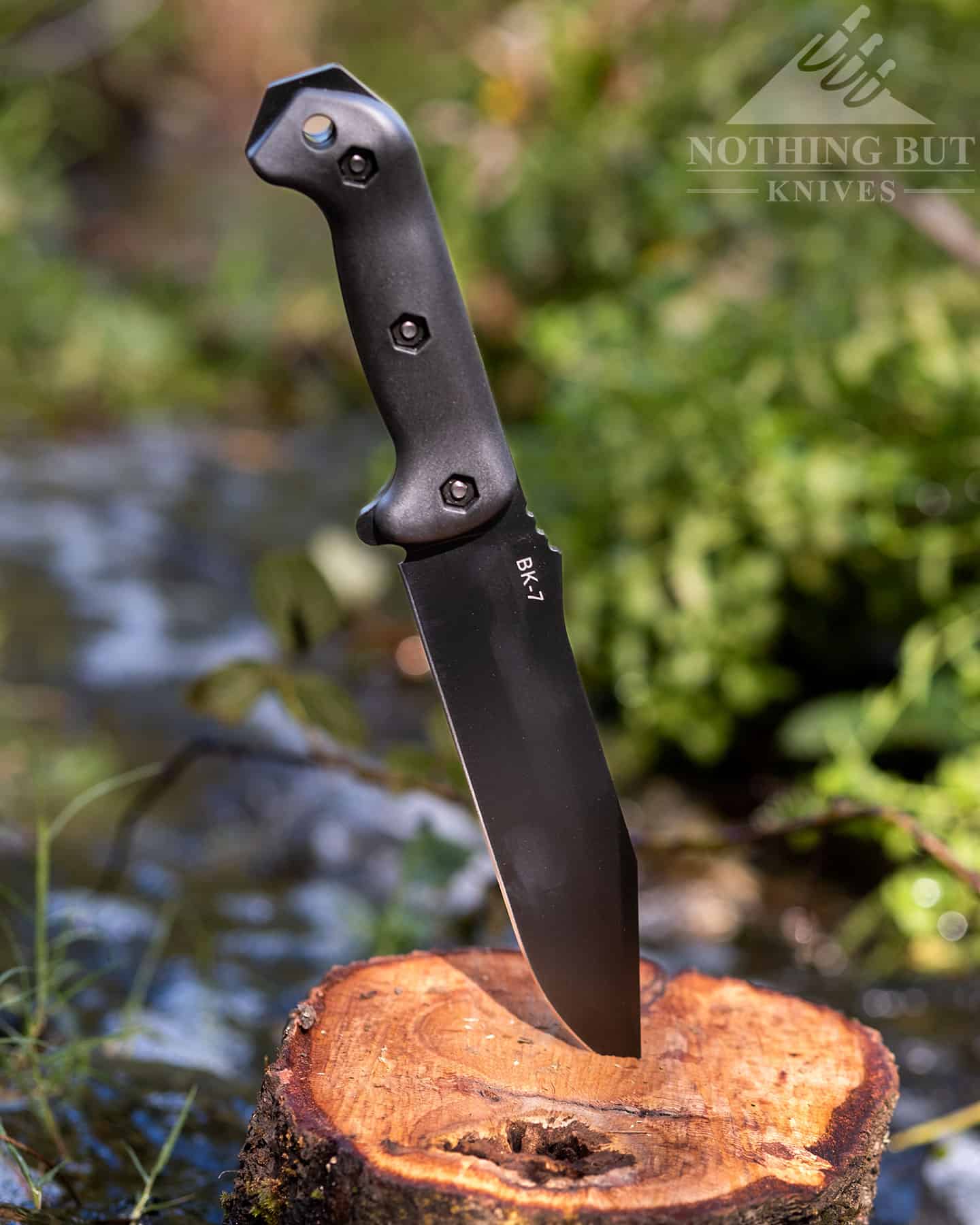
| Overall Length: | 12.75″ |
| Blade Length: | 7.0″ |
| Blade Steel: | 1095 Cro-Van |
| Blade Style: | Clip point |
| Handle Length: | 5.75″ |
| Handle Material: | Zytel |
| Grind: | Flat |
| Build: | Fixed blade |
| Sheath: | Nylon |
| Price Range; | $100 |
The obvious recommendation would be any of the variations of the USMC Bowie, of which Ka-Bar makes about thirty different kinds, but that would be like recommending Saving Private Ryan for someone looking for a good WWII movie: if you’re looking, you already know about it.
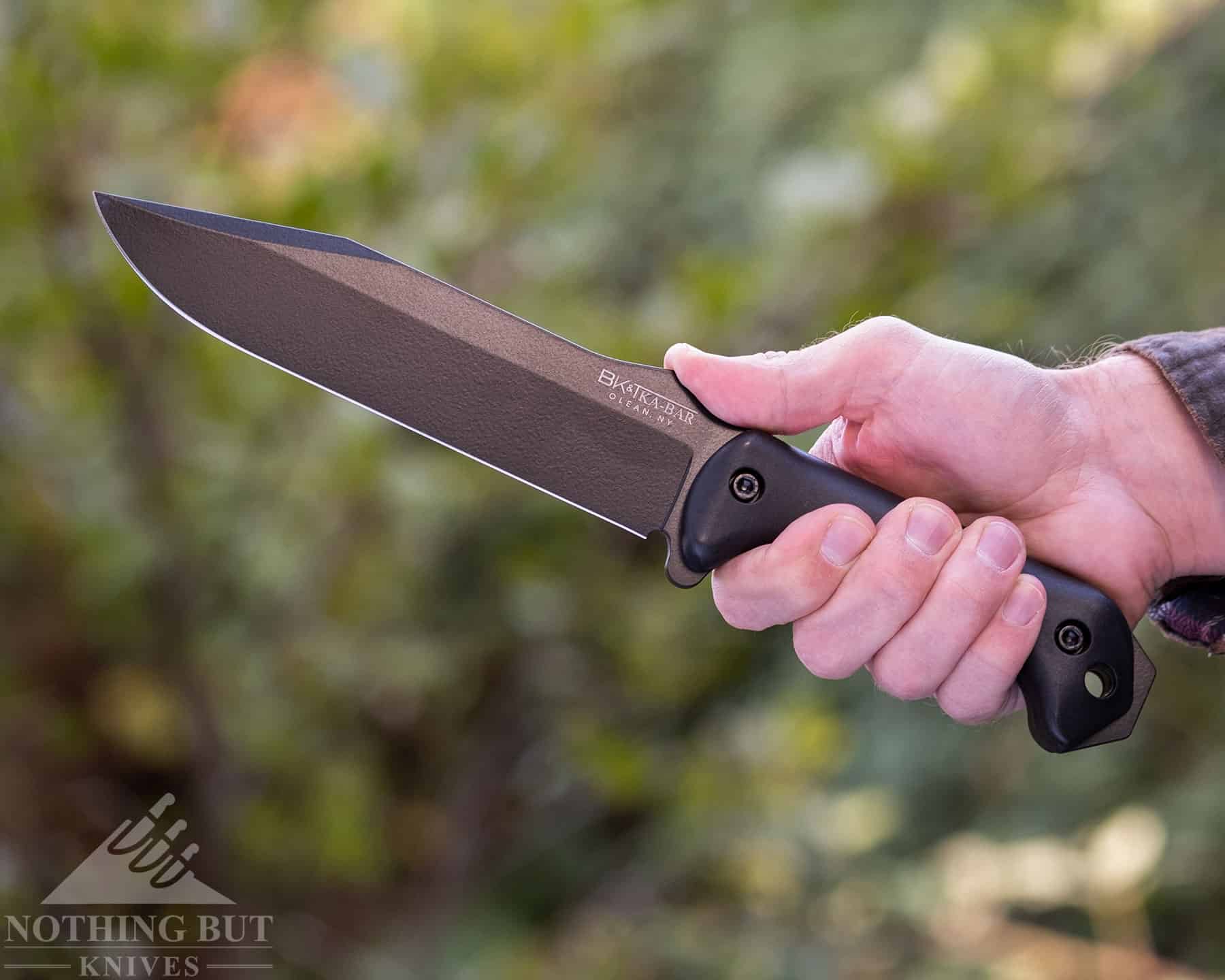
The stuff they make under the Becker flag tends to be more survival/adventure oriented than combat specific, but they’re mostly designed by Ethan Becker who’s a pretty avid outdoorsman and martial artist.
They make these knives to be fairly versatile in mostly wilderness and deployed military settings, including an insanely tough 1095CroVan steel and MOLLE compatible sheaths.
The BK7 in particular has a nice big handle that has a great full-handed grip in spite of the smooth texture. The shaping offers a minimal but effective hand guard, and it’s just a thick, pointy piece of steel that has a dozen reliable ways to get you out of a bad situation.
Ka Bar Short 1258
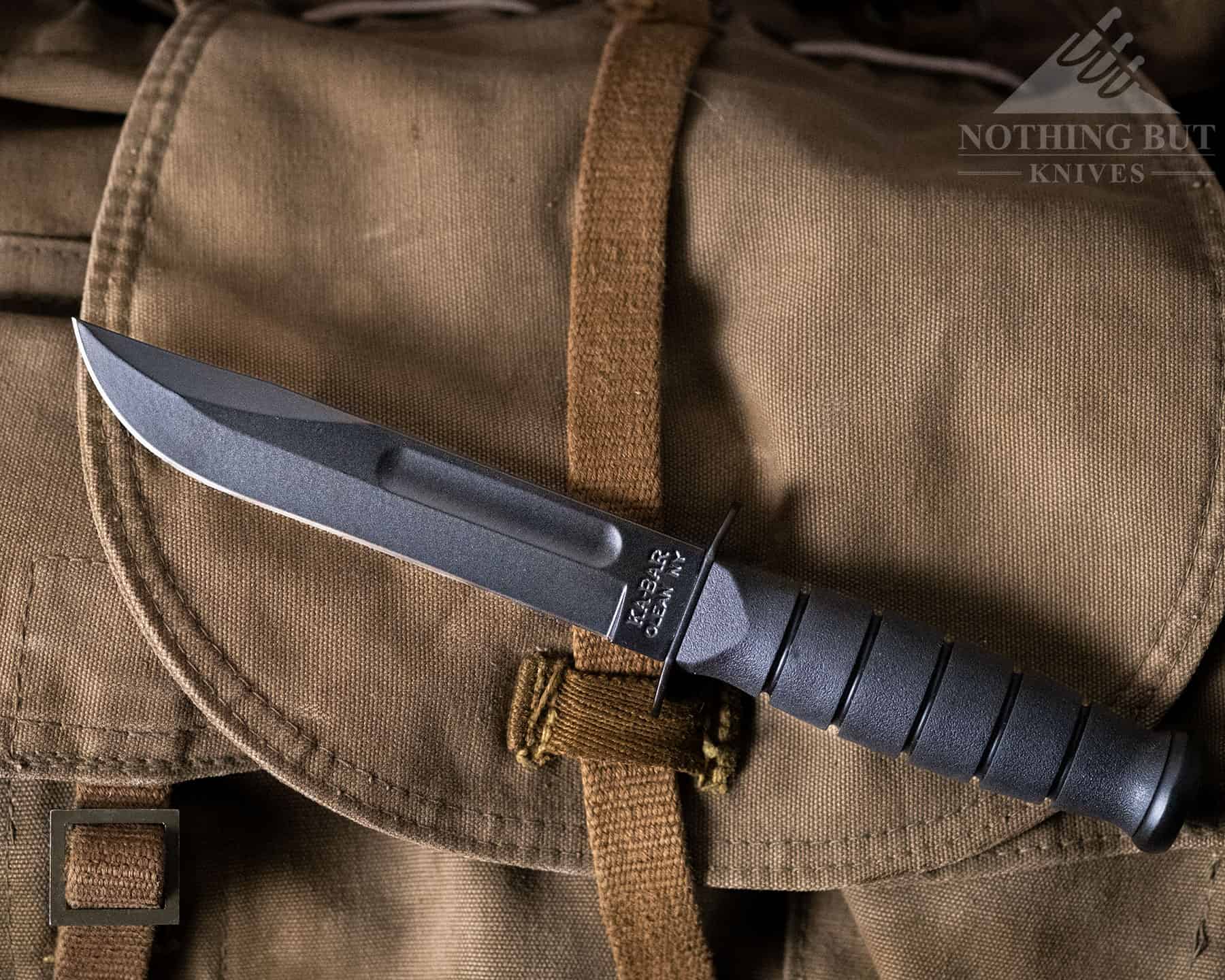
| Overall Length: | 9.25” |
| Blade Length: | 5.25” |
| Blade Steel: | 1095 Cro-Van |
| Blade Style: | Clip point |
| Handle Length: | 4.0” |
| Handle Material: | Kraton G |
| Grind: | Flat |
| Build: | Hidden tang |
| Sheath: | Kydex or leather |
| Price Range; | $90 – $112 |
The Mini version of the classic Ka Bar design still packs a pretty big punch. It touts the same tool steel and grippy Kraton handle, but it has a bit more of a locked-in feel in the hand.
The pommel and the hand guard fit really close around the hand so there’s a certain heightened sense of security. This knife isn’t leaving your hand for anything.
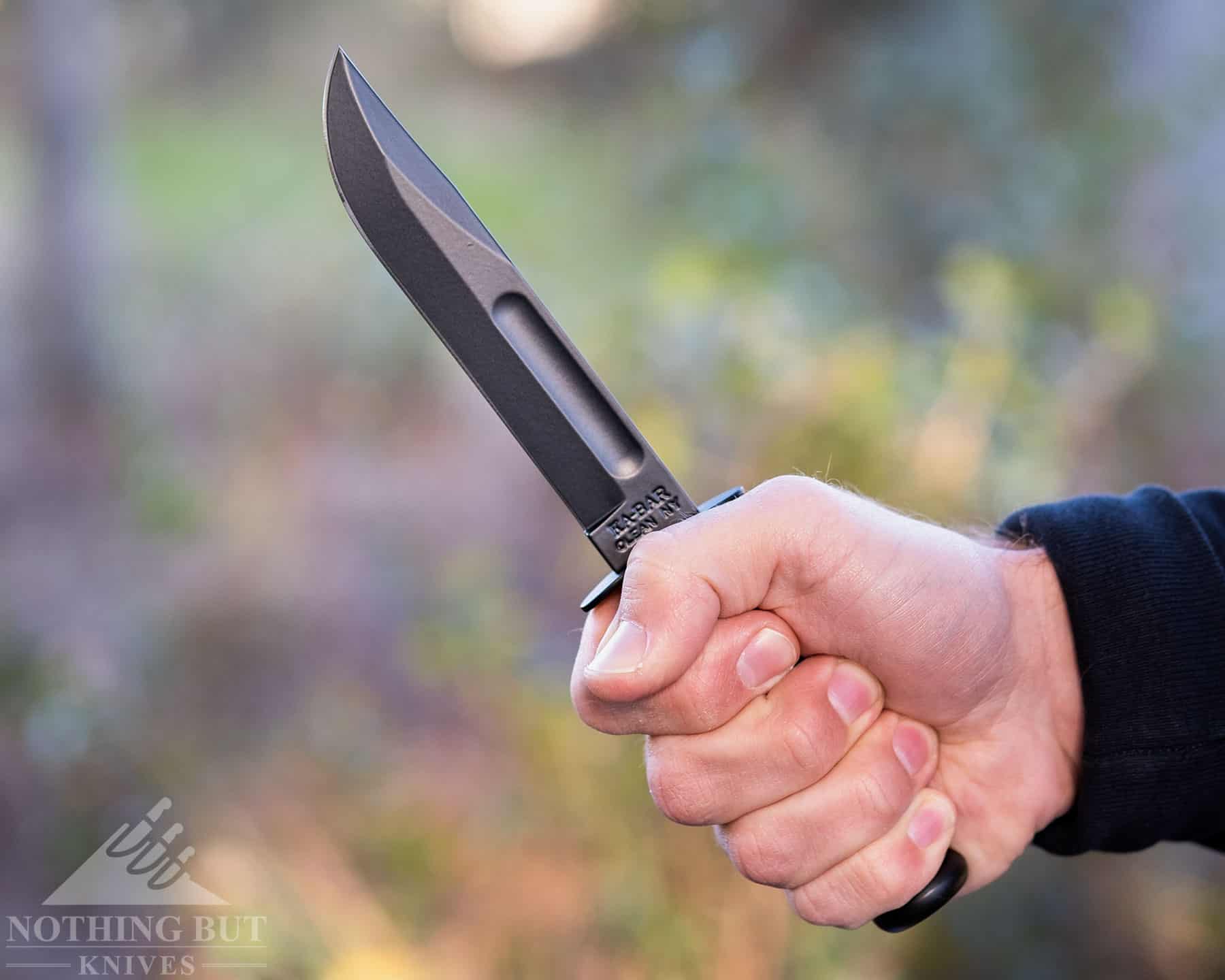
This size is also nice to carry. We picked up the version with the kydex sheath a while back and were really pleased with the strong retention and the light feel of it on the hip, even as a vertical carry.
Plus it has an extra retention strap that buttons around to the front if you plan on packing it upside down or jumping out of planes with it.
Kershaw
| Pros: Fast deployment, good manufacturing |
| Cons: No fixed-blade tactical options |
Kershaw’s predilection to folders makes their legitimate tactical options few and far between, but the good ones they do make are not only tough and useful, but very cost-effective.
And, no surprise, most of the good tactical designs under the Kershaw brand have Emerson’s name in front of them.
Kershaw’s manufacturing is pretty seamless, especially for a budget brand. Even when they use cheap materials they tend to make knives that perform better for the money than half of what’s out there.
Kershaw Emerson CQC 10K
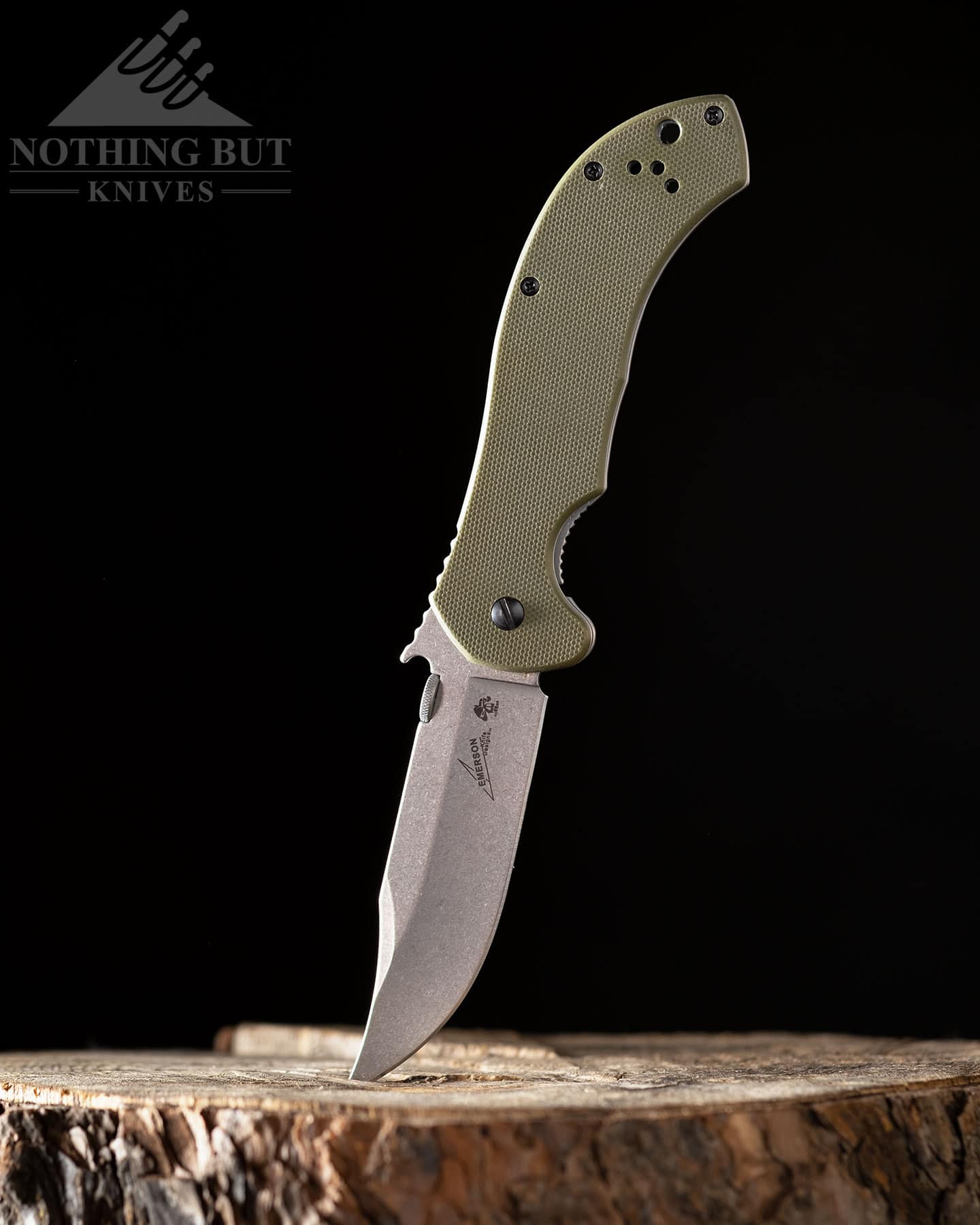
| Overall Length: | 7.75″ |
| Blade Length: | 3.25″ |
| Blade Shape: | Tanto, drop point, or clip point |
| Steel: | 8Cr13MoV |
| Handle Length: | 4.5″ |
| Handle Material: | G-10 |
| Grind: | Hollow |
| Build: | Frame-lock folder |
| Carry System: | Tip-up clip |
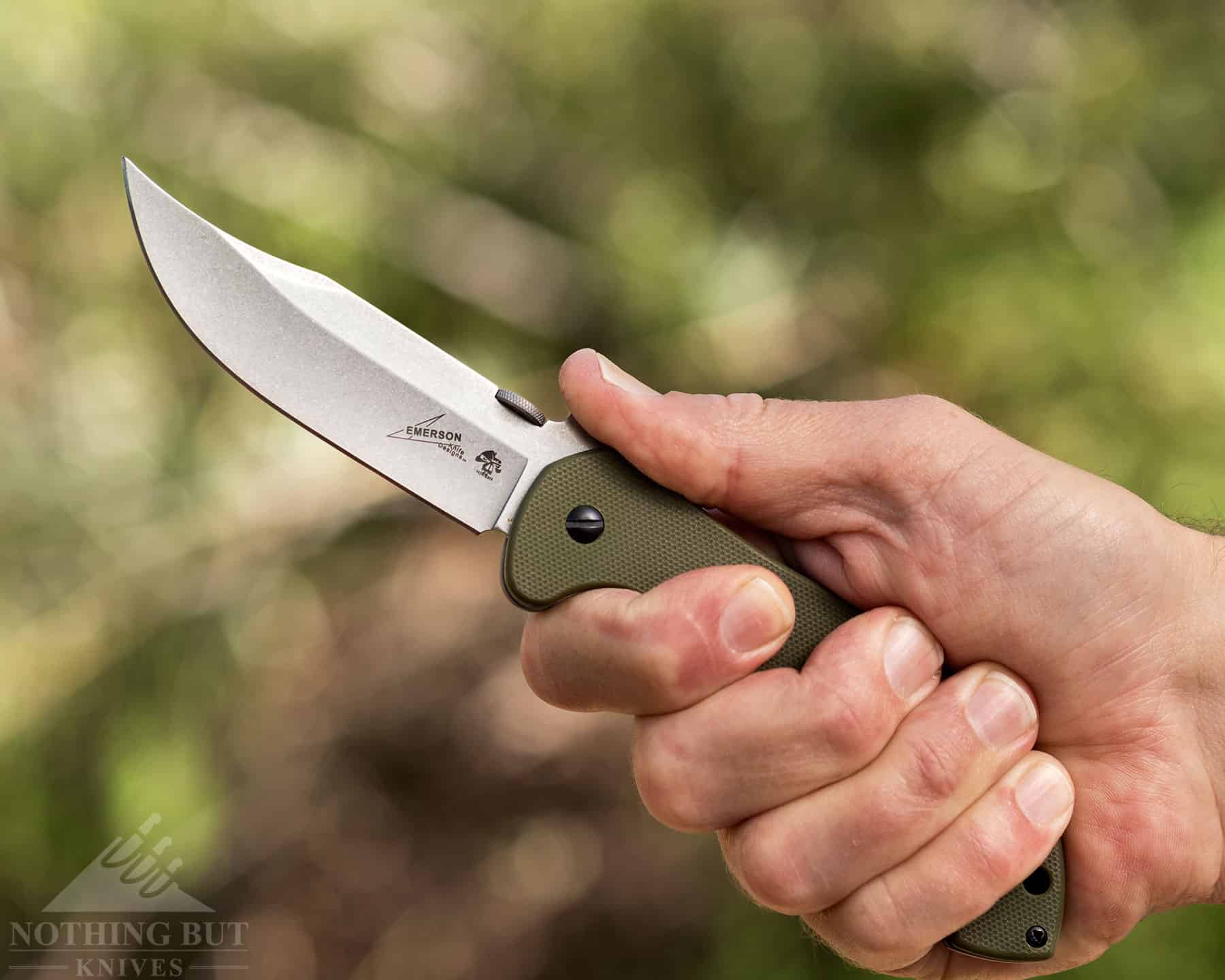
All the CQC designs are essentially the same besides the size, so it would be odd to recommend one over the other. The important thing is that these were all designed for fast deployment. Getting the Emerson wave to deploy out of your pocket takes some practice, but it’s easily one of the quickest folders out there once you get the motion down (it can be a little rough on the pocket, though).
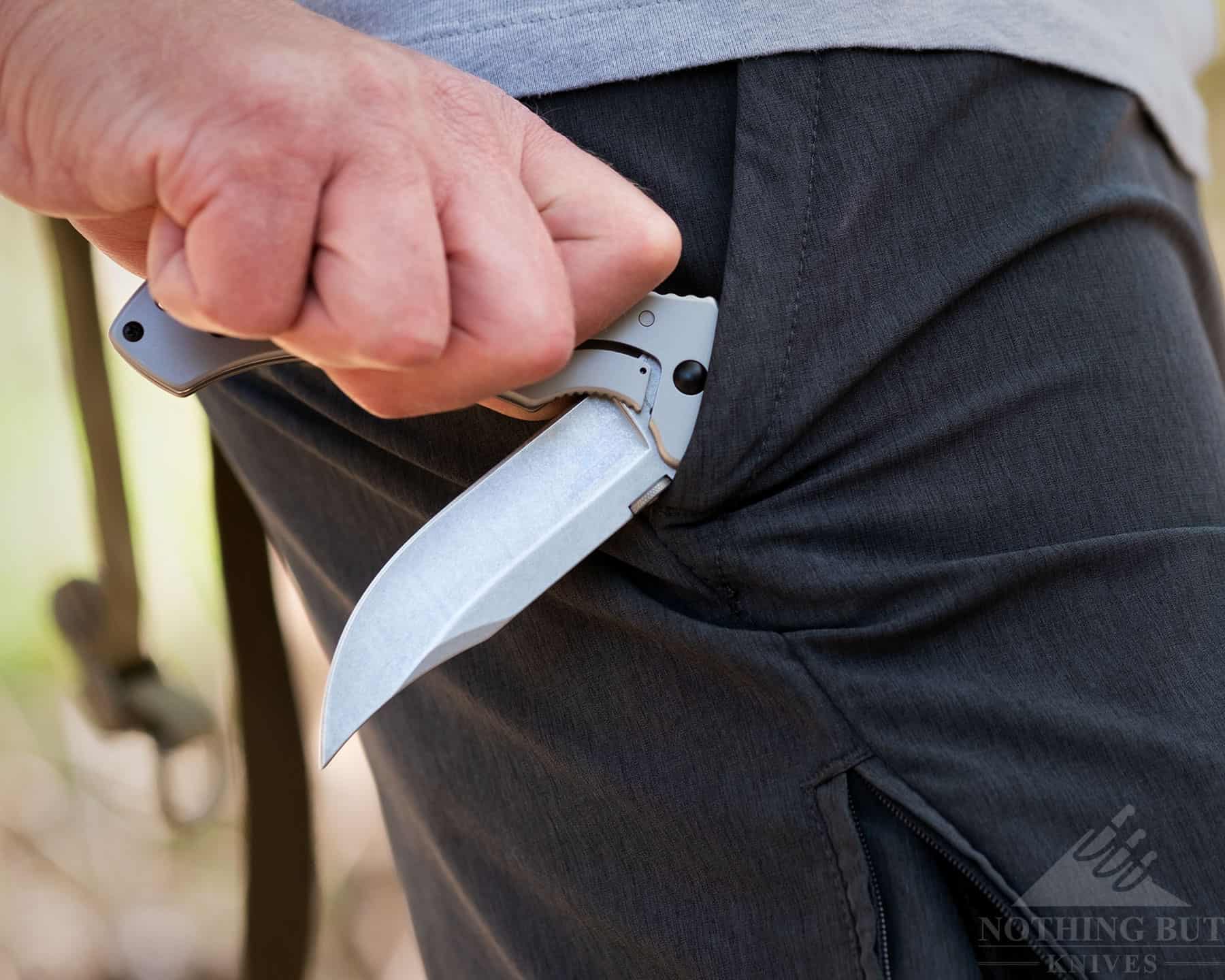
Of course, once the CQC is out you’re still holding a folding knife, and that’s not ideal in most “tactical” situations, but often speed is one of the most important factors, and the frame lock on this offers pretty good integrity as far as locks go.
Kershaw Livewire
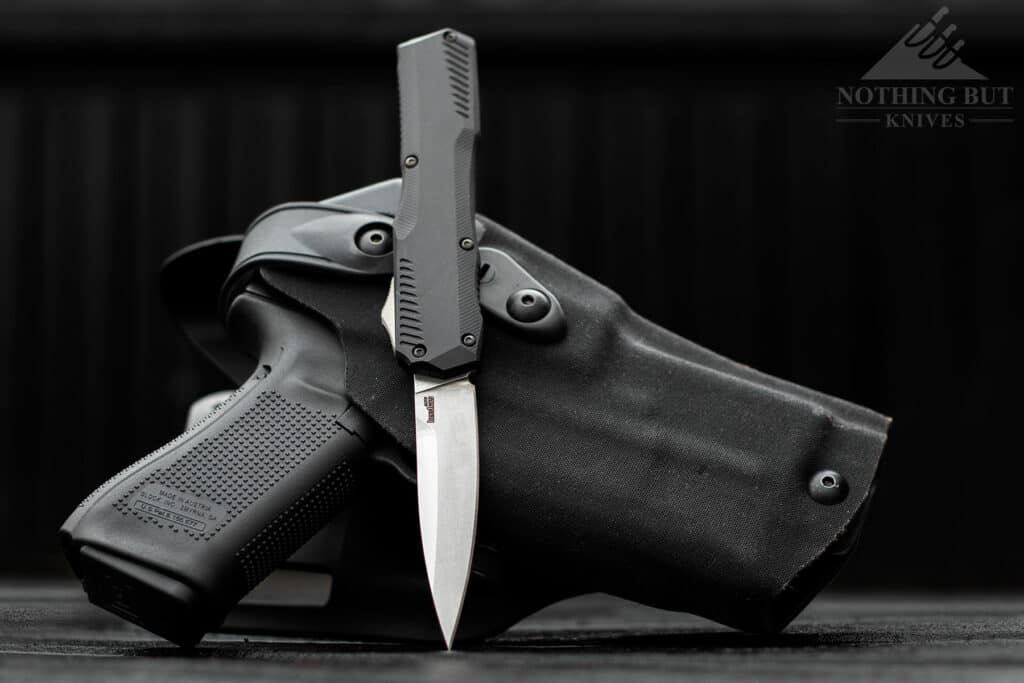
Kershaw recently released their first American made OTF auto. True to form Kershaw offers impressive action and fit and finish for that cost. That is not to say it is a budget knife, but at its current price point of around $240 it competes with tactical autos that cost twice as much.
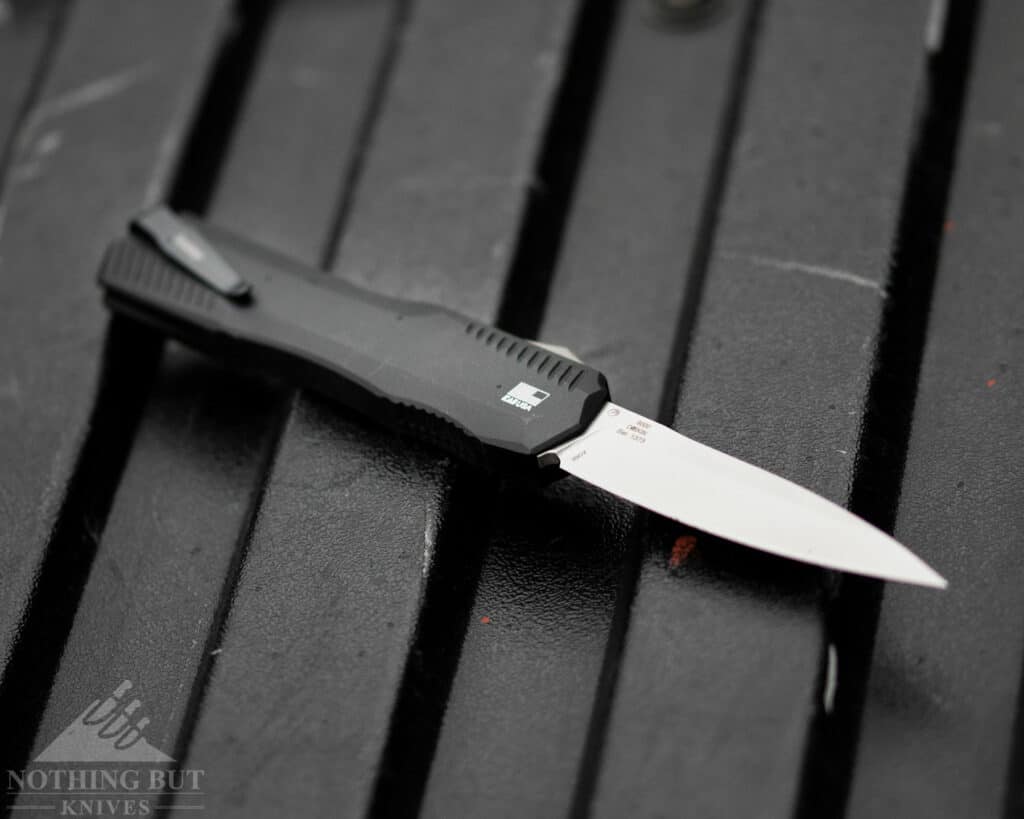
Kershaw built in a few safety features to the Livewire that help prevent accidents without totally compromising the knife’s tactical first purpose. This is not something that can be said about a lot of competing OTF models.
The Livewire is a great choice for anyone curious about OTF knives who lives where they are legal.
You can learn more about this snappy tactical OTF by reading out Kershaw Livewire Review.
Kizer
| Pros: Great designs in decent price ranges. |
| Cons: Designs are often a “jack of all trades, master of none” situation |
This is not a company we ever expected to put on this list, but the design team really started pushing out of their comfort zone around 2020. All of a sudden this slick EDC company changed gears from nifty folders to compact fixed blades that kept up with a lot of established tactical and bushcraft knives.
Kizer Harpoon
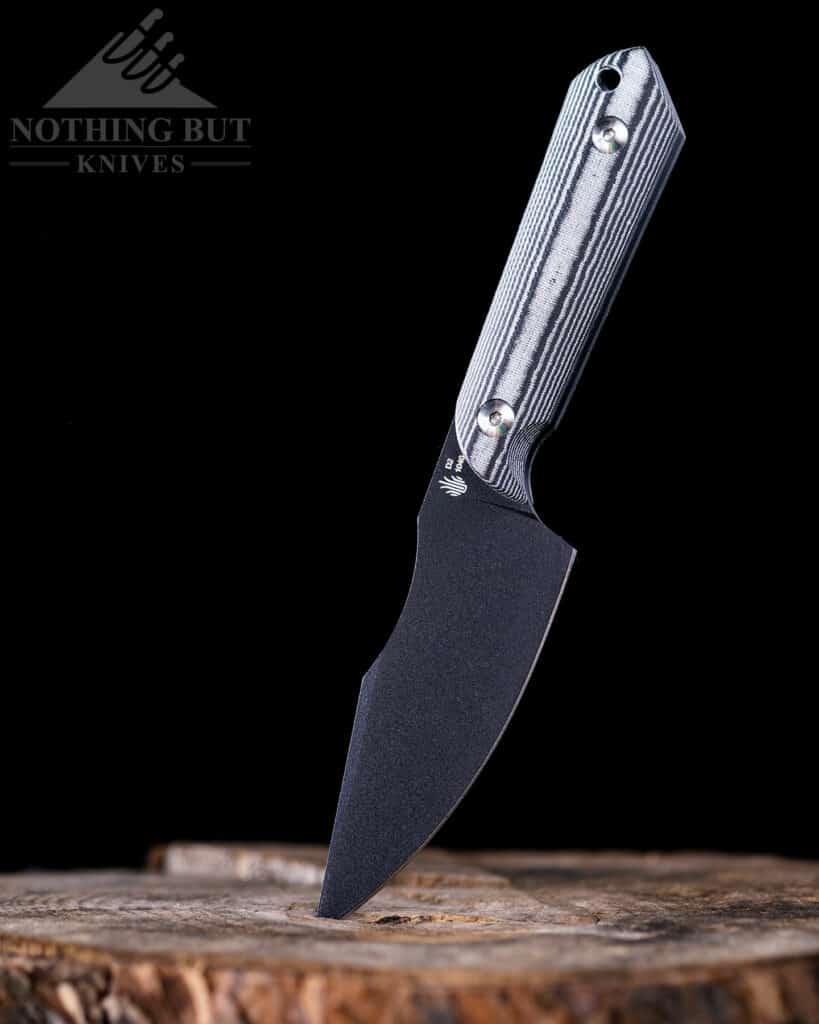
| Overall Length: | 7.75” |
| Blade Length: | 3.875” |
| Blade Shape: | Harpoon |
| Steel: | D2 |
| Handle Length: | 3.875” |
| Handle Material: | Micarta |
| Grind: | Flat |
| Build: | Fixed blade |
| Carry type: | Kydex sheath w/ snap loops |
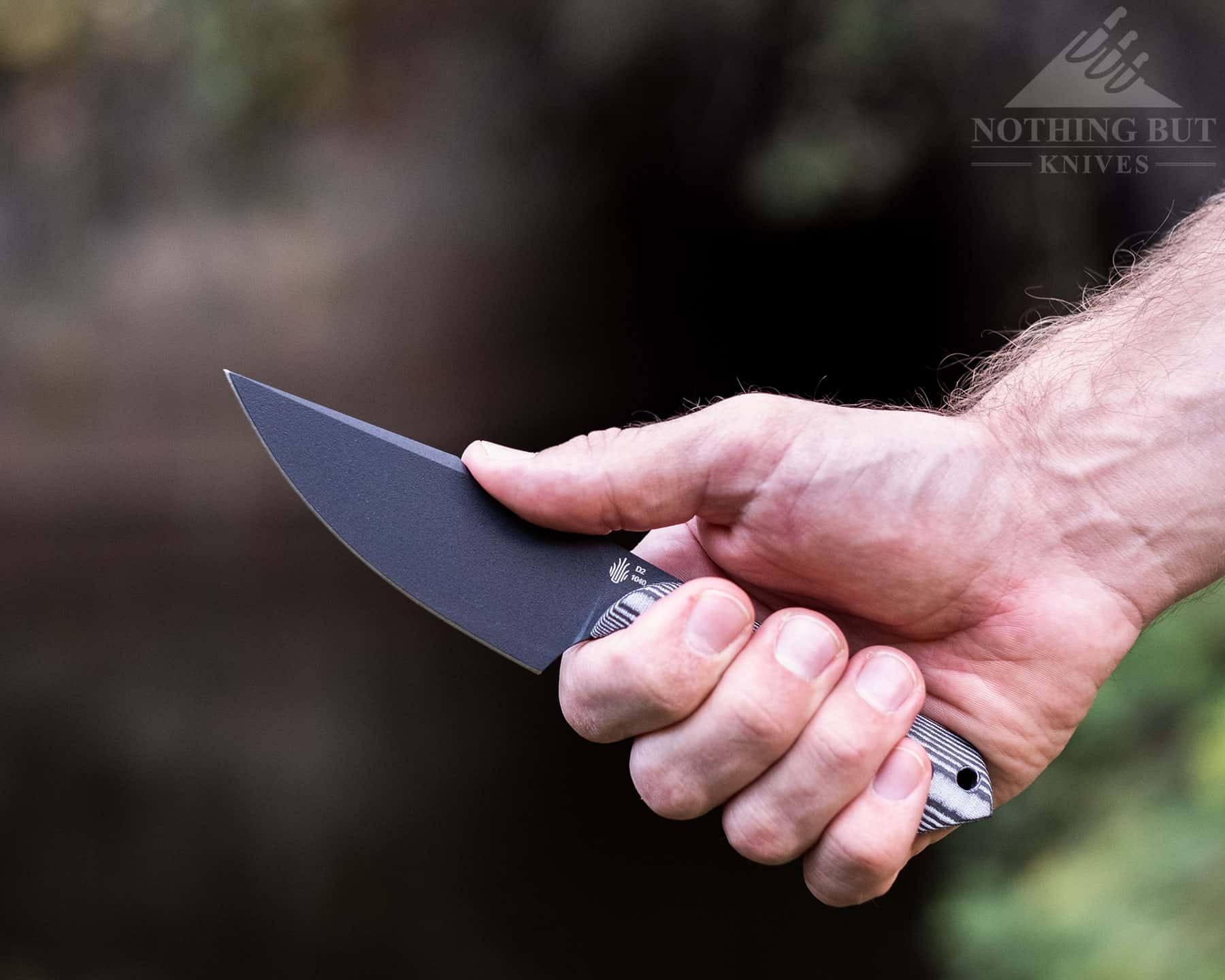
This collaboration with James Buckley of Maverick Customs brings a combination of curvy slicing ability and blade ergonomics roughly similar to the Ka Bar BK-18. Buckley likes to play with those dips in the spine for the thumb, though, bringing this design a little more in line with precision-cutting philosophies.
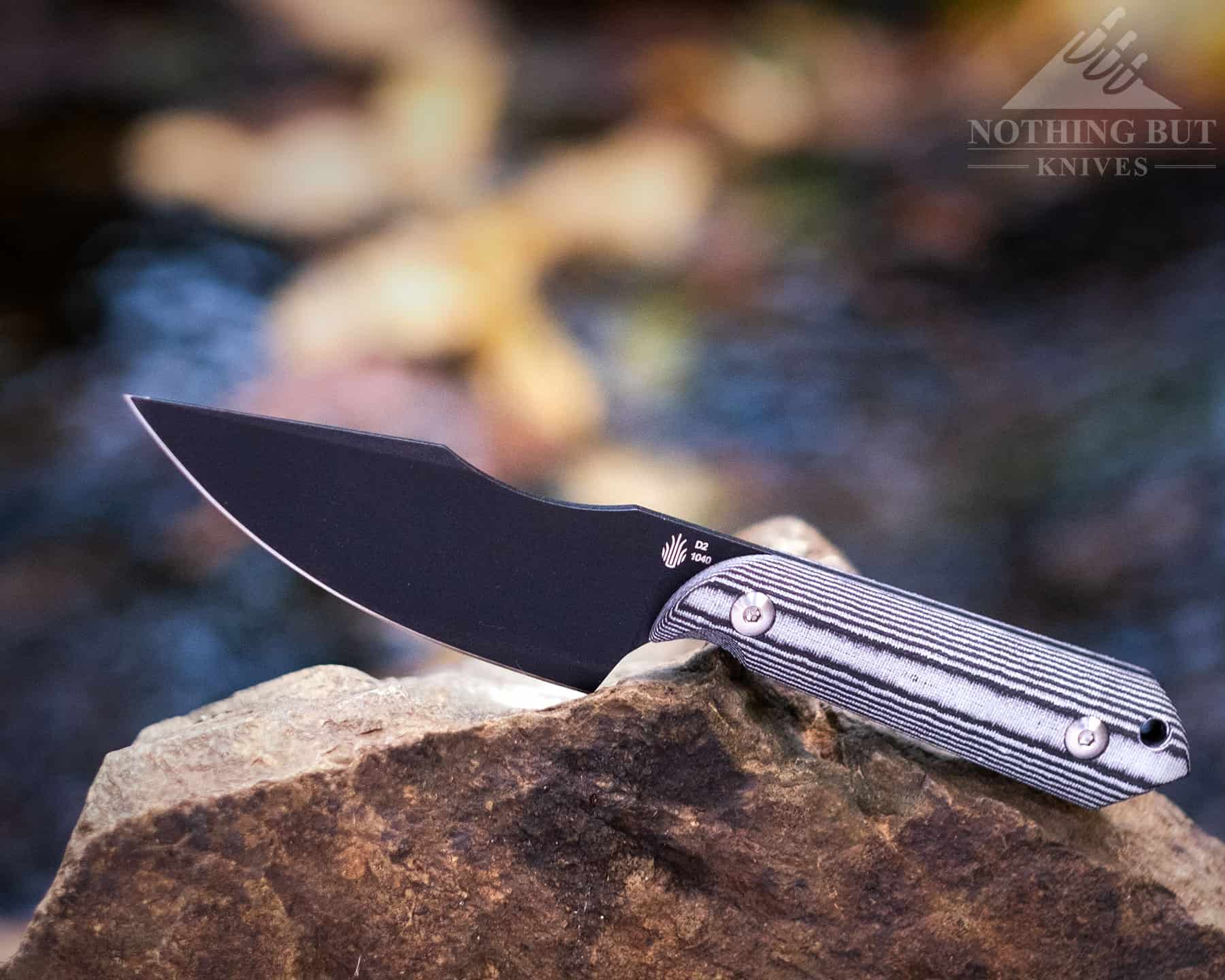
It carries pretty snugly on the belt. I always feel like I have good mobility when I pack this knife, and the Micarta handle is pretty dry so it has some really good grip to it. It will get dirty quickly, though, and dry Micarta is a lot harder to clean, so keep that in mind.
The steel is another tricky element. In general I would say D2 isn’t the best tactical option because its toughness and edge retention depend so much on the people treating and grinding it. I’ve learned to trust Kizer’s D2 steel, though. Their heat treat along with a coating is good enough for me to trust in dire situations.
Morakniv
| Pros: Very tough knives with a lot of carry options. |
| Cons: Geared more for tough wilderness use than rapid tactical use. |
This is a survival and hunting knife company first, so rarely the first thing most people think of when they think of tactical designs. But in that sense, they’re kind of like ESEE (or ESEE is just the American version of Mora). They make their knives so well and for so many variations that you can find a way to make them good for any situation.
Mora Black
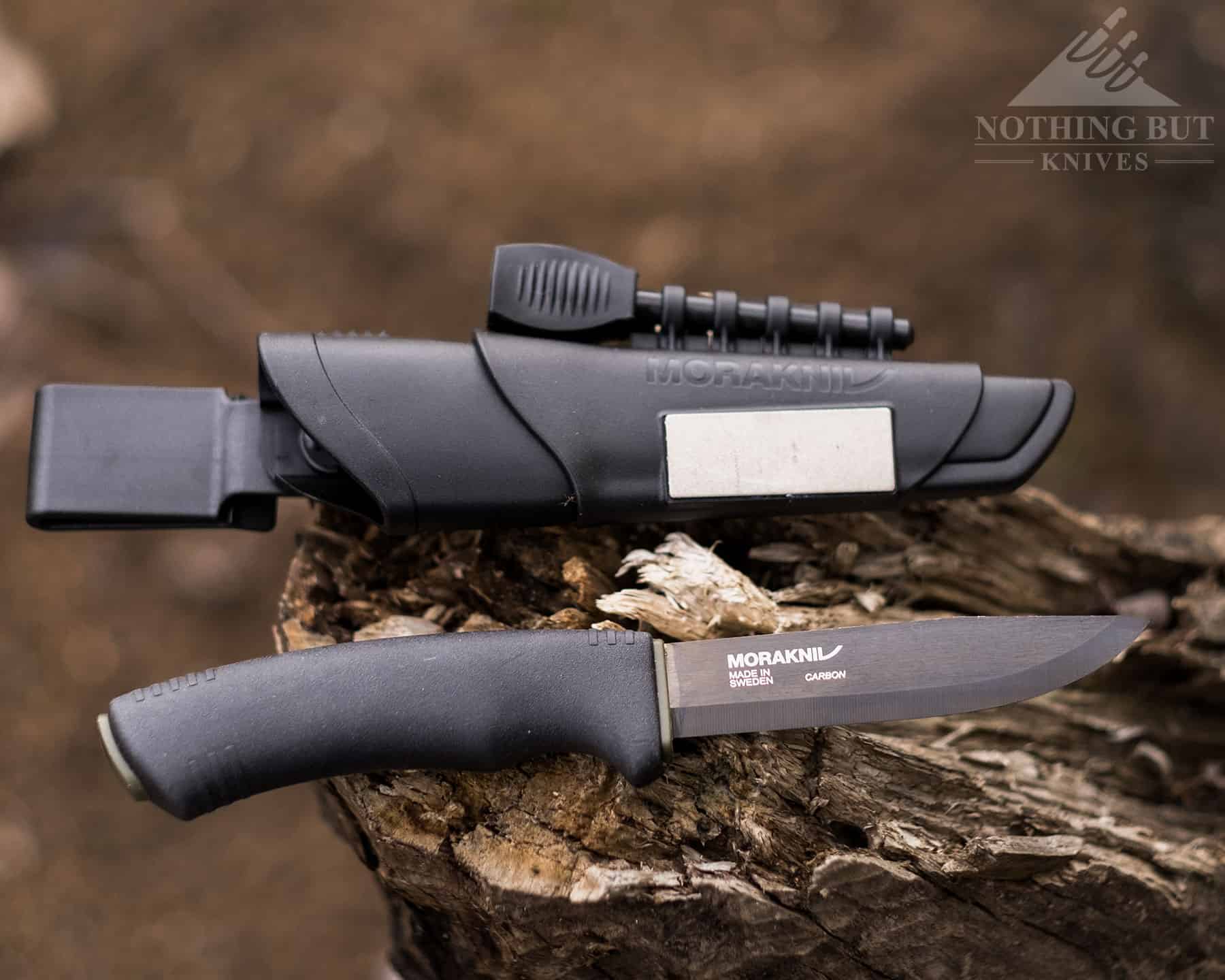
| Overall Length: | 8.625” |
| Blade Length: | 4.0” |
| Blade Shape: | Standard |
| Steel: | Stainless or carbon |
| Handle Length: | 4.625” |
| Handle Material: | Rubber |
| Grind: | Scandi |
| Build: | Fixed blade |
| Carry type: | Polymer sheath |
It doesn’t look like much, but it carries light and the rubber handle gives you a hell of a grip. Don’t even worry about the fact that it isn’t full tang. The handle can take a lot of impact. Decades of hunters and survivalists can attest to that.
And don’t even mind the nameless steel in the specs. Mora probably uses 12C27 or something close for its stainless steel, and the carbon seems seems to be something that behaves similarly just with an extra bit of toughness and less corrosion resistance. Regardless, they have their heat treat dialed to handle exactly what the knife was designed for: cutting in extreme conditions.
One thing holding it back is that Mora doesn’t really make sheaths with quick deployment in mind. They’re always light and can be stuffed pretty much anywhere on your pack or in your pocket, but they tend to ride deep.
Off-Grid Knives
| Pros: Great durability, versatile designs, good prices |
| Cons: Off-Grid’s fixed blades aren’t always great tactical options, but they are great bushcraft options. |
We our big fans of Off-Grid here at Nothing But Knives. They are primarily a hard-use, camping and bushcraft style knife company, but lately they have come out with some excellent tactical designs as well. One of the design characteristics that set Off-Grid knives apart are their large easy-to-grip handles. They are even easy to grip firmly even when wet which makes them a good choice for emergency situations.
Another great thing about Off-Grid is that the blade designs of several models are a good option for both tactical or practical situations. They are a good choice for work knives that may need to double as a tactical tool if things get crazy.
Off-Grid Enforcer XL
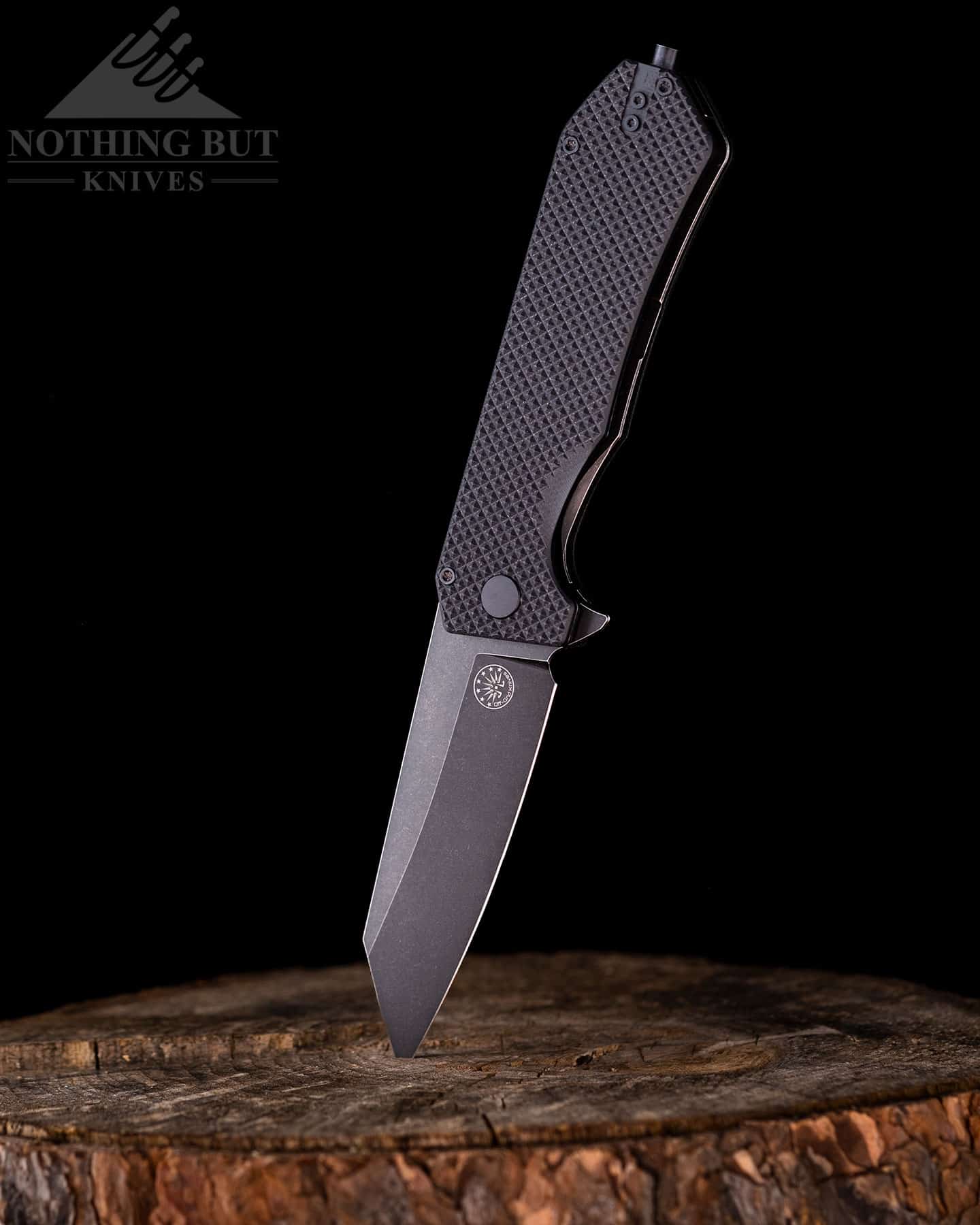
| Overall Length: | 9.2″ |
| Blade Length: | 4″ |
| Blade Shape: | Clip Point / Reverse Tanto |
| Steel: | D2 |
| Handle Length: | 5.2″ |
| Handle Material: | G-10 |
| Grind: | Flat |
| Lock: | Liner |
| Pocket Clip: | Ambidextrous |
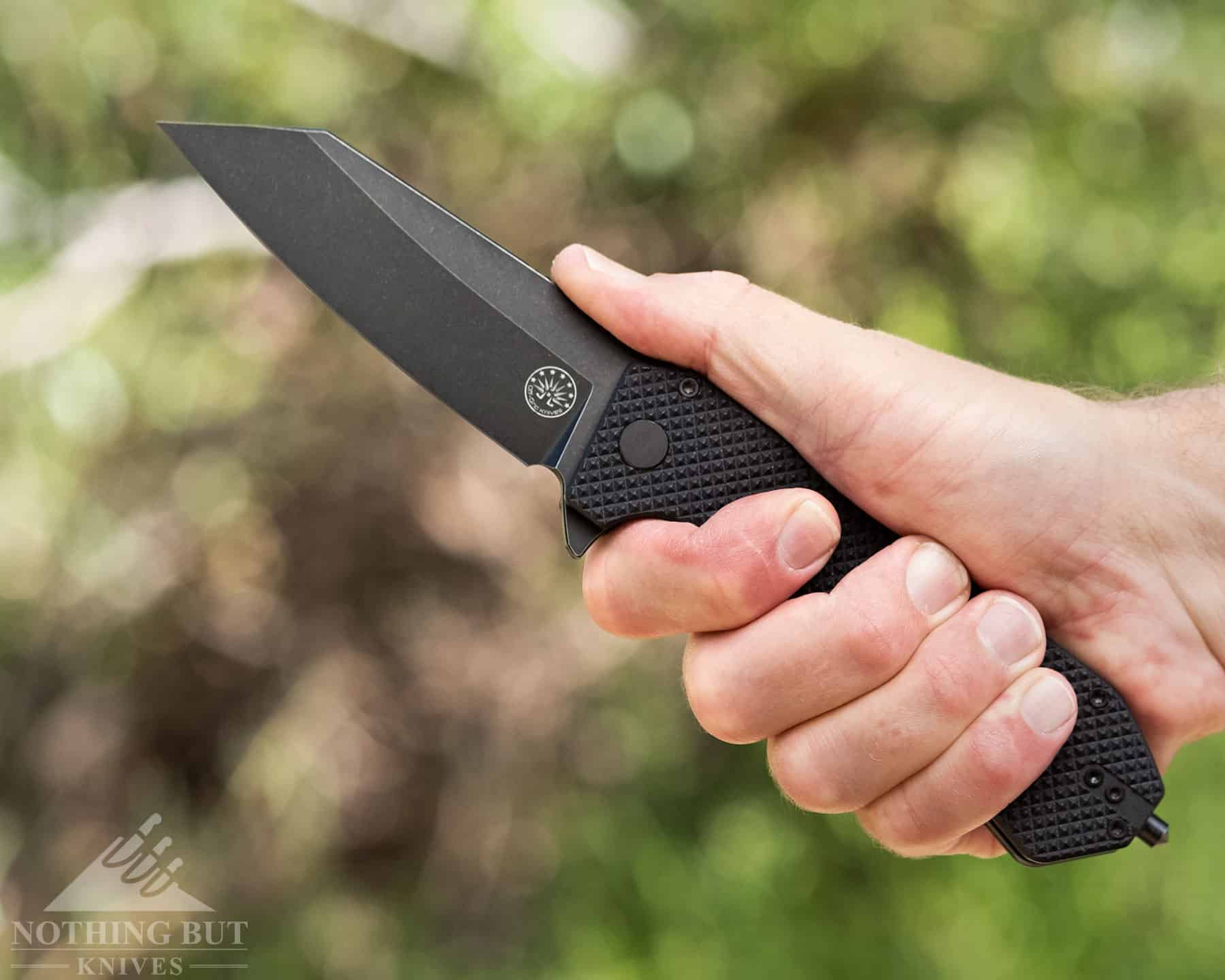
The Enforcer XL has some pretty impressive specs considering its sub-$100 price point. Its 4mm thick blade can take a beating and slices like a dream. The reverse tanto blade shape also makes it a very strong slicer all the way up to the tip of the knife.
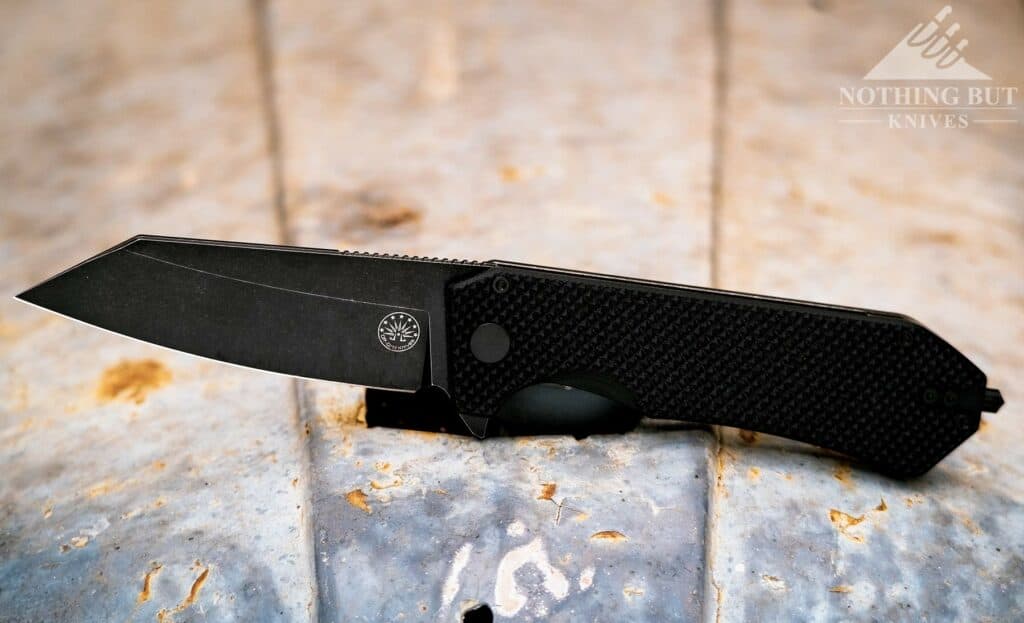
The thick handle and glass breaker also make this a scary knife. It was intentionally made so that your hand is kept a good distance from the breaker when you actually need to break glass with it. As far as breakers go, the Enforcer XL is probably the most comfortable and easiest to actually use than just about anything we’ve tested.
The aggressive texturing on the Enforcer’s handle makes this knife easy to grip even in wet conditions, but it is also hard on the pocket. It will leave a mark on the pockets of jeans after extended use, but the Enforcer handle is no where near as destructive to pockets as the popular Benchmade Redoubt.
If you are anti glass breaker and pro spear point blade, check out the Off-Grid Stinger XL. It has similar dimensions to the Enforcer XL, but the handle has a more mild form of texturing, and the blade is double edged adjacent.
Off-Grid Caiman
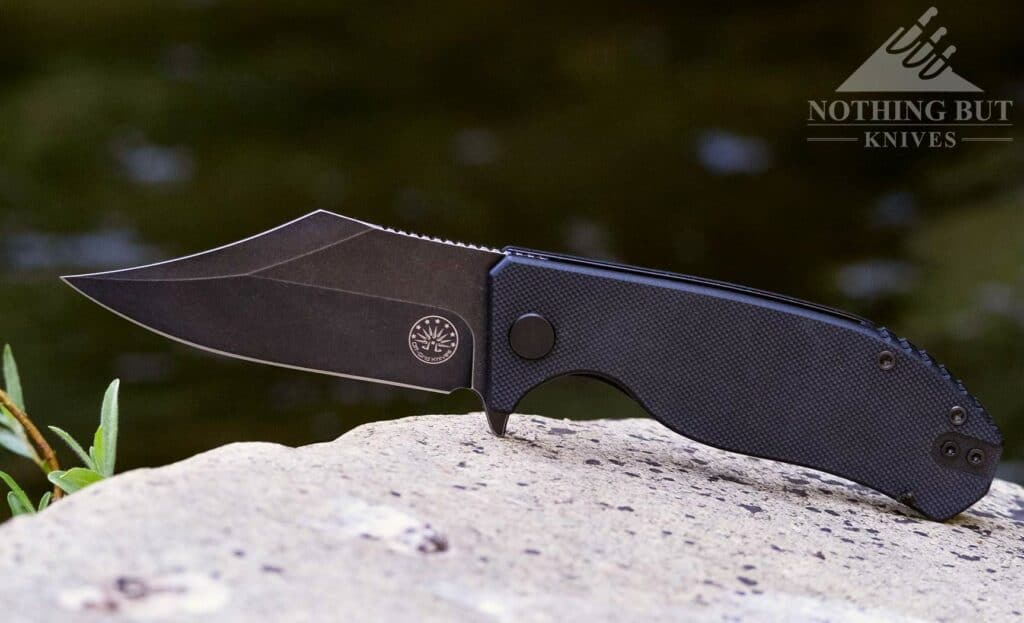
| Overall Length: | 7.6″ |
| Blade Length: | 3.5″ |
| Blade Shape: | Clip Point |
| Steel: | D2 |
| Handle Length: | 4.1″ |
| Handle Material: | G-10 |
| Grind: | Flat |
| Lock: | Liner |
| Pocket Clip: | Ambidextrous |
A folding bowie knife seems like a no-brainer as a tactical option. It carries well in the pocket, it has a mean edge, and the clip point is so severe it doesn’t take much force to get it through cloth.
The one thing that makes me nervous is that it’s a liner lock. But the lock up has stayed pretty secure for all the time we’ve carried it (and we’ve carried it a lot), and the flipper tab doubles as a generous guard that would stop on your index finger before the blade ever came down on your hand.
The normal sized version of this has great ergonomics in the pocket and the hand. Actually it has one of the most comfortable four-finger grips I’ve felt on any folding knife. But I should also point out that Off Grid came out with an XL version with a 4 inch blade. I don’t always hold to the view that bigger is better, but the XL version keeps a lot of the same ergonomic feeling of the original while adding on a lot of helpful distance and material.
Check out our full review of the Caiman if you’d like to read more about it.
SOG
| Pros: Tough designs overall, clear and practical function |
| Cons: High price tag, or rough build quality in lower price ranges |
On the whole, SOG tries too hard for me to actually trust the bulk of their tactical knives. But none of the other major knife companies try so often as them to make tactical stuff, so statistically speaking they have to have a few good designs, right?
When that happens with SOG, it’s usually because they’ve brought in some military mind who has an idea based on a problem’s he’s had in the field. So their good tactical knives are very purposefully built with clear emergency situations in mind during the whole design phase.
SOG’s fixed blade tactical knives made them famous, but they have some great folding knives that are good self defense options such as: the Vision XR, the Pentagon or the Aegis AT.
SOG Seal Pup Elite
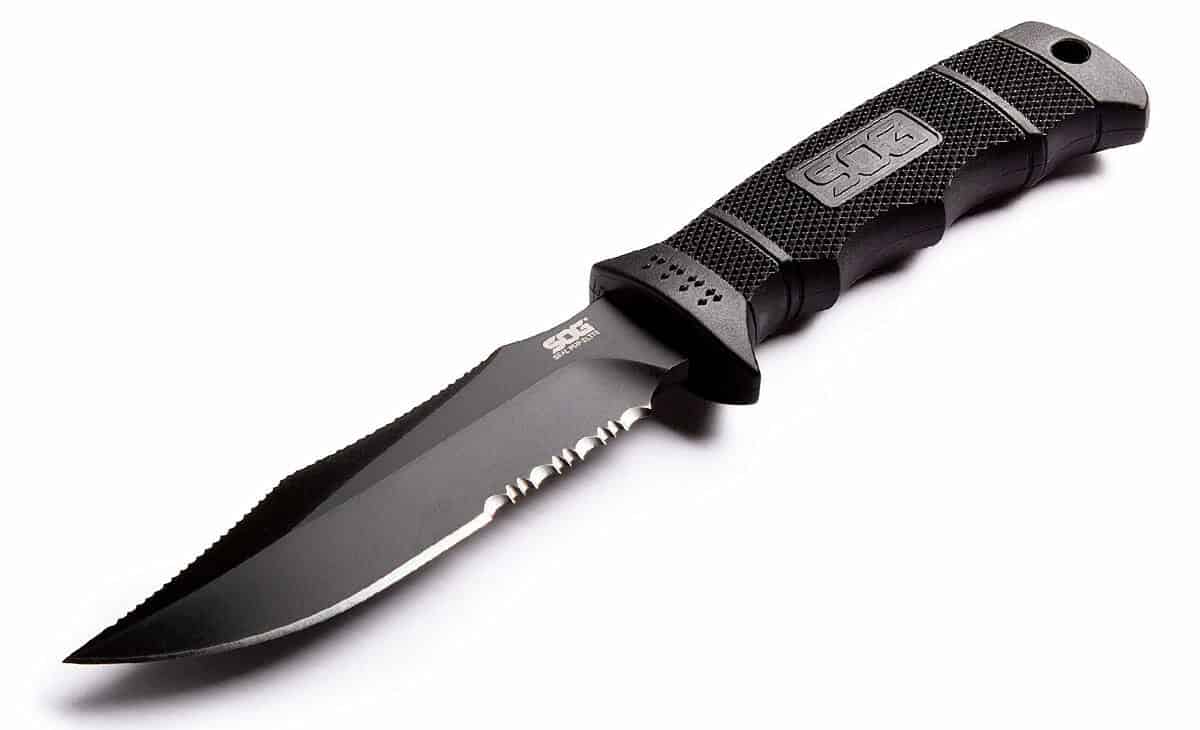
| Overall Length: | 9.5″ |
| Blade Length: | 4.85″ |
| Blade Shape: | Clip point |
| Steel: | AUS-8 |
| Handle Length: | 4.65″ |
| Handle Material: | GFN |
| Grind: | Hollow |
| Build: | Hidden tang fixed blade |
| Sheath: | MOLLE-compatible Nylon or Kydex |
Really it’s the Aus-8 steel that draws me to the Seal Pup, because I’m really not that fond of the design. It’s cool and all, it just looks like it’s trying too hard. But the knife itself is tough and sharp, and the sheath has been through a lot of trial and error design to make it easy to carry and use.
The handle also has a lot of grip to it thanks to the texturing. The finger grooves aren’t my favorite thing, but they do help some with grip retention even if they make the knife as a whole feel less nimble. Overall, the thing is tough and sharp, and a MOLLE sheath gives you a lot of carry options.
SOG Bowie 2.0
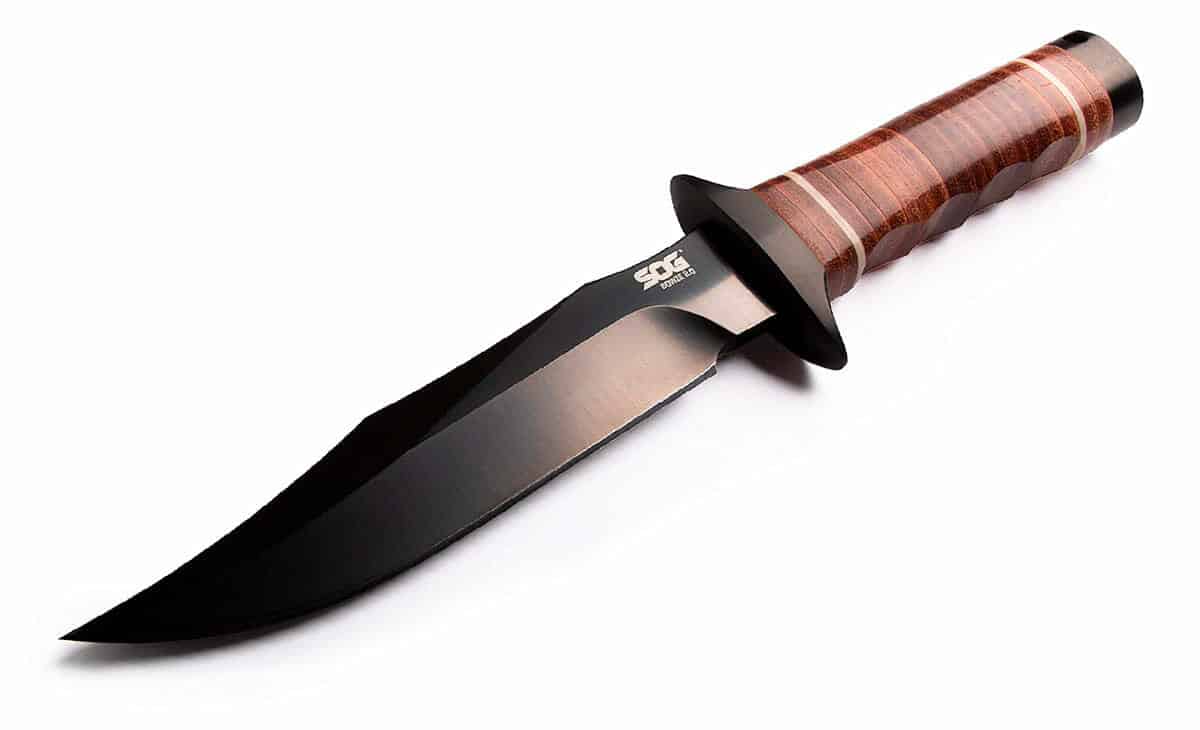
| Overall Length: | 11.0″ |
| Blade Length: | 6.4″ |
| Blade Shape: | Clip point |
| Steel: | AUS-8 |
| Handle Length: | 5.4″ |
| Handle Material: | Leather |
| Grind: | Hollow |
| Build: | Full tang fixed blade |
| Sheath: | Leather |
The updated version of the war-tested SOG Bowie is a pretty damn good knife, but for the price it better be. I think their intention was more survival than tactical, but the strong clip point and generous hand guards give it plenty of expanded uses. That’s one of the perks of staying pretty true to the Bowie knife form.
The stacked ring leather handle is probably what I like best about this design, though. It’s a comfortable style that I wish more designs had. SOG has packed this one with some kind of resin to make it more resistant to the environment, so it doesn’t quite have that same soft leather feeling to it, but it will be easier to clean.
Spartan Blades
| Pros: When they say “knives with intent”, they mean it. |
| Cons: Usually pretty pricey. |
The founders Mark Carey and Curtis Iovito said they started Spartan Blades to make “knives with intent”. While they don’t exclusively make tactical knives, that is a very helpful mentality to have when they do, and their varied pasts in the Green Berets seems to serve as a good source of practical inspiration for them.
The company has gone through some changes over the last few years, mainly that they now make some of their knives through Ka Bar. Many of their more affordable options come out of the Ka Bar factory, and so far it seems to be a great fit, if the new rounds of knives are any indication.
Spartan Alala
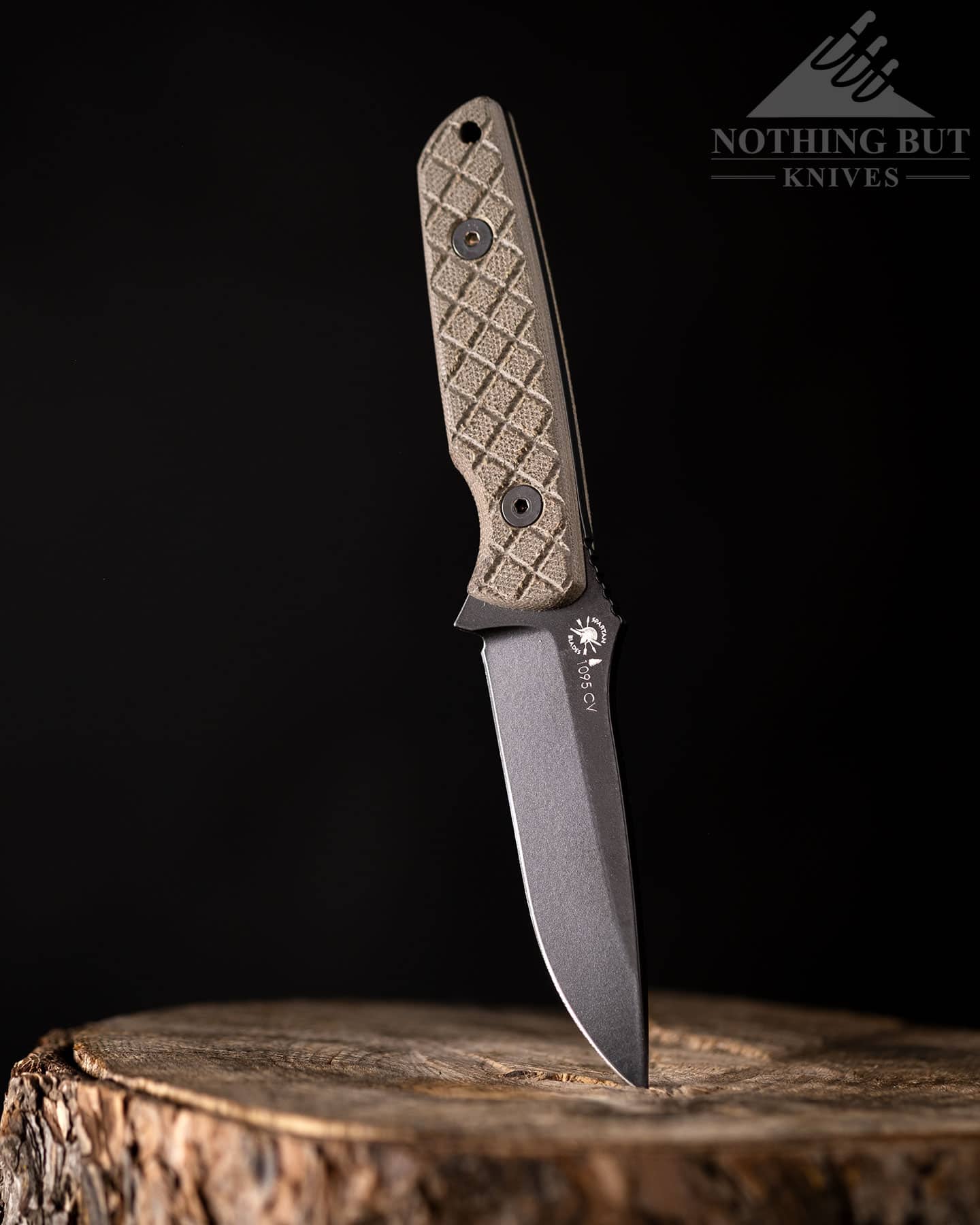
| Overall Length: | 7.87” |
| Blade Length: | 3.75” |
| Blade Shape: | Drop point |
| Steel: | 1095 Cro-Van |
| Handle Length: | 4.0” |
| Handle Material: | Micarta |
| Grind: | Flat |
| Build: | Fixed blade |
| Carry type: | Polymer sheath with snapping loops |
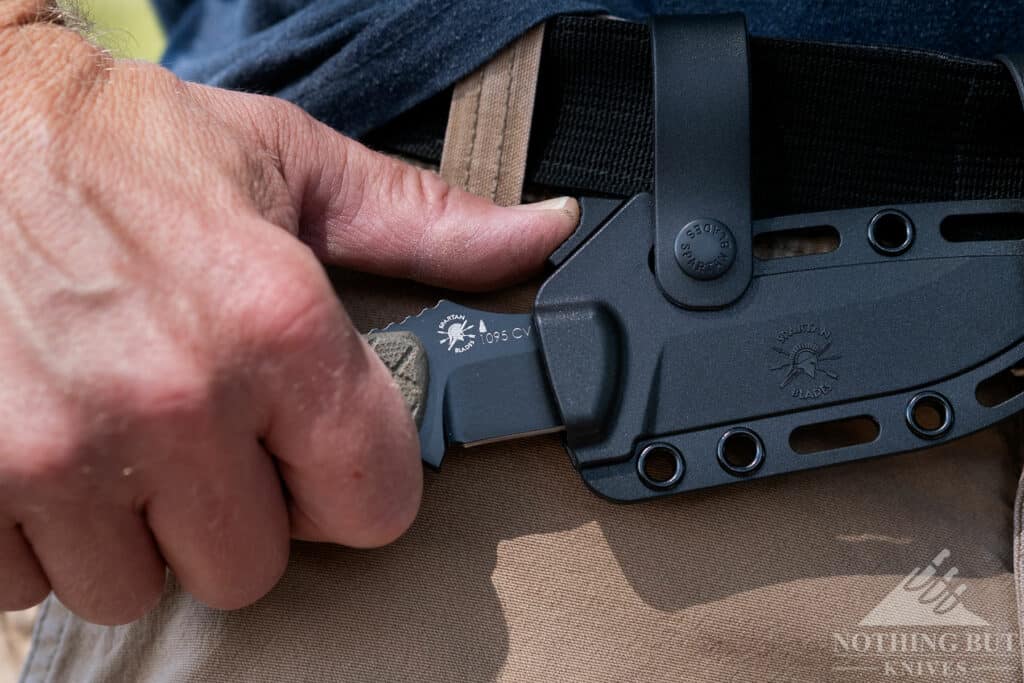
Tough and comfortable is a winning combination for any knife, but the Alala has that latent feeling of rugged functionality that I haven’t felt in many knives since the Buck GCK. It’s light and well balanced, the Micarta scales are surprisingly hard and heavily textured, they put big screws in the middle that are easy to remove if you want to switch out the scales, and the blade is a deceptively simply but effective drop point made of Ka Bar’s 1095 Cro Van. It’s a lot of different things made just right to make this thing feel like it’s more than the sum.
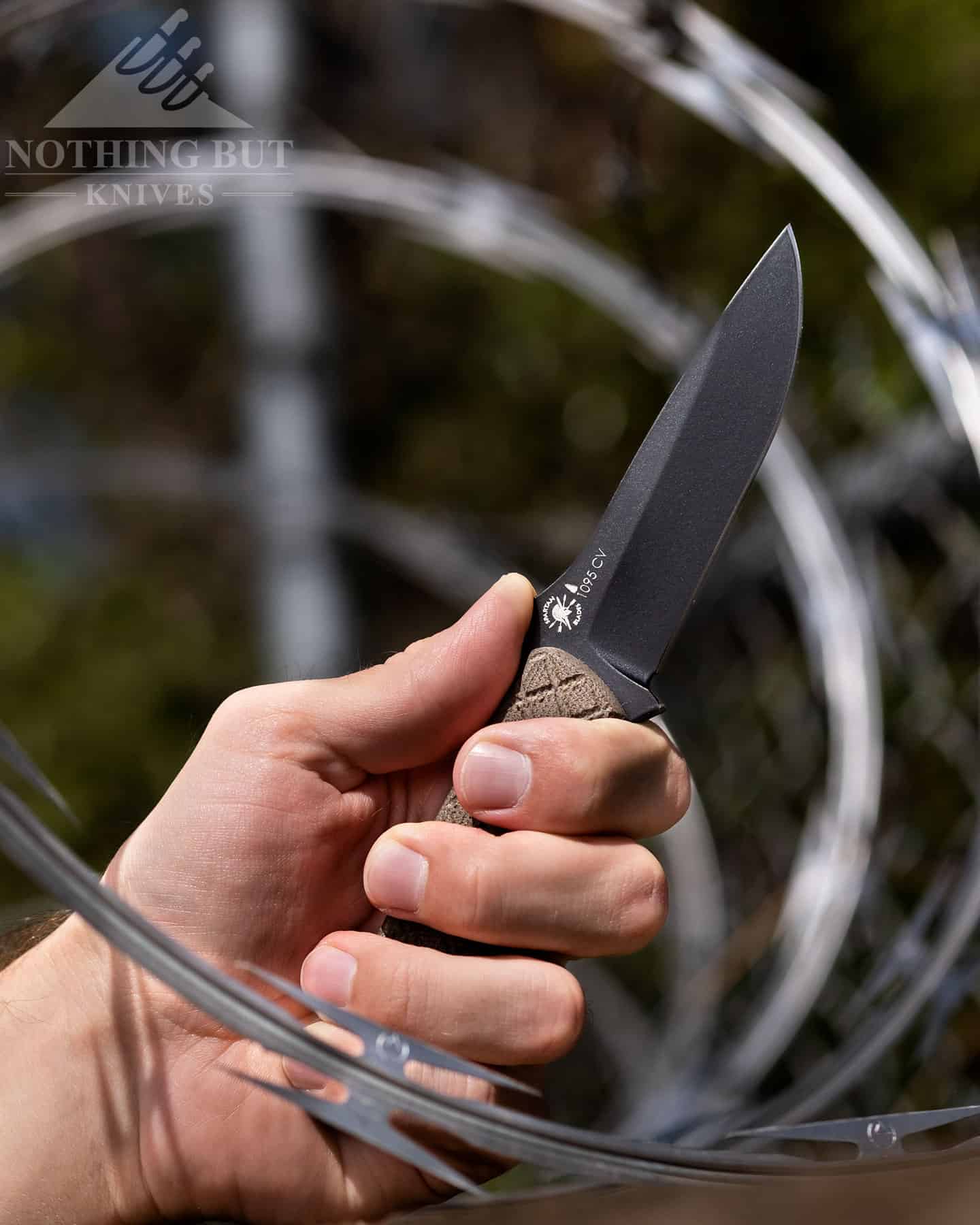
As usual, the sheath is the real star here, because they’ve put an active retention thumb lever on it.
When you take the knife out, just push the lever up, and then you know when you’ve put the knife safely back in its sheath by the click of the lever setting back into place. The whole process is super smooth. They did a great job of placing the lever in relation to the handle just right so that activating it feels really natural.
If you want to learn more about this tough tactical fixed blade check out our review of the Spartan Blades Alala.
Spyderco
| Pros: High-grade materials and manufacturing, purpose-built |
| Cons: Very high price tag, often hard but not tough |
Spyderco likes to be weird, and for the most part that doesn’t lend itself to good tactical design, but when they hit the target they hit it right in the center. They do have a Bowie that I was tempted to add here, but it’s expensive to the point of becoming a show piece.
No doubt it works great as a tactical survival, but who wants to do anything dirty with a $400 blade?
Spyderco Military
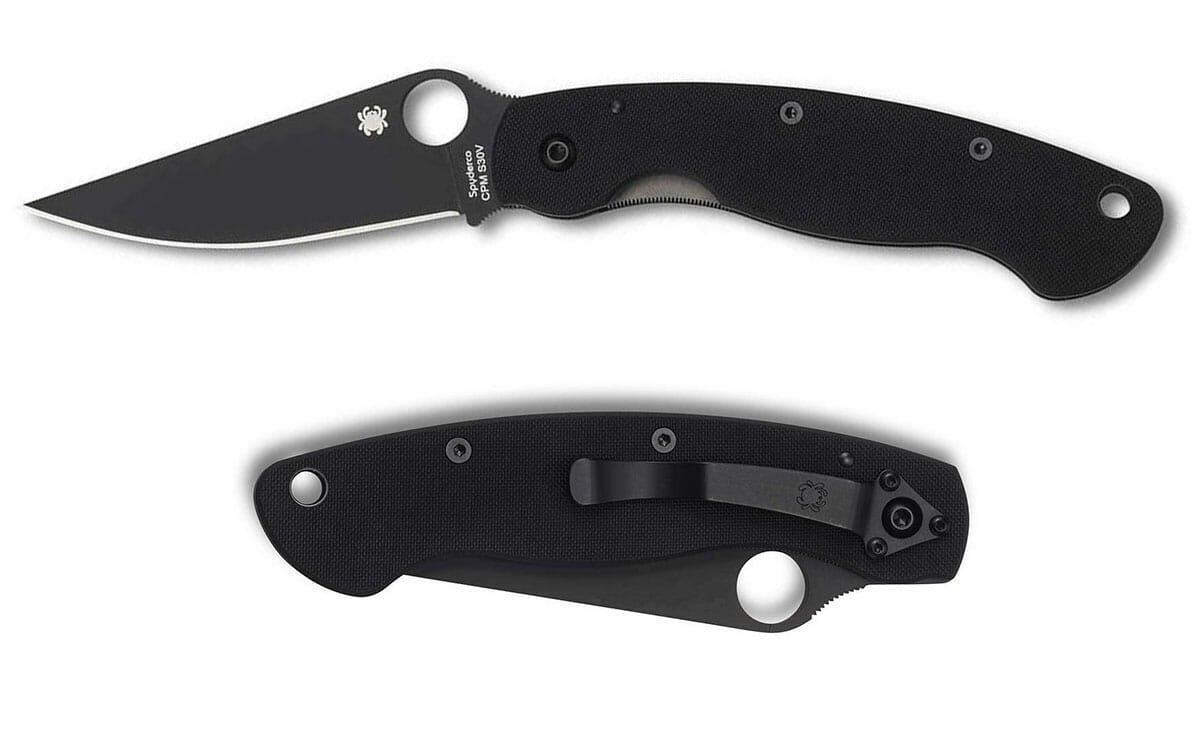
| Overall Length: | 9.5″ |
| Blade Length: | 4.0″ |
| Blade Shape: | Clip point |
| Steel: | CPM-S30V |
| Handle Length: | 5.5″ |
| Handle Material: | G-10 |
| Grind: | Flat |
| Build: | Liner-lock folder |
| Carry System: | Tip-up clip |
Supposedly built with military deployment in mind, the Spyderco Military (note: not the Paramilitary) is light and tough and sharp without most of the fantastical whims Spydero designers often indulge in. It’s built for emergencies, but not necessarily fighting emergencies.
It’s contoured to keep the knife from slipping along the hand in aggressive motions, and the long blade and fine edge make it a pretty scary thing to be faced with so it’s definitely nice to have in a pinch. It just shouldn’t be your first choice seeing as it’s a liner lock and using a pretty hard steel. It will stand up to a long bout of extreme weather, though, and the edge isn’t going anywhere anytime soon.
Spyderco Jumpmaster 2
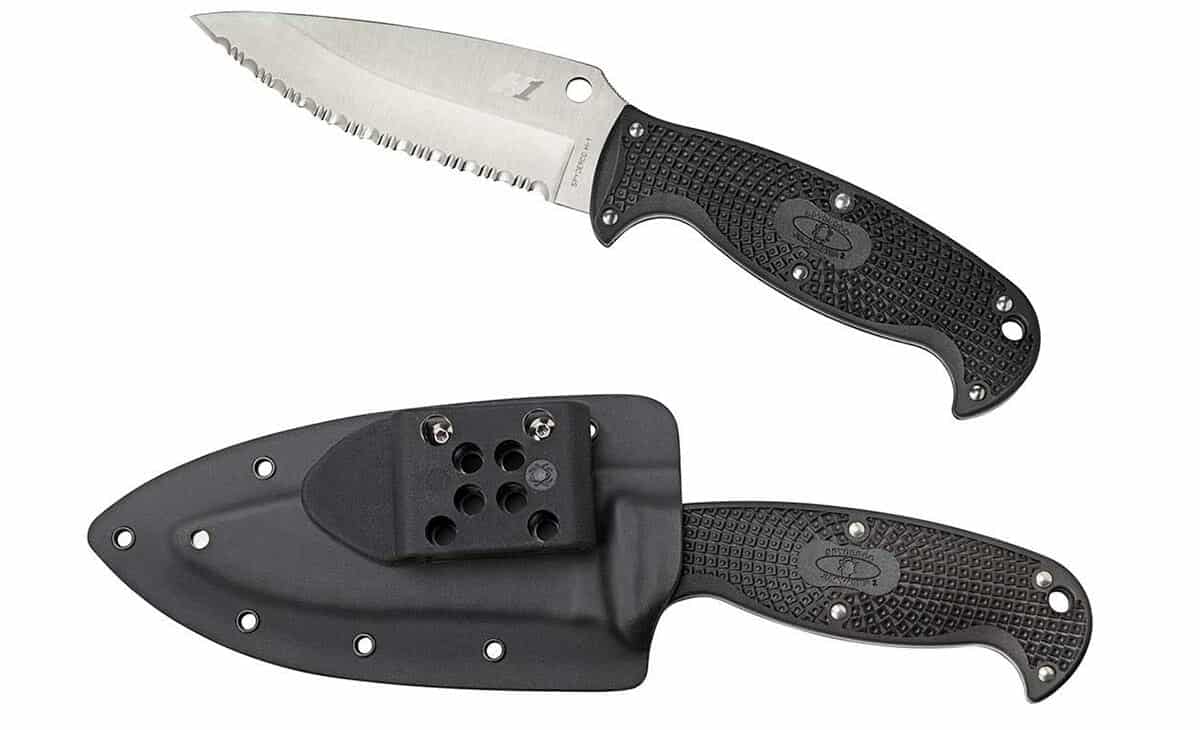
| Overall Length: | 9.33″ |
| Blade Length: | 4.49″ |
| Blade Shape: | Drop point |
| Steel: | H1 |
| Handle Length: | 4.84″ |
| Handle Material: | FRN |
| Grind: | Flat w/ full serration |
| Build: | Hidden tang fixed blade |
| Sheath: | Polymer |
This knife was designed for paratroopers, so it’s meant to be carried light and easy and mostly for cutting rope. As such, it’s more of a search and rescue knife than anything, but as it’s heavily skeletonized and has the rarely-seen H1 steel it’s pure bred for surviving extreme elements for long periods of time.
I actually thought it was meant to be a diving knife when I first saw it, but I don’t think the original intent of the design changes its usefulness in the setting.
Spyderco Ronin 2
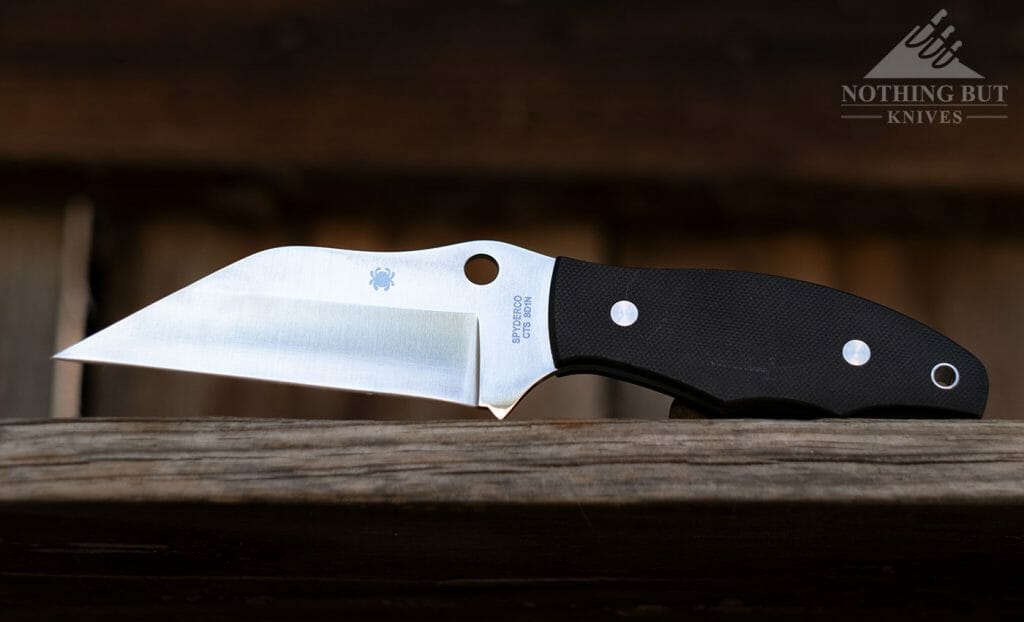
| Overall Length: | 7.875″ |
| Blade Length: | 4.125″ |
| Blade Shape: | Wharncliffe |
| Steel: | CTS-BD1 |
| Handle Length: | 3.75″ |
| Handle Material: | G-10 |
| Grind: | Hollow |
| Build: | Full tang fixed blade |
| Sheath: | Boltaron |
This is one of Michael Janich’s many tactical designs for Spyderco. He’s partial to the wharncliffe blade because he believes it cuts better at speed and provides more comfortable posture for the hand that results in more precise striking.
Which is to say, this is very much a combat-oriented design, but it’s geared more toward neutralizing limbs than puncturing.
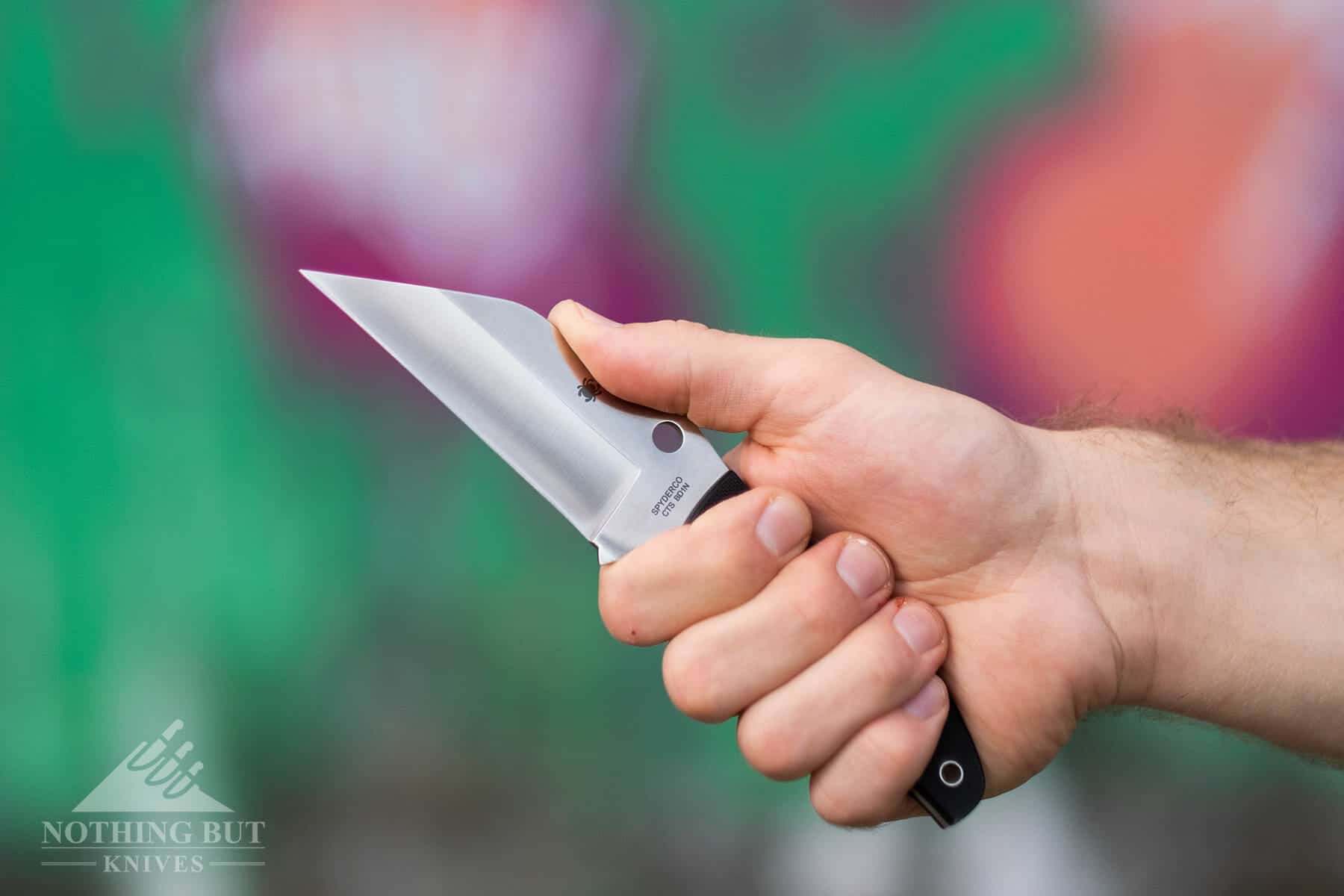
Whatever anyone might think about the combat philosophy behind this knife, I can tell you with a high degree of assurance that it cuts everything like butter. It’s not exactly the most comfortable knife in the world, but the Ronin has a lot of upside as far as indexing the blade for cuts and drawing quickly.
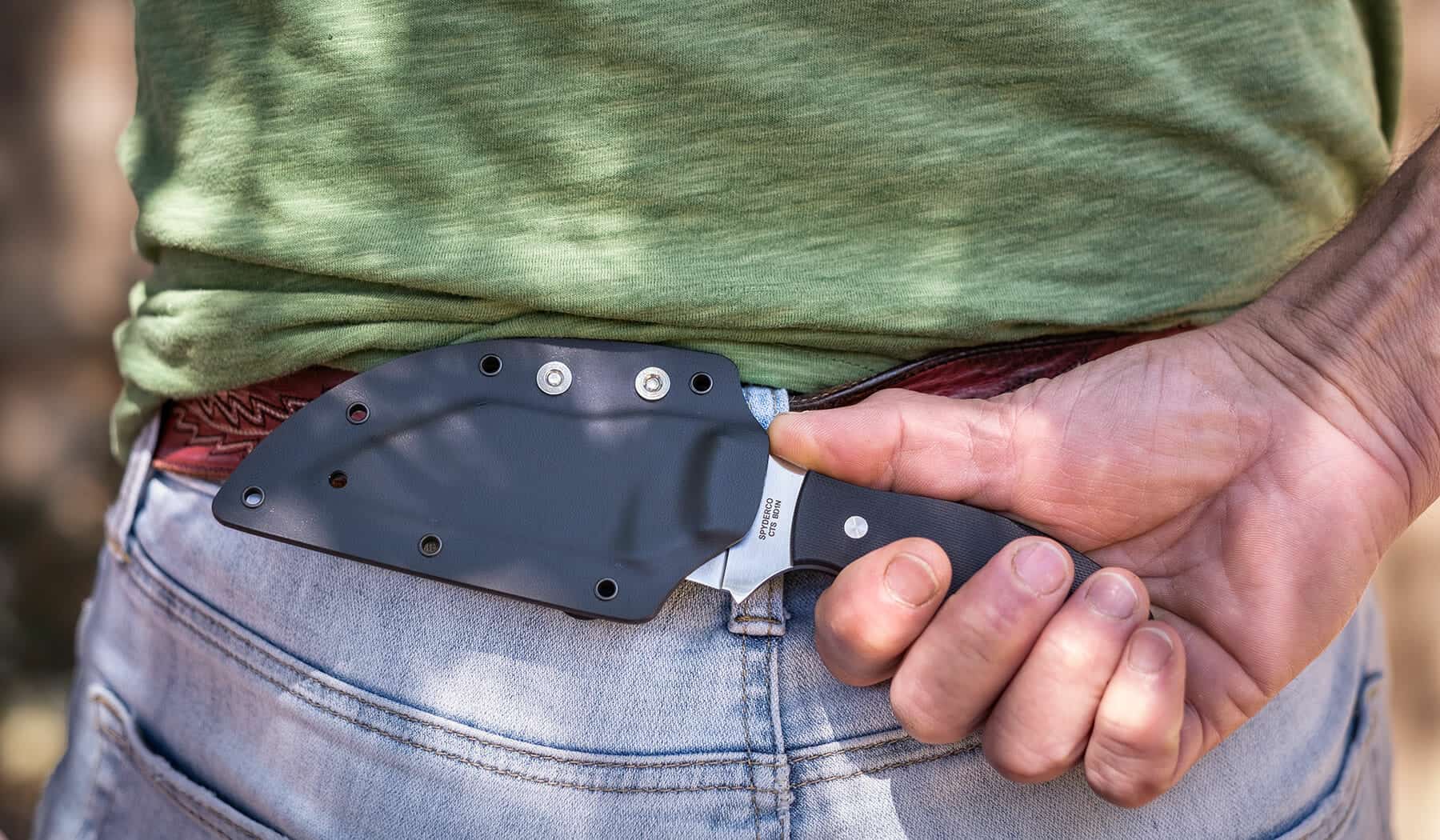
Check out our full review of the Ronin 2 if you want to read more and see pictures of us tactically cutting water bottles in half with it.

Thanks for this article with pictures. Very useful. Do you have recommendations for best OTF knives?
Knives like the Microtech Ultratech and the Protech Dark Angel seem to the be the current gold standard. Both those companies make pretty good automatics in general. I’ve also heard a lot of good things about the Benchmade Infidel.
I’ve never really been into autos, though, so I haven’t handled many personally.